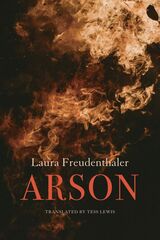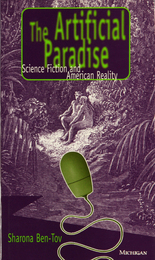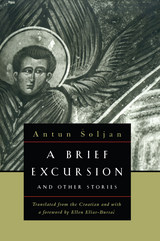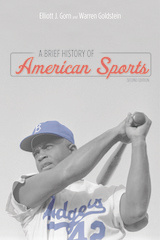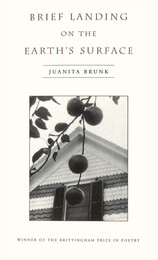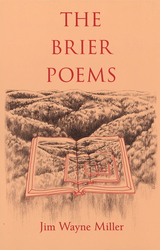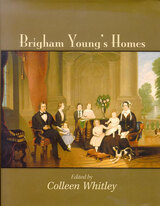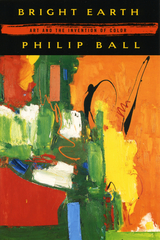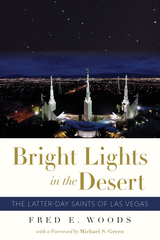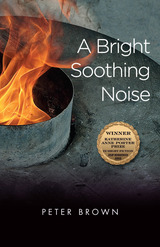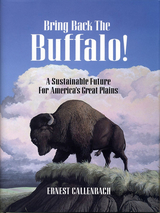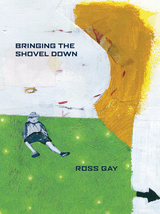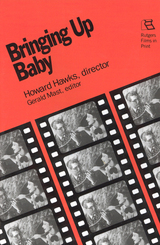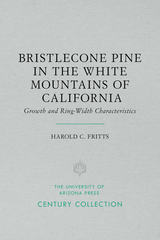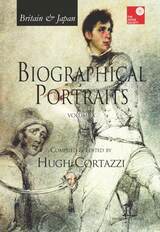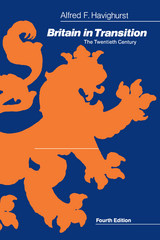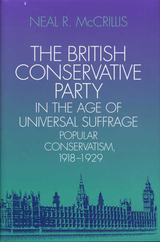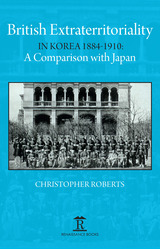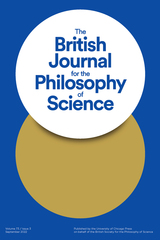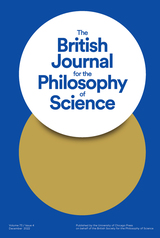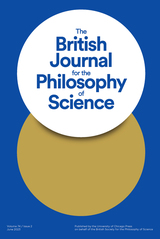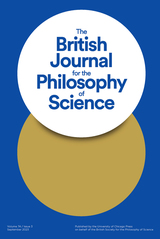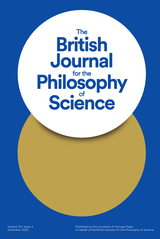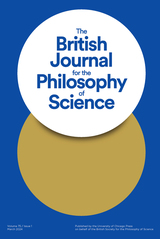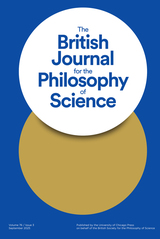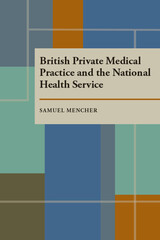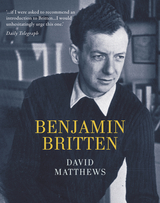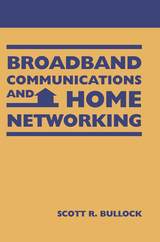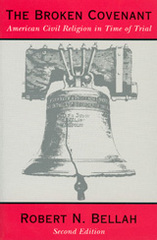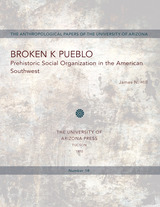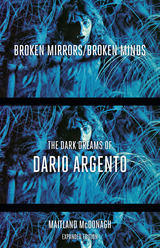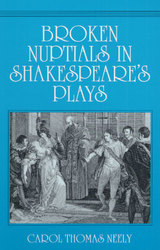 A Brief Alphabet of Torture: Stories
Vi Khi Nao
University of Alabama Press, 2017 Winner of FC2’s Ronald Sukenick Innovative Fiction Prize
An unflinching and riveting meditation on the pain that attends every facet of existence—love and sacrifice and intimacy and beauty—a biography of torture.
Like all of Vi Khi Nao’s acclaimed and award-winning work, A Brief Alphabet of Torture bleeds across many modes and genres—poetry, essay, fiction, drama—and itself almost constitutes a novel of a different kind. Each tale captures the emotional, physical, psychological, political, and artistic concerns that pervade life like breath and which, even when very beautiful, are filled with pain.
These stories are all facets of Nao’s imagination that define the way she views creation, sexuality, violence, and the role of life in an ontological system that relies heavily on cultural, social, and artistic duress. Some stories like “Winter Rose” and “I Love You Me Neither” rise above the boundaries of pain to places of beauty and grace and love, where pain has no place, but make clear how rare such moments appear in life.
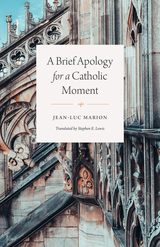 A Brief Apology for a Catholic Moment
Jean-Luc Marion
University of Chicago Press, 2021 A timely new work by one of France’s premier philosophers, A Brief Apology for a Catholic Moment offers insight into what “catholic” truly means. In this short, accessible book, Jean-Luc Marion braids the sense of catholic as all-embracing and universal into conversation about what it is to be Catholic in the present moment. A Brief Apology for a Catholic Moment tackles complex issues surrounding church-state separation and addresses a larger Catholic audience that transcends national boundaries, social identities, and linguistic differences. Marion insists that Catholic universalism, with its core of communion and community, is not an outmoded worldview, but rather an outlook that has the potential to counter the positivist rationality and nihilism at the core of our current political moment, and can help us address questions surrounding liberalism and religion and what is often presented as tension between “Islam and the West.” As an inviting and sophisticated Catholic take on current political and social realities—realities that are not confined to France alone—A Brief Apology for a Catholic Moment is a valuable contribution to a larger conversation.
A Brief Excursion and Other Stories
Antun Soljan
Northwestern University Press, 2000 The novel A Brief Excursion anchors this collection of fiction by one of the most significant postwar Croatian writers. This novel and six stories, including many from Soljan's first book, Traitors, reveal a sensibility both comic and poignant, devoted to questions of identity and solidarity, of how the one and the many conflict and intermingle-issues that were at the center of both political and literary life for Soljan. Whether fixing up a summerhouse on the Istrian coast or confronting prejudice and the past in a tourist town, Soljan's characters are stirred to action by an undefined longing, only to find the stark landscape of self-knowledge and loss.
A Brief History of American Sports
Elliott J. Gorn and Warren Goldstein
University of Illinois Press, 2013 Elliott J. Gorn and Warren Goldstein show us where our games and pastimes came from, how they developed, and what they have meant to Americans. The great heroes of baseball and football are here, as well as the dramatic moments of boxing and basketball. Beyond this, the authors show us how sports fit into the larger contours of our past. For this new edition, the authors have updated the book to include discussion of performance-enhancing drugs; player salaries, unions, and the business of internationalizing sport; Title IX and gender in American sports; race, especially the entry of Latino and Asian athletes; and the corporatization of amateur athletics. A Brief History of American Sports reveals that from colonial times to the present, sports have been central to American culture, and a profound expression of who we are.
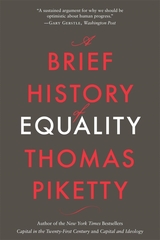 A Brief History of Equality
Thomas Piketty
Harvard University Press, 2022 A New York Times Book Review Editors’ Choice
A Public Books Best Book of the Year
“A profound and optimistic call to action and reflection. For Piketty, the arc of history is long, but it does bend toward equality. There is nothing automatic about it, however: as citizens, we must be ready to fight for it, and constantly (re)invent the myriad of institutions that will bring it about. This book is here to help.”
—Esther Duflo
“A sustained argument for why we should be optimistic about human progress…[Piketty] has laid out a plan that is smart, thoughtful, and motivated by admirable political convictions.”
—Gary Gerstle, Washington Post
“Thomas Piketty helped put inequality at the center of political debate. Now, he offers an ambitious program for addressing it…This is political economy on a grand scale, a starting point for debate about the future of progressive politics.”
—Michael J. Sandel, author of The Tyranny of Merit
“[Piketty] argues that we’re on a trajectory of greater, not less, equality and lays out his prescriptions for remedying our current corrosive wealth disparities.”
—David Marchese, New York Times Magazine
It’s easy to be pessimistic these days. We know that inequality has increased dramatically over the past two generations. Its ravages are increasingly impossible to ignore. But the grand sweep of history gives us reasons for hope. In this short and surprisingly optimistic history of human progress, the world’s leading economist of inequality shows that over the centuries we have been moving, fitfully and inconsistently but inexorably, toward greater equality.
Thomas Piketty guides us through the seismic movements that have made the modern world: the birth of capitalism, the age of revolution, imperialism, slavery, two world wars, and the building of the welfare state. He shows that through it all, societies have moved toward a more just distribution of income and assets, reducing racial and gender inequalities and offering greater access to health care, education, and the rights of citizenship. To keep moving, he argues, we need to commit to legal, social, fiscal, and educational systems that can make equality a lasting reality, while resisting the temptations of cultural separatism. At stake is the quality of life for billions of people. We know we can do better. But do we dare?
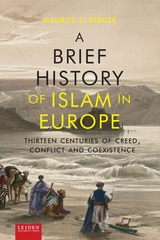 A Brief History of Islam in Europe: Thirteen Centuries of Creed, Conflict and Coexistence
Maurits S. Berger
Leiden University Press, 2014 The relationship between Europe and Islam has been complicated, if not troubled, throughout the thirteen centuries since Muslims first began playing a part in European history. This volume offers a compact, yet comprehensive look at the entire history of the interaction of Islam and Eureopean culture, religion, and politics.
Maurits S. Berger focuses in particular on the transformations that the figure of the Muslim and the image of Islam have undergone in the European mind. Conqueror, Antichrist, scholar, benign ruler, corsair, tradesman, fellow citizen—the Muslim has been all of those and more, and even today, as Muslims make up a substantial portion of Europe’s citizenry, they remain all too often a source of undeserved anxiety for ordinary people and politicians alike. Through Berger’s clear prose and incisive analysis, the story of Islam and Europe is seen as one of interaction and mutual influence rather than perpetual antagonism.
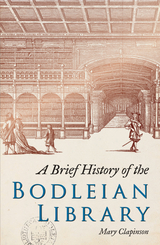 A Brief History of the Bodleian Library
Mary Clapinson
Bodleian Library Publishing, 2015 The University of Oxford’s Bodleian Library has become one of the most celebrated libraries in the world, boasting a collection of nearly twelve million books and manuscripts and a fascinating history that spans more than four hundred years.
A Brief History of the Bodleian Library takes readers through the Library’s history, from its founding in 1602 by Sir Thomas Bodley to the present day. Along the way, the book traces the development of the Library’s incomparable collection, complete with details that reveal the eccentricities of those who have helped shape it, including Bodley himself, who conceived of the Library as a “republic of the learned,” and King George VI, who inadvertently delayed the opening of the New Bodleian in 1946 when he broke the key in the lock. Covering the major moments in the Library’s history and with a great many fun facts—How did the Library come to own not one of Shakespeare’s First Folios but two?—the book also apprises readers of its present concerns, including the building of individual subject libraries across Oxford, the use of underground passages, and the perennial search for more space.
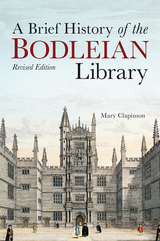 A Brief History of the Bodleian Library
Mary Clapinson
Bodleian Library Publishing, 2020 How did a library founded over four hundred years ago grow to become the world-renowned institution it is today, home to over thirteen million items? From its foundation by Sir Thomas Bodley in 1598 to the opening of the Weston Library in 2015, this illustrated account shows how the Library’s history has been involved with the British monarchy and political events throughout the centuries. The history of the Library is also a history of collectors and collections, and this book traces the story of major donations and purchases, making use of the Library’s own substantial archives to show how it came to house key items such as early confirmations of the Magna Carta, Shakespeare’s First Folio, and the manuscript of Jane Austen’s earliest writings, among many others.
This revised edition brings the history of the Bodleian Library up to the present moment. Beautifully illustrated with prints, portraits, manuscripts, and archival material, this book is essential reading for anyone interested in the history of libraries and collections.
A Brief History of the Harvard University Cyclotrons
Richard Wilson
Harvard University Press, 2004 In 1937, Harvard University built its first cyclotron, which was subsequently requisitioned by the U.S. Army and taken to Los Alamos in 1943. The second cyclotron, one of the world's longest-running accelerators, was finished in 1949 and operated until 2002. In its first 20 years, the cyclotron's primary use was for nuclear physics, particularly for understanding the interaction between two nucleons. During the next 30 years, the emphasis switched to treating patients with proton radiotherapy. A total of 9,115 patients were treated by this method and the treatment has been copied all over the world. This book describes the work of the Harvard cyclotron during its 50 years of operation and includes references to about 500 publications and 40 student theses from the work.
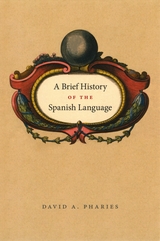 A Brief History of the Spanish Language
David A. Pharies
University of Chicago Press, 2007
Spanish is the fourth most widely spoken language in the world and a language of ever-increasing importance in the United States. In what will likely become the introduction to the history of the Spanish language, David Pharies clearly and concisely charts the evolution of Spanish from its Indo-European roots to its present form. An internationally recognized expert on the history and development of this language, Pharies brings to his subject a precise sense of what students of Spanish linguistics need to know.
After introductory chapters on what it means to study the history of a language, the concept of linguistic change, and the nature of language families, Pharies traces the development of Spanish from its Latin roots, all with the minimum amount of technical language possible. In the core sections of the book, readers are treated to an engaging and remarkably succinct presentation of the genealogy and development of the language, including accounts of the structures and peculiarities of Latin, the historical and cultural events that deeply influenced the shaping of the language, the nature of Medieval Spanish, the language myths that have become attached to Spanish, and the development of the language beyond the Iberian Peninsula, especially in the Americas. Focusing on the most important facets of the language’s evolution, this compact work makes the history of Spanish accessible to anyone with a knowledge of Spanish and a readiness to grasp basic linguistic concepts.
Available in both English and Spanish editions, A Brief History of the Spanish Language provides a truly outstanding introduction to the exciting story of one of the world’s great languages.
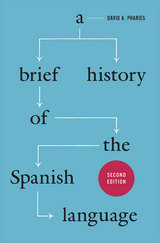 A Brief History of the Spanish Language: Second Edition
David A. Pharies
University of Chicago Press, 2015 Since its publication in 2007, A Brief History of the Spanish Language has become the leading introduction to the history of one of the world’s most widely spoken languages. Moving from the language’s Latin roots to its present-day forms, this concise book offers readers insights into the origin and evolution of Spanish, the historical and cultural changes that shaped it, and its spread around the world.
A Brief History of the Spanish Language focuses on the most important aspects of the development of the Spanish language, eschewing technical jargon in favor of straightforward explanations. Along the way, it answers many of the common questions that puzzle native speakers and non-native speakers alike, such as: Why do some regions use tú while others use vos? How did the th sound develop in Castilian? And why is it la mesa but el agua?
David A. Pharies, a world-renowned expert on the history and development of Spanish, has updated this edition with new research on all aspects of the evolution of Spanish and current demographic information. This book is perfect for anyone with a basic understanding of Spanish and a desire to further explore its roots. It also provides an ideal foundation for further study in any area of historical Spanish linguistics and early Spanish literature.
A Brief History of the Spanish Language is a grand journey of discovery, revealing in a beautifully compact format the fascinating story of the language in both Spain and Spanish America.
 A Brief Inquiry into the Meaning of Sin and Faith: With “On My Religion”
John RawlsEdited by Thomas Nagel, with commentaries by Joshua Cohen and Thomas Nagel, and by Robert Merrihew Adams
Harvard University Press, 2009 John Rawls never published anything about his own religious beliefs, but after his death two texts were discovered which shed extraordinary light on the subject. A Brief Inquiry into the Meaning of Sin and Faith is Rawls’s undergraduate senior thesis, submitted in December 1942, just before he entered the army. At that time Rawls was deeply religious; the thesis is a significant work of theological ethics, of interest both in itself and because of its relation to his mature writings. “On My Religion,” a short statement drafted in 1997, describes the history of his religious beliefs and attitudes toward religion, including his abandonment of orthodoxy during World War II.
The present volume includes these two texts, together with an Introduction by Joshua Cohen and Thomas Nagel, which discusses their relation to Rawls’s published work, and an essay by Robert Merrihew Adams, which places the thesis in its theological context.
The texts display the profound engagement with religion that forms the background of Rawls’s later views on the importance of separating religion and politics. Moreover, the moral and social convictions that the thesis expresses in religious form are related in illuminating ways to the central ideas of Rawls’s later writings. His notions of sin, faith, and community are simultaneously moral and theological, and prefigure the moral outlook found in Theory of Justice.
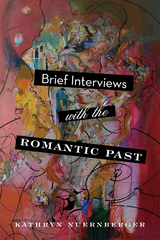 Brief Interviews with the Romantic Past
Kathryn Nuernberger
Ohio State University Press, 2017 Could Marie Antoinette’s wigs get any higher? Could the anonymous women riding in hot air balloons alone with gentlemen be any more scandalous? Does an Ozark holler hold the mouth to a lost cave with the longest, thickest vein of gold in North America? Brief Interviews with the Romantic Past is a collection of rumors, secrets, tall tales, and lies that begins at the court of Louis XV and ends in the foothills of the Ozark Mountains.
With all the astonishments of history and the intimacy of memoir, Kathryn Nuernberger’s collection juxtaposes peripheral figures from the French Revolution—the assassin, the executioner, the mistress, the spy, the son of a slave, the transgender swordfighter—with the oral histories of poachers, prophets, well witches, and ghosts of the Ozarks a century later. In essays that are equal parts historical and personal, Nuernberger brings the marvelous strangeness of the past into our present moment with wry wit and insight. Nuernberger has an eye for salvaging overlooked snapshots of human decency and moments of moral courage—the memories of which we might just want to save for later.
Brief Landing on the Earth's Surface
Juanita Brunk
University of Wisconsin Press, 1996 In Brief Landing on the Earth’s Surface, even the most ordinary moments are infused with an awareness of the lost past and a kind of prescience of the future. From one setting to another—Tidewater Virginia, rural Pennsylvania, Greece, New York City—these poems give voice to the human longing for permanence, home, and connection in the face of a constantly changing reality.
 A Brief Life of Aquinas: The Theologian in His Context
Jean-Pierre Torrell
Catholic University of America Press, 2024 Jean-Pierre Torrell, OP, who has already written the most highly-regarded contemporary two-volume introduction to the life and works of Saint Thomas, has composed a shorter book that captures the essence of the career of the Angelic Doctor for a more general audience. Torrell follows a biographical outline of the saint, although he also includes brief accounts of what the author takes to be the most important features of Aquinas's teachings.
Part biography, part travelogue, part theology, Jean-Pierre Torrell, OP’s A Brief Life of Thomas Aquinas is a multi-faceted look at the life and the writings of Saint Thomas Aquinas. Torrell’s hope is that his biography of the doctor communis intertwined with his theological examination of Aquinas’s writings will enable the reader to understand the person behind the writer and the writer behind the person. Aquinas’s life, Torrell claims, can shed light on his work with respect not only to their number, or to the varied topics he writes about, but to their content as well. It would be inaccurate to view Aquinas hiding behind a mountain of books in the cells he occupied in the various houses he inhabited around the Dominican world. He taught, he preached, he debated, he faced a number of conflicts of ideas that were not of his own making, but out of which would come some of his best-known writings. Torrell’s unique approach makes accessible one of the greatest minds of our tradition and the richness of the legacy he left the Church.
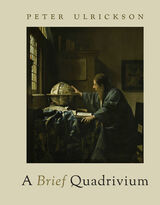 A Brief Quadrivium
Peter Ulrickson
Catholic University of America Press, 2023 Mathematics holds a central place in the traditional liberal arts. The four mathematical disciplines of the quadrivium-arithmetic, geometry, music, and astronomy-reveal their enduring significance in this work, which offers the first unified, textbook treatment of these four subjects. Drawing on fundamental sources including Euclid, Boethius, and Ptolemy, this presentation respects the proper character of each discipline while revealing the relations among these liberal arts, as well as their connections to later mathematical and scientific developments.
This book makes the quadrivium newly accessible in a number of ways. First, the careful choice of material from ancient sources means that students receive a faithful, integral impression of the classical quadrivium without being burdened or confused by an unwieldy mass of scattered results. Second, the terminology and symbols that are used convey the real insights of older mathematical approaches without introducing needless archaism. Finally, and perhaps most importantly, the book is filled with hundreds of exercises. Mathematics must be learned actively, and the exercises structured to complement the text, and proportioned to the powers of a learner to offer a clear path by which students make quadrivial knowledge their own.
Many readers can profit from this introduction to the quadrivium. Students in high school will acquire a sense of the nature of mathematical proof and become confident in using mathematical language. College students can discover that mathematics is more than procedure, while also gaining insight into an intellectual current that influenced authors they are already reading: authors such as Plato, Aristotle, Augustine, Thomas Aquinas, and Dante. All will find a practical way to grasp a body of knowledge that, if long neglected, is never out of date.
The Brier Poems
Jim Wayne Miller
Ohio University Press, 1997 Published in 1997 by Gnomon Press. Jim Wayne Miller’s The Brier Poems, published posthumously, is a selection of poetry from The Mountains Have Come Closer (where the Brier figure first emerged) and Brier, His Book, along with additional poems not published in previous volumes. It celebrates the Appalachian region and its people through “The Brier,” the enlightened Appalachian who laments what is happening to the world that nurtured him. Through vivid imagery and rich language, Miller explores themes of identity and tradition and the connection between the land and its inhabitants. The poems capture the spirit and resilience of Appalachian culture, blending personal reflection with social commentary. Miller’s work highlights the beauty and complexity of life in the mountains, offering a voice to the often-overlooked experiences of rural Appalachia.
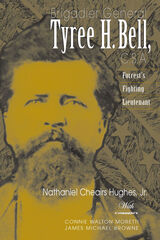 Brigadier General Tyree H. Bell, C.S.A.: Forrest's Fighting Lieutenant
Nathaniel Cheairs Hughes
University of Tennessee Press, 2004
For two years, Tyree H. Bell (1814-1902) served as one of Nathan Bedford Forrest’s most trusted lieutenants in the Civil War. Forrest’s legendary exploits and charisma often eclipsed the contributions of his subordinates, as his story was told and retold by admiring soldiers and historians. Bell, however, stood out from others who served with Forrest. He was neither a professional soldier nor an attorney-politician; he was, instead, a farmer with no previous military experience, a model of the citizen-soldier.
Using Bell’s unpublished autobiography and other primary materials, including Confederate letters, diaries, and official correspondence, author Nathaniel Cheairs Hughes, Jr., worked with Connie Walton Moretti and Jim Browne, two of Bell’s great-great-great grandchildren, to augment Bell’s manuscript and to write the first full-length biography of this significant Confederate soldier.
Born in Kentucky, Bell grew up on a Tennessee plantation and became a farmer and stock raiser. At the outbreak of war, his neighbors asked him to be captain of a company of volunteers they were raising for the Provisional Army of Tennessee. In 1861, he entered service with the Twelfth Tennessee Infantry and quickly became its lieutenant colonel. He distinguished himself in the battle of Belmont, where he commanded the regiment, and continued his steady performance at Shiloh.
By the following year he was promoted to colonel and led the Twelfth Tennessee in the Kentucky campaign, rejoining Kirby Smith’s army for battles at Cumberland Gap, Richmond, and Perryville. After obtaining permission to leave the Army of Tennessee, he became a brigade commander under Forrest. Bell lad half of Forrest’s forces in the attack at Fort Pillow as well as in numerous other battles and expeditions. After the war, Bell returned to Sumner County to resume farming and eventually moved his family to California.
In addition to giving insight into the man whose courage and leadership earned him the nickname “Forrest’s Right Arm,” the authors explore Bell’s early years in Tennessee and his adventurous postwar career in business and land speculation. This portrait of Bell is one of an unsung leader who risked much to fight for the Confederacy.
Nathaniel Cheairs Hughes, Jr., is the author of a number of books, including The Pride of the Confederate Artillery: The Washington Artillery in the Army of Tennessee, and General William J. Hardee, C.S.A He is also coauthor of Theodore O’Hara: Poet-Soldier of the Old South and coeditor of Military Memoirs of Brigadier General William Passmore Carlin, U.S.A. He lives in Chattanooga, Tennessee.
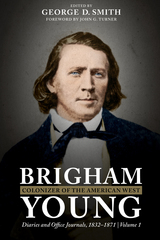 Brigham Young, Colonizer of the American West: Diaries and Office Journals, 1832–1871
George D. Smith
Signature Books, 2019 Examining Brigham Young’s legacy requires an understanding of his raw ambition and religious zeal. A formidable leader in both his church and country, Young’s abilities coincided with the colonizing zeitgeist of nineteenth-century America.
Thus, by 1877, some 400 Mormon settlements spanned the western frontier from Salt Lake City to outposts in Idaho, Nevada, Arizona, Wyoming, and California. As prophet of the LDS Church and governor of the proposed State of Deseret, Young led several campaigns for Utah statehood while defending polygamy and local sovereignty. His skillful and authoritarian leadership led historian Bernard de Voto to classify him as an “American genius,” responsible for turning Joseph Smith’s visions “into the seed of life.”
Young’s diaries and journals reveal a man dedicated to his church, defensive of his spiritual and temporal claims to authority, and determined to create a modern Zion within the Utah desert. Editor George D. Smith’s careful organization and annotation of Young’s personal writings provide insights into the mind of Mormonism’s dynamic church leader and frontier statesman.
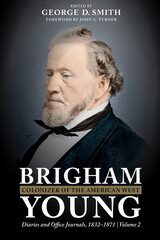 Brigham Young, Colonizer of the American West: Diaries and Office Journals, 1832–1871: Volume 2
George D. Smith
Signature Books, 2021 Examining Brigham Young’s legacy requires an understanding of his raw ambition and religious zeal. A formidable leader in both his church and country, Young’s abilities coincided with the colonizing zeitgeist of nineteenth-century America.
Thus, by 1877, some 400 Mormon settlements spanned the western frontier from Salt Lake City to outposts in Idaho, Nevada, Arizona, Wyoming, and California. As prophet of the LDS Church and governor of the proposed State of Deseret, Young led several campaigns for Utah statehood while defending polygamy and local sovereignty. His skillful and authoritarian leadership led historian Bernard de Voto to classify him as an “American genius,” responsible for turning Joseph Smith’s visions “into the seed of life.”
Young’s diaries and journals reveal a man dedicated to his church, defensive of his spiritual and temporal claims to authority, and determined to create a modern Zion within the Utah desert. Editor George D. Smith’s careful organization and annotation of Young’s personal writings provide insights into the mind of Mormonism’s dynamic church leader and frontier statesman.
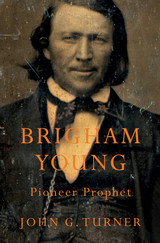 Brigham Young: Pioneer Prophet
John G. Turner
Harvard University Press, 2012 Brigham Young was a rough-hewn craftsman from New York whose impoverished and obscure life was electrified by the Mormon faith. He trudged around the United States and England to gain converts for Mormonism, spoke in spiritual tongues, married more than fifty women, and eventually transformed a barren desert into his vision of the Kingdom of God. While previous accounts of his life have been distorted by hagiography or polemical exposé, John Turner provides a fully realized portrait of a colossal figure in American religion, politics, and westward expansion.
After the 1844 murder of Mormon founder Joseph Smith, Young gathered those Latter-day Saints who would follow him and led them over the Rocky Mountains. In Utah, he styled himself after the patriarchs, judges, and prophets of ancient Israel. As charismatic as he was autocratic, he was viewed by his followers as an indispensable protector and by his opponents as a theocratic, treasonous heretic.
Under his fiery tutelage, the Church of Jesus Christ of Latter-day Saints defended plural marriage, restricted the place of African Americans within the church, fought the U.S. Army in 1857, and obstructed federal efforts to prosecute perpetrators of the Mountain Meadows Massacre. At the same time, Young's tenacity and faith brought tens of thousands of Mormons to the American West, imbued their everyday lives with sacred purpose, and sustained his church against adversity. Turner reveals the complexity of this spiritual prophet, whose commitment made a deep imprint on his church and the American Mountain West.
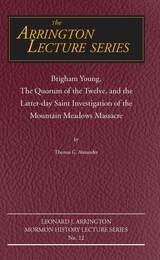 Brigham Young, the Quorum of the Twelve, and the Latter-Day Saint Investigation of the Mountain Meadows Massacre: Arrington Lecture No. Twelve
Thomas G. Alexander
Utah State University Press, 2007 On September 11, 1857, a wagon train of emigrants passing through the Utah Territory on their way to California were massacred at Mountain Meadows. Although today’s historians agree that the principal perpetrators were members of the Mormon militia in southern Utah, how much the central Mormon leadership, especially Brigham Young at the top, knew about the massacre, when and how they learned about it, and the extent of a cover up afterward are still matters of controversy and debate. In this 12th volume of the Arrington Lecture Series, Thomas Alexander (Lemuel Redd Professor of Western American History, Emeritus, at Brigham Young University), asserts that Brigham Young and the LDS Church’s governing Quorum of Twelve made timely and diligent efforts to investigate the massacre and encouraged legal proceedings but were hindered by federal territorial officials and lied to by massacre participant John D. Lee, preventing Young from learning the full truth for many years.
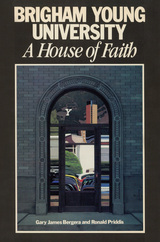 Brigham Young University: A House of Faith
Gary James Bergera
Signature Books, 1985 The purpose of Brigham Young University: A House of Faith is to outline the struggle the Mormon church has encountered in trying to blend academics and faith and in reconciling church standards with norms at other American universites, not to produce a comprehensive, chronological history of BYU. Instead, a selective approach has been taken–a thematic introduction to events, incidents, and statements, both published and private, in selected areas where tensions between scholarship and faith, freedom and regimentation have been the most pronounced. Examples include the development of a religious curriculum, the honor code, the controversy surrounding organic evolution, politics, student life, athletics, the arts, and faculty research. We hope that this approach will help readers appreciate the religious and intellectual dilemma facing educators and church leaders, as well as the fundamental sincerity of those involved in trying to establish academic rigor within religious parameters or to prevent moral deterioration when traditional restraints are left unchecked. Whatever the particular issue under discussion, an attempt has been made to keep the presentation balanced and impartial, yet sympathetic. While some readers may question the descriptive, largely noninterpretive approach, it is hoped that most will, through this approach, at least gain a greater understanding of the complex challenges involved in successfully integrating religion and academics.
We especially hope that Brigham Young University: A House of Faith will be of use to those who appreciate more than a cursory history of Mormonism–in this case, the Mormon concept of education–and who relish the rich fabric of pluralism. Brigham Young University has an engaging past, which, we believe, deserves more than a superficial treatment. Perhaps this book can be a springboard for more thorough investigations into other areas of the school’s past. There have been so many noteworthy accomplishments, discouraging defeats, moving religious experiences, humorous accounts of human foibles, and undocumented daily routine, that much remains in describing all that has gone into making the university founded more than a century ago by Brigham Young.
In presenting the sources cited in this work, we have followed the recommendations of the 1982 edition of The Chicago Manual of Style, with slight modifications. Readers will notice, for example, our incorporation of Chicago’s “down style” approach to capitalization. In order to facilitate future research, complete source citations are included as endnotes. To avoid a cumbersome and ultimately unworkable linking of each sentence with its corresponding source and bibliographic reference, we have instead referenced each paragraph and [p. xiii]cited sources in the endnotes section in the order in which material is presented in the paragraph indicated. Where the reader would otherwise encounter difficulty in identifying the specific source of a given piece of information, or where the source is considered especially important, it is provided in the text in an abbreviated form within parentheses.
Brigham Young's Homes
Colleen K. Whitley
Utah State University Press, 2003 This collection surveys the many houses, residences, farms, and properties of Brigham Young, leader of the Mormon pioneers, first territorial governor of Utah, and second president of the Church of Jesus Christ of Latter-day Saints. The authors discuss, in addition to the buildings themselves, what went on within their walls, looking especially at the lives of Young's plural wives and their children. Their emphasis is on Young's residences as homes, not just structures. The text is heavily illustrated with photos, drawings and maps.
 Bright College Years: Inside the American College Today
Anne Matthews
University of Chicago Press, 1998 As the price of higher education escalates and the number of Americans seeking a college degree steadily rises, it is now more important then ever to think about higher education in a different way. In Bright College Years, Anne Matthews paints a provocative yet evenhanded portrait of the American campus. With each chapter dedicated to sections of the academic year, Matthews puts students, professors, and administrators under the magnifying glass. She conducts her investigation in four-year universities all across the country, from enormous state schools like the University of Texas to specialized colleges like Cal Tech. Bright College Years is a fascinating look at the changing face of the American university that will be of interest to prospective students, their parents, and anyone interested in higher education.
"Matthews writes with sympathy and substantial understanding of the dilemmas colleges face these days."—Tara Fitzpatrick, Chicago Tribune
"A wide-ranging, well-written and lively account of contemporary academia."—Christian Wiman, Dallas Morning News
"Notable Book of the Year." New York Times
"An eye-opening, startling exposé;. . . . Matthews' energetic and well-written report provides a dismal yet concise insider portrait of college life."—Booklist
Bright Earth: Art and the Invention of Color
Philip Ball
University of Chicago Press, 2003 From Egyptian wall paintings to the Venetian Renaissance, impressionism to digital images, Philip Ball tells the fascinating story of how art, chemistry, and technology have interacted throughout the ages to render the gorgeous hues we admire on our walls and in our museums.
Finalist for the 2002 National Book Critics Circle Award.
Bright Lights in the Desert: The Latter-day Saints of Las Vegas
Fred E Woods
University of Nevada Press, 2023 Bright Lights in the Desert explores the history of how members of the Church of Jesus Christ of Latter-day Saints in Las Vegas have improved the regions’ neighborhoods, inspired educational institutions, brought integrity to the marketplace, and provided wholesome entertainment and cultural refinement. The LDS influence has helped shape the metropolitan city because of its members’ focus on family values and community service.
Woods discusses how, through their beliefs and work ethics, they have impacted the growth of the area from the time of their first efforts to establish a mission in 1855 through the present day. Bright Lights in the Desert reveals Las Vegas as more than just a tourist destination and shows the LDS community’s commitment to making it a place of deep religious faith and devotion to family.
 Bright Radical Star: Black Freedom and White Supremacy on the Hawkeye Frontier
Robert Dykstra
Harvard University Press, 1993 Bright Radical Star traces the evolution of frontier Iowa from arguably the most racist free state in the antebellum Union to one of its most outspokenly egalitarian, linking these midwesterners' extraordinary collective behavior with the psychology and sociology of race relations. Diverse personalities from a variety of political cultures—Yankees and New Yorkers, Pennsylvanians and Ohioans, Southerners from Virginia and Maryland and North Carolina, immigrant Irish, Germans, Scandinavians—illuminate this saga, which begins in 1833 with Iowa officially opened to settlement, and continues through 1880, the end of the pioneer era.
Within this half-century, the number of Iowans acknowledging the justice of black civil equality rose dramatically from a handful of obscure village evangelicals to a demonstrated majority of the Hawkeye State's political elite and electorate. How this came about is explained for the first time by Robert Dykstra, whose narrative reflects the latest precepts and methods of social, legal, constitutional, and political history.
Based largely on an exhaustive use of local resources, the book also offers cutting-edge quantitative analysis of Iowa's three great equal rights referendums, one held just before the war, one just after, and one at the close of Reconstruction. The book will appeal to American historians, especially to historians of the frontier, the Civil War era, and African-American history; sociologists and others interested in historical perspectives on race relations in America will find it both stimulating and useful.
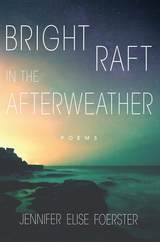 Bright Raft in the Afterweather: Poems
Jennifer Elise Foerster
University of Arizona Press, 2018 In her dazzling new book, Jennifer Elise Foerster announces a frightening new truth: “the continent is dismantling.” Bright Raft in the Afterweather travels the spheres of the past, present, future, and eternal time, exploring the fault lines that signal the break of humanity’s consciousness from the earth.
Featuring recurring characters, settings, and motifs from her previous book, Leaving Tulsa, Foerster takes the reader on a solitary journey to the edges of the continents of mind and time to discover what makes us human. Along the way, the author surveys the intersection between natural landscapes and the urban world, baring parallels to the conflicts between Native American peoples and Western colonizers, and considering how imagination and representation can both destroy and remake our worlds.
Foerster’s captivating language and evocative imagery immerse the reader in a narrative of disorientation and reintegration. Each poem blends Foerster’s refined use of language with a mythic and environmental lyricism as she explores themes of destruction, spirituality, loss, and remembrance.
In a world wrought with ecological imbalance and grief, Foerster shows how from the devastated land of our alienation there is potential to reconnect to our origins and redefine the terms by which we inhabit humanity and the earth.
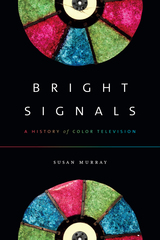 Bright Signals: A History of Color Television
Susan Murray
Duke University Press, 2018 First demonstrated in 1928, color television remained little more than a novelty for decades as the industry struggled with the considerable technical, regulatory, commercial, and cultural complications posed by the medium. Only fully adopted by all three networks in the 1960s, color television was imagined as a new way of seeing that was distinct from both monochrome television and other forms of color media. It also inspired compelling popular, scientific, and industry conversations about the use and meaning of color and its effects on emotions, vision, and desire. In Bright Signals Susan Murray traces these wide-ranging debates within and beyond the television industry, positioning the story of color television, which was replete with false starts, failure, and ingenuity, as central to the broader history of twentieth-century visual culture. In so doing, she shows how color television disrupted and reframed the very idea of television while it simultaneously revealed the tensions about technology's relationship to consumerism, human sight, and the natural world.
 Brightening Glance: Art and Life
Pat Lipsky
University of Iowa Press, 2025 For more than five decades, Pat Lipsky has been a leading figure in American color field painting. In loosely connected vignettes, this extraordinary book looks back on a life starting in 1970s SoHo: from her pioneering days juggling painting and single motherhood in a redesigned factory loft on Wooster Street; to Paris, where an enchanting friendship develops with the former director of the Louvre, Pierre Rosenberg; to her yearslong close friendship with legendary art critic Clement Greenberg; to a marvelous love affair with the charismatic art dealer Richard Bellamy. We glimpse Lipsky’s first introduction to Cézanne as a child in 1950s Brooklyn and her studies with the mythic artist Tony Smith, who would become her mentor. There is a visit with Lee Krasner at her home in Springs and another at Lipsky’s Manhattan apartment, late-night, smoke-filled loft parties, and evenings at Max’s Kansas City where Lou Reed and Nico sing in the background while rival groups of earthwork artists, pop artists, conceptual artists, and color field painters pretend to ignore each other at the bar. Along the way we experience Lipsky’s emergence at the forefront of her generation of painters.
Brightening Glance offers a stunningly self-revealing portrait of the struggles and sacrifices, joys and excitement inherent in a modern painter’s life, and captures the evergreen allure of New York’s art world between 1970 and 2010. In stripped down, elegant prose, Lipsky summons a New York that no longer exists and ponders why we love (and hate) the art world. Ultimately, it’s a story of a contemporary woman, a mother, and a painter, who dares a career in a field where only a handful of women have succeeded.
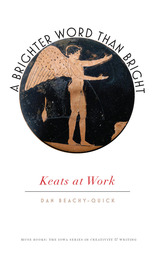 A Brighter Word Than Bright: Keats at Work
Dan Beachy-Quick
University of Iowa Press, 2013 The Romantic poet John Keats, considered by many as one of the greatest poets in the English language, has long been the subject of attention from scholars who seek to understand him and poets who seek to emulate him. Bridging these impulses, A Brighter Word Than Bright is neither historical biography nor scholarly study, but instead a biography of Keats’s poetic imagination. Here the noted poet Dan Beachy-Quick enters into Keats’s writing—both his letters and his poems—not to critique or judge, not to claim or argue, but to embrace the passion and quickness of his poetry and engage the aesthetic difficulties with which Keats grappled.
Combining a set of biographical portraits that place symbolic pressure on key moments in Keats’s life with a chronological examination of the development of Keats-as-poet through his poems and letters, Beachy-Quick explores the growth of the young man’s poetic imagination during the years of his writing life, from 1816 to 1820. A Brighter Word Than Bright aims to enter the poems and the mind that wrote them, to explore and mine Keats’s poetic concerns and ambitions. It is a mimetic tribute to the poet’s life and work, a brilliant enactment that is also a thoughtful consideration.
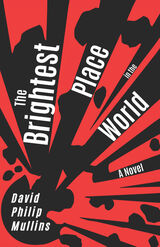 The Brightest Place in the World: A Novel
David Philip Mullins
University of Nevada Press, 2020 Winner of the 2021 Nebraska Book Award for Fiction!
Inspired by true events, The Brightest Place in the World traces the lives of four characters haunted by an industrial disaster. On an ordinary sunny morning in 2012, a series of explosions level a chemical plant on the outskirts of Las Vegas. The shock waves are felt as far away as Fremont Street. Homes and businesses suffer broken windows and caved-in roofs. Hundreds are injured, and eight employees of the plant are unaccounted for, presumed dead.
One of the missing is maintenance technician Andrew Huntley, a husband and father who is an orbital force in the novel as those who loved him grapple with his loss. Andrew’s best friend, Russell Martin—an anxiety-plagued bartender who calms his nerves with a steady inflow of weed—misses him more than he might a brother. Meanwhile Emma, Russell’s wife—a blackjack dealer at a downtown casino—tries to keep her years-long affair with Andrew hidden. Simon Addison, a manager at the plant who could have saved Andrew’s life, is afflicted by daily remorse, combined with a debilitating knowledge of his own cowardice. And then there’s Maddie, Andrew’s only child, a model high-school student whose response to the tragedy is to experiment with shoplifting and other deviant behavior.
Against the sordid backdrop of Las Vegas—and inspired by the PEPCON disaster of May 4, 1988—this engaging novel is a story of grief and regret, disloyalty and atonement, infatuation and love.
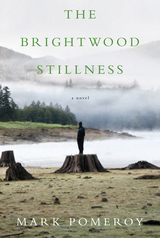 The Brightwood Stillness
Mark Pomeroy
Oregon State University Press, 2014 When Hieu Nguyen, a Portland high school teacher, is accused of sexual misconduct by two of his students, his close friend and colleague Nate Davis tries to lend support. But Nate has recently been assaulted by a former student in the school parking lot, an event that brings on not only sharp anxiety, but a final push into a long-deferred quest to find out what happened to his uncle, a drifter and a Vietnam veteran.
Meanwhile, Hieu’s family life is tested. Straining to hold form amid a police investigation into what happened in his classroom, Hieu seeks enough solitude to piece together the story of how he fled war and arrived in the US, how he came to be a father to three children in a bewildering, beloved new land—and how he’ll cope with a now uncertain future.
As their stories unfold in parallel, Hieu and Nate must confront the ways in which their pasts—each so linked to a mysterious far-off country—have left them isolated men.
With its vivid look at friendship and the challenges of cross-cultural communication, its poignant take on the legacy of Vietnam, and its Pacific Northwest setting, The Brightwood Stillness will remind readers of the best elements of A Good Scent From a Strange Mountain and Snow Falling on Cedars, while compelling them through a maze of love, betrayal, and finally, redemption.
 Brilliance in Exile: The Diaspora of Hungarian Scientists from John von Neumann to Katalin Karikó
István Hargittai
Central European University Press, 2023 By addressing the enigma of the exceptional success of Hungarian emigrant scientists and telling their life stories, Brilliance in Exile combines scholarly analysis with fascinating portrayals of uncommon personalities. István and Balazs Hargittai discuss the conditions that led to five different waves of emigration of scientists from the early twentieth century to the present. Although these exodes were driven by a broad variety of personal motivations, the attraction of an open society with inclusiveness, tolerance, and – needless to say – better circumstances for working and living, was the chief force drawing them abroad. While emigration from East to West is a general phenomenon, this book explains why and how the emigration of Hungarian scientists is distinctive. The high number of Nobel Prizes among this group is only one indicator. Multicultural tolerance, a quickly emerging, considerably Jewish, urban middle class, and a very effective secondary school system were positive legacies of the Austro-Hungarian Monarchy. Multiple generations, shaped by these conditions, suffered from the increasingly exclusionist, intolerant, antisemitic, and economically stagnating environment, and chose to go elsewhere. “I would rather have roots than wings, but if I cannot have roots, I shall use wings," explained Leo Szilard, one of the fathers of the Atom Bomb.
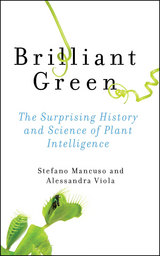 Brilliant Green: The Surprising History and Science of Plant Intelligence
Stefano Mancuso and Alessandra Viola
Island Press, 2018 Are plants intelligent? Can they solve problems, communicate, and navigate their surroundings? Or are they passive, incapable of independent action or social behavior? Philosophers and scientists have pondered these questions since ancient Greece, most often concluding that plants are unthinking and inert: they are too silent, too sedentary -- just too different from us. Yet discoveries over the past fifty years have challenged these ideas, shedding new light on the extraordinary capabilities and complex interior lives of plants.
In Brilliant Green, Stefano Mancuso, a leading scientist and founder of the field of plant neurobiology, presents a new paradigm in our understanding of the vegetal world. Combining a historical perspective with the latest in plant science, Mancuso argues that, due to cultural prejudices and human arrogance, we continue to underestimate plants. In fact, they process information, sleep, remember, and signal to one another -- showing that, far from passive machines, plants are intelligent and aware. Through a survey of plant capabilities from sight and touch to communication, Mancuso challenges our notion of intelligence, presenting a vision of plant life that is more sophisticated than most imagine.
Plants have much to teach us, from network building to innovations in robotics and man-made materials -- but only if we understand more about how they live. Part botany lesson, part manifesto, Brilliant Green is an engaging and passionate examination of the inner workings of the plant kingdom.
Financial support for the translation of this book has been provided by SEPS: Segretariato Europeo Per Le Pubblicazioni Scientifiche.
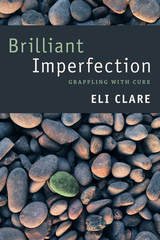 Brilliant Imperfection: Grappling with Cure
Eli Clare
Duke University Press, 2017 In Brilliant Imperfection Eli Clare uses memoir, history, and critical analysis to explore cure—the deeply held belief that body-minds considered broken need to be fixed. Cure serves many purposes. It saves lives, manipulates lives, and prioritizes some lives over others. It provides comfort, makes profits, justifies violence, and promises resolution to body-mind loss. Clare grapples with this knot of contradictions, maintaining that neither an anti-cure politics nor a pro-cure worldview can account for the messy, complex relationships we have with our body-minds. The stories he tells range widely, stretching from disability stereotypes to weight loss surgery, gender transition to skin lightening creams. At each turn, Clare weaves race, disability, sexuality, class, and gender together, insisting on the nonnegotiable value of body-mind difference. Into this mix, he adds environmental politics, thinking about ecosystem loss and restoration as a way of delving more deeply into cure. Ultimately Brilliant Imperfection reveals cure to be an ideology grounded in the twin notions of normal and natural, slippery and powerful, necessary and damaging all at the same time.
Bring Back the Buffalo!: A Sustainable Future For America's Great Plains
Ernest Callenbach
Island Press, 1996 In Bring Back the Buffalo!, Ernest Callenbach argues that the return of the bison is the key to a sustainable future for the Great Plains. Vast stretches of the region have seen a steady decline in population and are ill-suited for traditional agriculture or cattle ranching. Yet those same areas provide ideal habitat for bison. Callenbach explores the past history, present situation, and future potential of bison in North America as he examines what can and should be done to re-establish bison as a significant presence in the American landscape. He looks forward with high hopes to a time when vast herds of buffalo provide permanent sustenance to the rural inhabitants of the Great Plains and again play a central role in the balance of nature.
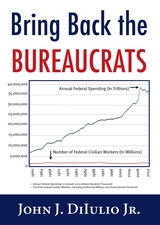 Bring Back the Bureaucrats: Why More Federal Workers Will Lead to Better (and Smaller!) Government
John DiIulio
Templeton Press, 2014 In Bring Back the Bureaucrats, John J. DiIulio Jr., one of America’s most respected political scientists and an adviser to presidents in both parties, summons the facts and statistics to show us how America’s big government works and why reforms that include adding a million more people to the federal workforce by 2035 might help to slow government’s growth while improving its performance. Starting from the underreported reality that the size of the federal workforce hasn’t increased since the early 1960s, even though the federal budget has skyrocketed. The number of federal programs has ballooned; Bring Back the Bureaucrats tells us what our elected leaders won’t: there are not enough federal workers to work for our democracy effectively. DiIulio reveals that the government in America is Leviathan by Proxy, a grotesque form of debt-financed big government that guarantees terrible government. Washington relies on state and local governments, for-profit firms, and nonprofit organizations to implement federal policies and programs. Big-city mayors, defense industry contractors, nonprofit executives, and other national proxies lobby incessantly for more federal spending. This proxy system chokes on chores such as cleaning up toxic waste sites, caring for hospitalized veterans, collecting taxes, handling plutonium, and policing more than $100 billion annually in “improper payments.” The lack of competent, well-trained federal civil servants resulted in the failed federal response to Hurricane Katrina and the troubled launch of Obamacare’s “health exchanges.” Bring Back the Bureaucrats is further distinguished by the presence of E. J. Dionne Jr. and Charles Murray, two of the most astute voices from the political left and right, respectively, who offer their candid responses to DiIulio at the end of the book.
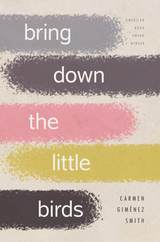 Bring Down the Little Birds: On Mothering, Art, Work, and Everything Else
Carmen Giménez Smith
University of Arizona Press, 2010 How does a contemporary woman with a career as a poet, professor, and editor experience motherhood with one small child, another soon to be born, and her own mother suddenly diagnosed with a brain tumor and Alzheimer’s? The dichotomy between life as a mother and life as an artist and professional is a major theme in modern literature because often the two seem irreconcilable. In Bring Down the Little Birds, Carmen Giménez Smith faces this seeming irreconcilability head-on, offering a powerful and necessary lyric memoir to shed light on the difficulties—and joys—of being a mother juggling work, art, raising children, pregnancy, and being a daughter to an ailing mother, and, perhaps most important, offering a rigorous and intensely imaginative contemplation on the concept of motherhood as such.
Writing in fragmented yet coherent sections, the author shares with us her interior monologue, affording the reader a uniquely honest, insightful, and deeply personal glimpse into a woman’s first and second journeys into motherhood. Giménez Smith begins Bring Down the Little Birds by detailing the relationship with her own mother, from whom her own concept of motherhood originated, a conception the author continually reevaluates and questions over the course of the book.
Combining fragments of thought, daydreams, entries from notebooks both real and imaginary, and real-life experiences, Giménez Smith interrogates everything involved in becoming and being a mother for both the first and second times. She wonders what her children will one day know about her own “secret life,” meditates on the physical effects of pregnancy, and questions the myths about, nostalgia for, and glorification of motherhood.
While Giménez Smith incorporates universal experiences of motherhood that other authors have detailed throughout literature, what separates her book from these many others is that her reflections are captured in a style that establishes an intimacy and immediacy between author and reader through which we come to know the secret life of a mother and are made to question our own conception of what motherhood really means.
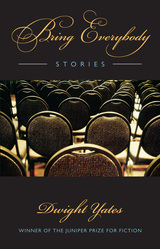 Bring Everybody: Stories
Dwight Alan Yates
University of Massachusetts Press, 2006
In this exhilarating collection of stories, Dwight Yates delivers the range of characters suggested in the title, many of them struggling to salvage situations they feel have been thrust upon them. Yet the smoking gun that accounts for the hole in the foot, is, more often than not, in the hand of the protagonist complaining of the pain.
Self-delusion courts self-destruction in these stories, but not without relief, since revelation is always possible and redemption just might come tumbling after. Though the stakes are sometimes low and the circumstances more rueful than tragic, Yates illuminates the gulf between expectation and reality with humor and compassion.
Seduction does not inevitably lead to abandonment in these tales, although that is certainly one outcome. A disastrous young marriage is another. In one case, a seducer comes to see that a chance encounter with an old flame has not closed an incomplete narrative from the past, but most likely has opened a perilous new chapter.
Other stories investigate dormant dread awakened by the hiccup of circumstance. A family man's decision to stop and assist a stalled motorist does not imperil his family as his wife fears. Yet the encounter reveals a burden of faith and guilt that continues to haunt this Samaritan and prompts his irrational, yet perhaps admirable, behavior. In another family tale, a father struggles with the imminent independence of his daughter, a struggle that, like much in his life, is distorted by his curious infatuation with the insomnia afflicting him. The collection's final piece concerns an aging, retired accountant who, stricken with intimations of mortality, hastily attempts to become well loved and eventually handsomely eulogized by undertaking good works, an undertaking he persists in pursuing against mounting odds.
Men and women tell many of their own stories here. In other outings, the telling rests with bemused and attentive narrators, crowding in close, better to witness the charm and folly of the memorable characters assembled in this prize-winning collection.
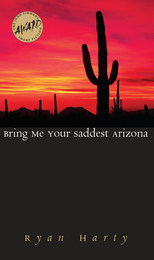 Bring Me Your Saddest Arizona
Ryan Harty
University of Iowa Press, 2003 The vast, unsettling landscape of the American Southwest is as much a character in Ryan Harty's debut collection, Bring Me Your Saddest Arizona, as the men and women who inhabit its award-winning stories. In eight vivid tales of real life in the west, Harty reminds us that life's greatest challenge may be to find the fine balance between desire and obligation. A high school football player must make a choice between family and friends when his older brother commits an act of senseless violence. A middle-aged man must fly to Las Vegas to settle his dead sister's estate, only to discover that he must first confront his guilt over his sister's death. A young teacher tries to help a homeless girl, but, as their lives intertwine, he begins to understand that his generosity is motivated by his own relenting sense of lonliness. Well-intentioned but ultimately human, the characters in these stories often fall short of achieving grace. But the possibility of redemption, like the Sonoran Desert at the edge of Bring Me Your Saddest Arizona's suburban landscapes, is never far off. Harty's characters are as complicated as the people we know, and his vision of life in the west is as hopeful as it is strikingly real.
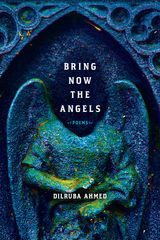 Bring Now the Angels: Poems
Dilruba Ahmed
University of Pittsburgh Press, 2020 This collection juxtaposes text from Google Search autocomplete with the intimate language of prayer. Corporate jargon co-exists with the incantatory and ancient ghazal form. Ahmed’s second book of poetry explores the terrain of loss—of a beloved family member, of human dignity & potential, of the earth as it stands, of hope. Her poems weave mourning with the erratic process of healing, skepticism with an unsteady attempt to regain faith.
With poems that are by turns elegiac, biting, and tender, Bring Now the Angels conveys a desire to move toward transformation and rebirth, even among seemingly insurmountable obstacles: chronic disease, corporate greed, environmental harm, and a general atmosphere of anxiety and violence.
BRING NOW THE ANGELS
To test your pulse as you sleep.
Bring the healer the howler the listening ear—
Bring an apothecary to mix the tincture—
We need the salve
the tablet the capsule
of the hour— Bring sword-eaters
and those who will swallow fire—
Fetch the guardian
to flatten the wheelchair,
to hoist it toward heaven:
the public shuttle awaits
the ceaseless trips to the clinic.
To the bedside manner
summon witness: this medic’s
disdain toward patients the physician’s dismissal
of pain—
And call the druggist, again, to drug us senseless—
Bring a nomad to index our debts
tuck each invoice into broken walls
of regret— Call the cleric the clerk
the messengers divine—
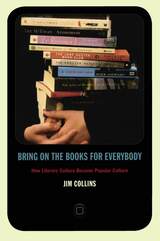 Bring on the Books for Everybody: How Literary Culture Became Popular Culture
Jim Collins
Duke University Press, 2010 Bring on the Books for Everybody is an engaging assessment of the robust popular literary culture that has developed in the United States during the past two decades. Jim Collins describes how a once solitary and print-based experience has become an exuberantly social activity, enjoyed as much on the screen as on the page. Fueled by Oprah’s Book Club, Miramax film adaptations, superstore bookshops, and new technologies such as the Kindle digital reader, literary fiction has been transformed into best-selling, high-concept entertainment. Collins highlights the infrastructural and cultural changes that have given rise to a flourishing reading public at a time when the future of the book has been called into question. Book reading, he claims, has not become obsolete; it has become integrated into popular visual media. Collins explores how digital technologies and the convergence of literary, visual, and consumer cultures have changed what counts as a “literary experience” in phenomena ranging from lush film adaptations such as The English Patient and Shakespeare in Love to the customer communities at Amazon. Central to Collins’s analysis and, he argues, to contemporary literary culture, is the notion that refined taste is now easily acquired; it is just a matter of knowing where to access it and whose advice to trust. Using recent novels, he shows that the redefined literary landscape has affected not just how books are being read, but also what sort of novels are being written for these passionate readers. Collins connects literary bestsellers from The Jane Austen Book Club and Literacy and Longing in L.A. to Saturday and The Line of Beauty, highlighting their depictions of fictional worlds filled with avid readers and their equations of reading with cultivated consumer taste.
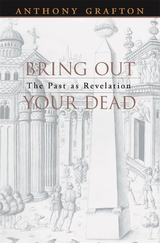 Bring Out Your Dead: The Past as Revelation
Anthony Grafton
Harvard University Press, 2001 The work of the Renaissance humanists comes to life in Anthony Grafton’s exploration of the primary sources and modern scholarship, classical and modern elements in the world of European letters from the fifteenth to the nineteenth century.Tracing the ties that bound the world of humanistic learning in early modern Europe to other social and cultural spheres, Grafton defines the current state of the art of scholarship on early modern European cultural and intellectual history while simultaneously demonstrating how entertaining, enlightening, and relevant that history can be.Covering a dazzling variety of topics and authors as different as Alberti and Descartes, Grafton maps the grand and meticulous efforts of the past to connect the realm of nature with that of books, the realm of everyday experience with that of passionate reading in massive tomes, and the realm of codes of etiquette and institutions with that of extravagant and joyous erudition—efforts that this book itself brilliantly carries on.
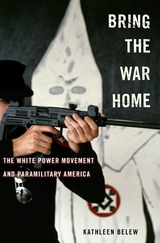 Bring the War Home: The White Power Movement and Paramilitary America
Kathleen Belew
Harvard University Press, 2018 A Guardian Best Book of the Year
“A gripping study of white power…Explosive.”
—New York Times
“Helps explain how we got to today’s alt-right.”
—Terry Gross, Fresh Air
The white power movement in America wants a revolution.
Returning to a country ripped apart by a war they felt they were not allowed to win, a small group of Vietnam veterans and disgruntled civilians who shared their virulent anti-communism and potent sense of betrayal concluded that waging war on their own country was justified. The command structure of their covert movement gave women a prominent place. They operated with discipline, made tragic headlines in Waco, Ruby Ridge, and Oklahoma City, and are resurgent under President Trump. Based on a decade of deep immersion in previously classified FBI files and on extensive interviews, Bring the War Home tells the story of American paramilitarism and the birth of the alt-right.
“A much-needed and troubling revelation… The power of Belew’s book comes, in part, from the fact that it reveals a story about white-racist violence that we should all already know.”
—The Nation
“Fascinating… Shows how hatred of the federal government, fears of communism, and racism all combined in white-power ideology and explains why our responses to the movement have long been woefully inadequate.”
—Slate
“Superbly comprehensive…supplants all journalistic accounts of America’s resurgent white supremacism.”
—Pankaj Mishra, The Guardian
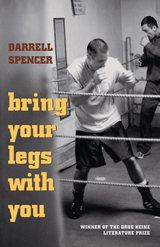 Bring Your Legs with You
Darrell Spencer
University of Pittsburgh Press, 2004 A boxer who brings his legs with him comes to the ring with the strength and stamina to make it through every round of a tough fight. In this new collection, winner of the prestigious Drue Heinz Literature Prize, Darrell Spencer delivers fiction with just that kind of power.
Bring Your Legs with You contains nine interconnected stories set in Las Vegas. Featuring various perspectives and narrators, they are filled with unforgettable characters, including Carl T. Plugg, a sharp-dressed, smooth-talking, non-hustling pool shark; Spinoza, the philosophical day laborer with “Department of Big Thoughts” lettered on the door of his pickup; Jacob, an arrogant lawyer who learns too late the dangers of swimming with the sharks; Gus, a man who has never seen his son fight despite his insatiable fascination with the sweet science; and Jane, a woman wary of her ex-husband, but still in love enough to share her bed with him.
Above them all looms Tommy Rooke, retired prizefighter and self-employed roofer. Undefeated in the ring, Rooke walked away from boxing at the top of his game, to the confusion and consternation of his friends and family. As his father, former manager, and various other hangers-on encourage him to stage a comeback, Tommy moves through the gated communities and sun-blasted strip malls of Las Vegas, wrestling with personal choice, the caprices of fate, and the price the gods demand for our sins.
More than a book about boxing, gambling, luck, and broken dreams, <I>Bring Your Legs with You</I> delves deeply into the life of its flawed but intelligent hero, a man deeply devoted to his friends but lost in a violent world. A writer unafraid to show the connections between people, Spencer delivers a hard-hitting collection filled with rich dialogue and spare prose.
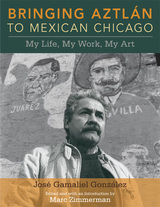 Bringing Aztlan to Mexican Chicago: My Life, My Work, My Art
Jose Gamaliel Gonzalez, Edited and with an Introduction by Marc Zimmerman
University of Illinois Press, 2010 Bringing Aztlán to Mexican Chicago is the autobiography of Jóse Gamaliel González, an impassioned artist willing to risk all for the empowerment of his marginalized and oppressed community. Through recollections emerging in a series of interviews conducted over a period of six years by his friend Marc Zimmerman, González looks back on his life and his role in developing Mexican, Chicano, and Latino art as a fundamental dimension of the city he came to call home. Born near Monterey, Mexico, and raised in a steel mill town in northwest Indiana, González studied art at the School of the Art Institute of Chicago and the University of Notre Dame. Settling in Chicago, he founded two major art groups: El Movimiento Artístico Chicano (MARCH) in the 1970s and Mi Raza Arts Consortium (MIRA) in the 1980s. With numerous illustrations, this book portrays González's all-but-forgotten community advocacy, his commitments and conflicts, and his long struggle to bring quality arts programming to the city. By turns dramatic and humorous, his narrative also covers his bouts of illness, his relationships with other artists and arts promoters, and his place within city and barrio politics.
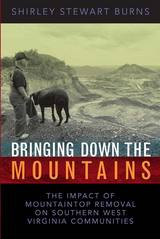 BRINGING DOWN THE MOUNTAINS: THE IMPACT OF MOUTAINTOP REMOVAL SURFACE COAL MINING ON SOUTHERN WEST VIRGINIA COMMUNITIES
Shirley Stewart Burns
West Virginia University Press, 2007 Coal is West Virginia’s bread and butter. For more than a century, West Virginia has answered the energy call of the nation—and the world—by mining and exporting its coal. In 2004, West Virginia’s coal industry provided almost forty thousand jobs directly related to coal, and it contributed $3.5 billion to the state’s gross annual product. And in the same year, West Virginia led the nation in coal exports, shipping over 50 million tons of coal to twenty-three countries. Coal has made millionaires of some and paupers of many. For generations of honest, hard-working West Virginians, coal has put food on tables, built homes, and sent students to college. But coal has also maimed, debilitated, and killed. Bringing Down the Mountains provides insight into how mountaintop removal has affected the people and the land of southern West Virginia. It examines the mechanization of the mining industry and the power relationships between coal interests, politicians, and the average citizen. Shirley Stewart Burns holds a BS in news-editorial journalism, a master’s degree in social work, and a PhD in history with an Appalachian focus, from West Virginia University. A native of Wyoming County in the southern West Virginia coalfields and the daughter of an underground coal miner, she has a passionate interest in the communities, environment, and histories of the southern West Virginia coalfields. She lives in Charleston, West Virginia.
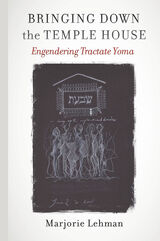 Bringing Down the Temple House: Engendering Tractate Yoma
Marjorie Lehman
Brandeis University Press, 2022 A feminist project that privileges the Babylonian Talmudic tractate as culturally significant.
While the use of feminist analysis as a methodological lens is not new to the study of Talmudic literature or to the study of individual tractates, this book demonstrates that such an intervention with the Babylonian Talmud reveals new perspectives on the rabbis’ relationship with the temple and its priesthood. More specifically, through the relationships most commonly associated with home, such as those of husband-wife, father-son, mother-son, and brother-brother, the rabbis destabilize the temple bayit (or temple house). Moving beyond the view that the temple was replaced by the rabbinic home, and that rabbinic rites reappropriate temple practices, a feminist approach highlights the inextricable link between kinship, gender, and the body, calling attention to the ways the rabbis deconstruct the priesthood so as to reconstruct themselves.
 Bringing Home the Wild: A Riparian Garden in a Southwest City
Juliet C. Stromberg
University of Arizona Press, 2023 When living in a large sprawling city, one may feel disconnected and adrift. Finding ways to belong and have positive effects is challenging. In Bringing Home the Wild, botanist Juliet C. Stromberg demonstrates how ecologically guided gardening develops a sense of place, restores connections to nature, and brings joy and meaning to our lives.
This book follows a two-decade journey in ecologically guided gardening on a four-acre irrigated parcel in Phoenix, Arizona, from the perspective of a retired botanist and her science historian partner. Through humor and playful use of language, Bringing Home the Wild not only introduces the plants who are feeding them, buffering the climate, and elevating their moods but also acknowledges the animals and fungi who are pollinating the plants and recycling the waste. Some of the plants featured are indigenous to the American Southwest, while others are part of the biocultural heritage of the cityscape. This book makes the case for valuing inclusive biodiversity and for respectful interactions with all wild creatures, regardless of their historical origin.
As author and partner learn to cohabit with the plants who feed them, calm them, entertain them, and protect them from the increasing heat, their desire to live sustainably, ethically, and close to the land becomes even stronger, revealing the importance of observing, appreciating, and learning from the ecosystems of which we are a part.
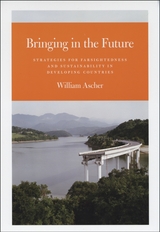 Bringing in the Future: Strategies for Farsightedness and Sustainability in Developing Countries
William Ascher
University of Chicago Press, 2009 Humans are plagued by shortsighted thinking, preferring to put off work on complex, deep-seated, or difficult problems in favor of quick-fix solutions to immediate needs. When short-term thinking is applied to economic development, especially in fragile nations, the results—corruption, waste, and faulty planning—are often disastrous. In Bringing in the Future, William Ascher draws on the latest research from psychology, economics, institutional design, and legal theory to suggest strategies to overcome powerful obstacles to long-term planning in developing countries. Drawing on cases from Africa, Asia, and Latin America, Ascher applies strategies such as the creation and scheduling of tangible and intangible rewards, cognitive exercises to increase the understanding of longer-term consequences, self-restraint mechanisms to protect long-term commitments and enhance credibility, and restructuring policy-making processes to permit greater influence of long-term considerations. Featuring theoretically informed research findings and sound policy examples, this volume will assist policy makers, activists, and scholars seeking to understand how the vagaries of human behavior affect international development.
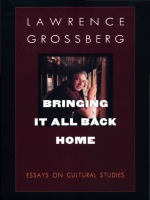 Bringing It All Back Home: Essays on Cultural Studies
Lawrence Grossberg
Duke University Press, 1997 As one of the founding figures of cultural studies, Lawrence Grossberg was an early participant in the Birmingham Centre for Contemporary Cultural Studies’ project, one which sought to develop a critical practice adequate to the complexities of contemporary culture. The essays in Bringing It All Back Home bring a sense of history, depth, and contestation to the current success of cultural studies while charting Grossberg’s intellectual and theoretical developments from his time at Birmingham to the present day. Written over a twenty-year period, these essays—which helped introduce British cultural studies to the United States—reflect Grossberg’s ongoing effort to find a way of theorizing politics and politicizing theory. The essays collected here recognize both the specificity of cultural studies, by locating it in a range of alternative critical perspectives and practices, and its breadth, by mapping the extent of its diversity. By discussing American scholars’ initial reception of cultural studies, its relation to communication studies, and its origins in leftist politics, Grossberg grounds the development of cultural studies in the United States in specific historical and theoretical context. His criticism of "easy" identification of cultural studies with the theories, models, and issues of communications and his challenge to some of cultural studies’ current directions and preoccupations indicates what may lie ahead for this dynamic field of study. Bringing together the Gramscian tradition of British cultural studies with the antimodernist philosophical positions of Foucault, Deleuze, and Guattari, Grossberg articulates an original and important vision of the role of the political intellectual in the contemporary world and offers an essential overview of the emerging field of cultural studies by one of its leading practitioners and theorists.
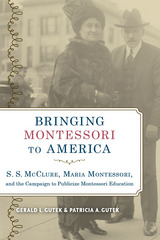 Bringing Montessori to America: S. S. McClure, Maria Montessori, and the Campaign to Publicize Montessori Education
Gerald L. Gutek and Patricia A. Gutek
University of Alabama Press, 2016 2016 Choice Outstanding Academic Title!
Tells the little known story of the collaboration and clash between the indomitable educator Maria Montessori and the American publisher S. S. McClure over the launch of Montessori education in the United States
Born on the Adriatic, Montessori first entered the world stage in 1906 as the innovator of a revolutionary teaching method that creates an environment where children learn at their own pace and initiate skills like reading and writing in a spontaneous way. As her school in Rome swiftly attracted attention, curiosity, and followers, Montessori recruited disciples whom she immersed in a rigorous and detailed teacher-training regimen of her own creation.
McClure was an Irish-born media baron of America’s Gilded Age, best known as the founder and publisher of McClure’s Magazine. Against the backdrop of Theodore Roosevelt’s Bull Moose insurgency, the brilliant and mercurial McClure used his flagship publication as a vehicle to advance Progressive Party causes. After meeting in 1910, McClure and Montessori embarked on a five-year collaboration to introduce Montessori’s innovative teaching style in the United States.
Gerald and Patricia Gutek trace the dramatic arc of the partnership between the Italian teacher and American publisher united by a vision of educational change in the United States. After her triumphal lecture tour in 1913, Montessori, secure in her trust of her American partner, gave McClure her power of attorney and returned to Italy. The surge in popularity of Montessori education in America, however, deeply concerned Montessori, who had heretofore exerted total control over her method, apparatus, schools, and teacher training. The American entrepreneurial spirit, along with a desire to disseminate the Montessori method quickly, led to major conflicts between the Italian educator and American businesspeople, particularly McClure. Feeling betrayed, Montessori ended her relationship with her erstwhile collaborator.
Gutek and Gutek describe the fascinating story of this first wave of Montessori education in the United States, which did not sustain itself during Montessori’s lifetime. It would not be until the 1950s that Montessori education was revived with the successful establishment of Montessori academies throughout the United States.
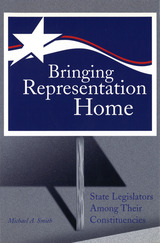 Bringing Representation Home: State Legislators among Their Constituencies
Michael A. Smith
University of Missouri Press, 2003
“What is representation?” is a question that has been raised and discussed many times. In Bringing Representation Home, Michael A. Smith strays from the norm by asking instead, “How can we discover what representation is?” In pursuing the answer to this question, Smith focuses on what representation is in practice, not what it is in theory. Over the course of two legislative sessions, Smith interviewed and observed twelve state representatives in an effort to better understand and define their approaches to representation. He offers generalizations, but only after grounding his study in descriptions of representatives performing their jobs.
The twelve representatives are divided into four categories: Burkeans, in-district advocates, advocates beyond the district, and ombudspersons. Burkeans emphasize character and experience, advocates stress “socializing the conflict,” and ombudspersons underscore listening, responding, and compromising. Smith superbly builds his argument for this classification through an assortment of illustrative examples. He also makes a strong case that home style—the symbolic presentation that a representative makes at home in seeking political support from constituents—is a product of the interaction between the legislator’s personality and progressive ambition and the district’s characteristics and politics. Smith contends that the key to an effective representational strategy is for a representative to have not only an ideology that reflects the politics of his or her community, but also an understanding of the district’s interests, informed by interactions with organized constituencies at home.
Smith helps personalize the legislators of this study, providing a balanced, realistic view. He also offers a new treatment of the representational roles concept, drawing on recent controversies in political science. In this context, he discusses works by Donald Searing, Richard Fenno, Burdett Loomis, and Malcolm Jewell, among others.
Because the nature of representation at the state level is such an important topic—one that will become even more important as state legislatures gain greater influence—Bringing Representation Home makes a vital contribution to political science literature. Written in an accessible and engaging style, this book will be of great interest to students and scholars of legislatures and state politics.
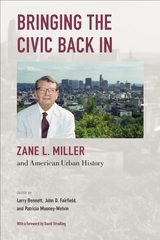 Bringing the Civic Back In: Zane L. Miller and American Urban History
Edited by Larry Bennett, John D. Fairfield, and Patricia Mooney-Melvin
Temple University Press, 2022 With the passing of Zane L. Miller in 2016, academia lost a renowned scholar and one of the key founders of new urban history—a branch of the discipline that placed urban life at the center of American history and treated the city as an arena for civic and political action. He was a devoted, tireless mentor who published or fostered dozens of books and articles on urban history. He also co-founded Temple University Press’ foundational series Urban Life, Landscape, and Policy. Bringing the Civic Back In provides a critical overview, appreciation, and extension of Miller’s work as scholar, editor, mentor, colleague, and citizen. Included are three excerpts from Miller’s final, unfinished work, in which he presented cities as the source of a civic nationalism he viewed as fundamental to the development of American democracy. The editors—along with contributors Robert B. Fairbanks and Charles Lester—reflect on the life and work of their friend as well as his role in creating a Cincinnati school of urban history. These original essays by practitioners of Miller’s approach highlight the power of ideas to shape social change.
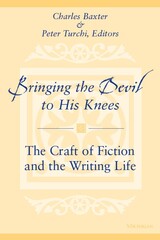 Bringing the Devil to His Knees: The Craft of Fiction and the Writing Life
Charles Baxter and Peter Turchi, Editors
University of Michigan Press, 2001 In Bringing the Devil to His Knees: The Craft of Fiction and the Writing Life, seventeen award-winning writers--all expert teachers--share the secrets of creating compelling, imaginative stories and novels. A combination handbook, writer's companion, and collection of spirited personal essays, the book is filled with specific examples, hard-won wisdom, and compassionate guidance for the developing or experienced fiction writer.
Each of the contributors is a current or former lecturer at the Warren Wilson College MFA Program for Writers, one of the most highly respected writing programs in the country. Included are essays by Charles Baxter, Robert Boswell, Karen Brennan, Judith Grossman, Ehud Havazelet, C. J. Hribal, Margot Livesey, Michael Martone, Kevin McIlvoy, Pablo Medina, Antonya Nelson, Susan Neville, Richard Russo, Steven Schwartz, Jim Shepard, Joan Silber, Debra Spark, Peter Turchi, and Chuck Wachtel.
Rich with masterful examples and personal anecdotes, these imaginative essays provide hard-earned insight into a writer's work. The book will interest not only those seeking inspiration and guidance to become stronger writers, but also readers of contemporary literary fiction, who will find a number of surprising and original approaches to the writer's work by award-winning practitioners adept at teaching others what they know.
Charles Baxter is author of several novels, including The Feast of Love, Shadow Play, and First Light. and collections of stories including Believers and A Relative Stranger. He teaches writing at the University of Michigan. Peter Turchi is author of the novel The Girls Next Door, a collection of stories, Magician, and a book of non-fiction, The Pirate Prince. He is Director of the MFA Program for Writers, Warren Wilson College.
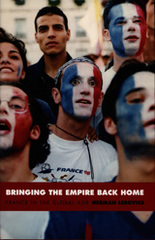 Bringing the Empire Back Home: France in the Global Age
Herman Lebovics
Duke University Press, 2004 Thirty years ago, an international antiglobalization movement was born in the grazing lands of France’s Larzac plateau. In the 1970s, Larzac farmers were joined by others from around the world in their efforts to prevent the expansion of a local military base: by ecologists, religious pacifists, and urban leftists, and by social activists including American Indians and South American peasant leaders. In 1999 some of the same farmers who had fought the expansion of the base in the 1970s—including José Bové—dismantled the new local McDonald’s. That gesture was part of a protest against U.S. tariffs on specified French exports including Roquefort cheese, the region’s primary market product. The two struggles—the one against expanding a French army camp intended to train troops for postcolonial wars, the other against American economic might—were landmarks in the global campaign to preserve local cultures. They were also key episodes in the decades-long attempt by the French to define their cultural heritage within a much changed nation, a new Europe, and, especially, an American-dominated world. In Bringing the Empire Back Home, the inventive cultural historian Herman Lebovics provides a riveting account of how intense disputes about what it means to be French have played out over the past half-century, redefining Paris, the regions, and the former colonies in relation to one another and the world at large. In a narrative populated with peasants, people from the former colonies, museum curators, former colonial administrators, left Christians, archaeologists, anthropologists, soccer players and their teenage fans, and, yes, leading government officials, Lebovics reveals contemporary French society and cultures as perhaps the West’s most important testing grounds of pluralism and assimilation. A lively cultural history, Bringing the Empire Back Home highlights not only the political significance of France’s efforts to synthesize the regional, national, European, ethnic postcolonial, and global but also the chaotic beauty of the endeavor.
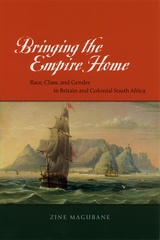 Bringing the Empire Home: Race, Class, and Gender in Britain and Colonial South Africa
Zine Magubane
University of Chicago Press, 2003 How did South Africans become black? How did the idea of blackness influence conceptions of disadvantaged groups in England such as women and the poor, and vice versa?
Bringing the Empire Home tracks colonial images of blackness from South Africa to England and back again to answer questions such as these. Before the mid-1800s, black Africans were considered savage to the extent that their plight mirrored England's internal Others—women, the poor, and the Irish. By the 1900s, England's minority groups were being defined in relation to stereotypes of black South Africans. These stereotypes, in turn, were used to justify both new capitalist class and gender hierarchies in England and the subhuman treatment of blacks in South Africa. Bearing this in mind, Zine Magubane considers how marginalized groups in both countries responded to these racialized representations.
Revealing the often overlooked links among ideologies of race, class, and gender, Bringing the Empire Home demonstrates how much black Africans taught the English about what it meant to be white, poor, or female.
Bringing the Shovel Down
Ross Gay
University of Pittsburgh Press, 2011 Bringing the Shovel Down is a re-imagination of the violent mythologies of state and power.
"These poems speak out of a global consciousness as well as an individual wisdom that is bright with pity, terror, and rage, and which asks the reader to realize that she is not alone--that the grief he carries is not just his own. Gay is a poet of conscience, who echoes Tomas Transtromer's 'We do not surrender. But want peace.'"
--Jean Valentine
"Ross Gay is some kind of brilliant latter-day troubadour whose poetry is shaped not only by yearning but also play and scrutiny, melancholy and intensity. I might be shocked by the bold, persistent love throughout Bringing the Shovel Down if I wasn’t so wooed and transformed by it."
--Terrance Hayes
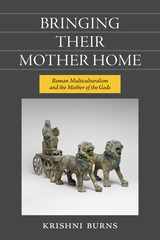 Bringing Their Mother Home: Roman Multiculturalism and the Mother of the Gods
Krishni Burns
University of Michigan Press, 2025 Bringing Their Mother Home examines the worship of the Greco-Phrygian goddess Cybele, known as the Magna Mater in Rome, to understand the ways that the mid- to late-Roman Republic constructed and performed a multicultural, multiethnic identity. The goddess, originally worshiped in ancient Turkey, was brought by the Romans to their city in 204 BCE and renamed the Magna Mater (the Great Mother). Previous scholarship contended that the Romans feared and hated the goddess and her followers because they were foreign and gender nonconforming, but author Krishni Burns argues that the Romans embraced the Magna Mater and her genderfluid followers as they created a space for multiculturalism at a time when Rome was expanding rapidly across the Mediterranean. By importing the cult and ritually performing the Magna Mater's blended Phrygian and Roman identity, the Roman state was able to ease the process of incorporating the eastern Mediterranean kingdoms into its hegemony.
Drawing on historical, literary, and archaeological evidence, Bringing Their Mother Home reevaluates the semiotics and practices of the Magna Mater cult as a way to perform the multicultural Roman identity and explores the political and military climate of the Mediterranean leading up to the cult's adoption in 204 BCE.
Bringing Up Baby: Howard Hawks, Director
Mast, Gerald
Rutgers University Press, 1988 Bringing Up Baby (1938) is the essence of thirties screwball comedy. It is also quintessential Howard Hawks, treating many of the director's favorite themes, particularly the loving war between the sexes. Bringing Up Baby features Katharine Hepburn as a flaky heiress and Cary Grant as an absentminded paleontologist, roles in which they come into their own as stars and deliver particularly fine comic performances. Pauline Kael has called the film the "American movies' closest equivalent to Restoration comedy." The comparison is based on the quick repartee and witty dialogue, a hallmark of Hawks's work and well conveyed here by Gerald Mast's transcription from the screen.
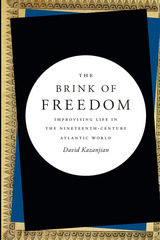 The Brink of Freedom: Improvising Life in the Nineteenth-Century Atlantic World
David Kazanjian
Duke University Press, 2016 In The Brink of Freedom David Kazanjian revises nineteenth-century conceptions of freedom by examining the ways black settler colonists in Liberia and Mayan rebels in Yucatán imagined how to live freely. Focusing on colonial and early national Liberia and the Caste War of Yucatán, Kazanjian interprets letters from black settlers in apposition to letters and literature from Mayan rebels and their Creole antagonists. He reads these overlooked, multilingual archives not for their descriptive content, but for how they unsettle and recast liberal forms of freedom within global systems of racial capitalism. By juxtaposing two unheralded and seemingly unrelated Atlantic histories, Kazanjian finds remarkably fresh, nuanced, and worldly conceptions of freedom thriving amidst the archived everyday. The Brink of Freedom’s speculative, quotidian globalities ultimately ask us to improvise radical ways of living in the world.
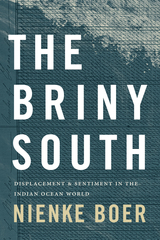 The Briny South: Displacement and Sentiment in the Indian Ocean World
Nienke Boer
Duke University Press, 2023 In The Briny South Nienke Boer examines the legal and literary narratives of enslaved, indentured, and imprisoned individuals crossing the Indian Ocean to analyze the formation of racialized identities in the imperial world. Drawing on court records, ledgers, pamphlets, censors’ reports, newsletters, folk songs, memoirs, and South African and South Asian works of fiction and autobiography, Boer theorizes the role of sentiment and the depiction of emotions in the construction of identities of displaced peoples across the Indian Ocean. From Dutch East India Company rule in the seventeenth and eighteenth centuries to early apartheid South Africa, Boer shows how colonial powers and settler states mediated and manipulated subaltern expressions of emotion as a way to silence racialized subjects and portray them as inarticulately suffering. In this way, sentiment operated in favor of the powerful rather than as an oppositional weapon of the subaltern. By tracing the entwinement of displacement, race, and sentiment, Boer frames the Indian Ocean as a site of subjectification with a long history of transnational connection—and exploitation.
Bristlecone Pine in the White Mountains of California: Growth and Ring-Width Characteristics
Harold C. Fritts
University of Arizona Press, 1969 Papers of the Laboratory of Tree-Ring Research, No. 4 “[An] excellent study of the bristlecone pine (Pinus aristata Engelm.) from the White Mountains of California . . . Many aspects of tree growth and a multitude of growth factors are considered in great detail. . . . An intensive study was made of six small, rather young trees using dendrographs, dendrometers, soil-moisture units, weather-recording instruments, and cambial sampling for the years 1962, 1963, and 1964. . . . The author has done an enormous amount of work in statistics, botany, and ecology.”—Arctic and Alpine Research
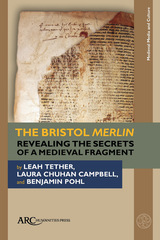 The Bristol Merlin: Revealing the Secrets of a Medieval Fragment
Leah Tether
Arc Humanities Press, 2022 The discovery of seven manuscript fragments of the Old French Suite Vulgate du Merlin in a set of early printed books in the Bristol Central Library hit global headlines in 2019. This book contains a comprehensive study of these fascinating Arthurian fragments.
Beginning with an extensive contextual history, the authors reveal details of the fragments’ origin, their importation to England, and their subsequent journey to a waste pile in a bookbinder’s workshop, where they would be incorporated into the bindings of a four-volume edition of the works of Jean Gerson in the early sixteenth century. A full enquiry into the provenance of these host volumes sets out the possible routes from the bookbinder’s workshop to their final home in Bristol Central Library.
Using multi-spectral imaging to read the damaged sections of text, the authors also provide a full edition and translation of the narrative contained in the fragments.
 Brit Wits: A History of British Rock Humor
Iain Ellis
Intellect Books, 2012 The Sex Pistols. David Bowie. Pink Floyd. Rebel rockers and provokers of the public, vivid in our memories as much for their subversion of the mainstream as for their signature sounds. Yet what very few people realize is that a substantive part of the weaponry used by these rockers and their contemporaries was humor: outrageous onstage antics, coded cultural references, and clever lyrical constructs were all critical to expressions of youth rebellion that could still slip past the powers that be. Focusing on key subversive rock humorists, Brit Wits shows how and why humor has been such a powerful catalyst and expressive force in these artists’ work. Distinguishing rock humorists from rockers who are merely sometimes humorous, Iain Ellis trains his attention on those whose music and persona exude defiance—beginning with the Beatles, the Kinks, and Pink Floyd; and continuing through the Smiths, the Slits, and even the Spice Girls—to investigate the nature of rock humor and the ways in which these groups have used it to attack prevailing social structures. Politics and issues of gender, class, and race are all laid open to ridicule, as is the music industry itself—epitomized by the Sex Pistols’s scathing “EMI.” And although lyrics are foregrounded, Ellis demonstrates that a guitar solo, dissident dance move, or antisocial hairstyle may in context be every bit as subversive and humorous as a song. At once an action-packed look at some of the most notorious rebels of British rock history and a celebration of an underexplored area of humor, Brit Wits compiles essays and critical profiles that look at one of the most effective—and entertaining—means of anti-establishment expression for half a century.
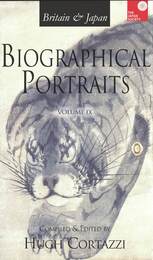 Britain and Japan: Biographical Portraits
Hugh Cortazzi
Amsterdam University Press, 2015 Published in association with the Japan Society and containing 57 essays, this ninth volume in the series continues to celebrate the life and work of the men and women, both British and Japanese, who over time played an interesting and significant role in a wide variety of different spheres relating to the history of Anglo-Japanese relations and deserve to be recorded and remembered. Read together they give a picture, even if inevitably a partial one, of important facets of modern history and Anglo-Japanese institutions. They shed light on a number of controversial issues as well as illuminate past successes and failures. Structured thematically in four Parts – Japan in Britain, Britain in Japan, Scholars and Writers, Politicians and Officials – the highlights in this volume include: The Great Japan Exhibition, 1981-82; Japanese Gardens and the Japanese Garden Society in the UK; Cricket in Late Edo and Meiji Japan; Norman Macrae, pioneering journalist of The Economist; Arthur Balfour – managing the emergence of Japan as a Great Power; Michio Morishima, an economist ‘made in Japan’; Margaret Thatcher – a pragmatist who radically improved Britain’s image in Japan.
Britain and Japan: Biographical Portraits
Hugh Cortazzi
Amsterdam University Press, 2016 This tenth volume in the series, comprising some fifty essays, offers a further wide-ranging selection of essays on different themes and personalities, grouped thematically, from portraits of key figures such as Stamford Raffles and Lord Lytton to the history of Japanese trade and investment in the UK, such as NSK at Peterlee and Mitsubishi Electric in Scotland, from scholars such as Basil Hall Chamberlain, to international Japanese banker Ogata Shijuro.
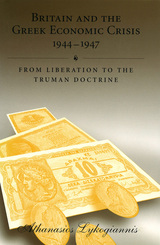 Britain and the Greek Economic Crisis, 1944-1947: From Liberation to the Truman Doctrine
Athanasios Lykogiannis
University of Missouri Press, 2002
Britainand the Greek Economic Crisis, 1944–1947 concentrates on Anglo-Greek interactions in economic matters during the political and economic turmoil between the Axis occupation of Greece and the Greek civil war. By analyzing the Greek crisis primarily in economic terms, Athanasios Lykogiannis avoids the political partisanship that has colored much previous writing on the subject and throws light on many issues neglected by earlier authors. Drawing on a range of untapped British, American, and Greek archival sources, as well as extensive secondary sources, the author examines the interplay of political and economic factors, such as the ingrained polarization of Greek society and the weakness and timidity of the country’s governments, that aggravated and prolonged the crisis.
Lykogiannis critically examines Greece’s policies, and the actors behind them, and assesses the British involvement in the episode: the quality of the measures recommended to the Greeks, the constraints facing British advisers in the country, and the reasons for the ultimate failure of British intervention. He also compares the two periods of western tutelage of Greece: the British and the American, from the announcement of the Truman Doctrine to the inauguration of the European Recovery Program.
Britain and the Greek Economic Crisis, 1944–1947 argues that even if the Germans were to blame for the conditions that led to hyperinflation, the mediocre results of successive attempts to stabilize the economy were caused by internal factors such as the fiscal ineptitude of the postwar Greek governments and their ignorance of, and hostility toward, any form of economic management. Whereas many have blamed foreign intervention for prolonging the crisis, Lykogiannis makes clear that the decisions of successive Greek governments were far more significant. His book demonstrates how firmly the crisis of post-liberation Greece was rooted in the country’s political, economic, and social past.
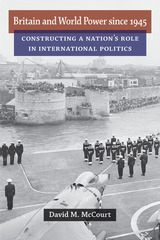 Britain and World Power since 1945: Constructing a Nation's Role in International Politics
David M. McCourt
University of Michigan Press, 2014 ?Though Britain’s descent from global imperial power began in World War II and continued over the subsequent decades with decolonization, military withdrawal, and integration into the European Union, its foreign policy has remained that of a Great Power. David M. McCourt maintains that the lack of a fundamental reorientation of Britain’s foreign policy cannot be explained only by material or economic factors, or even by an essential British international “identity.” Rather, he argues, the persistence of Britain’s place in world affairs can best be explained by the prominent international role that Britain assumed and into which it was thrust by other nations, notably France and the United States, over these years.
Using a role-based theory of state action in international politics based on symbolic interactionism and the work of George Herbert Mead, Britain and World Power since 1945 puts forward a novel interpretation of Britain’s engagement in four key international episodes: the Suez Crisis of 1956, the Skybolt Crisis of 1962, Britain’s second application to the European Economic Council in 1966–67, and Britain’s reinvasion of the Falklands in 1982. McCourt concludes with a discussion of international affairs since the end of the Cold War and the implications for the future of British foreign policy.
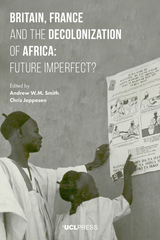 Britain, France and the Decolonization of Africa: Future Imperfect?
Edited by Andrew W.M. Smith and Chris Jeppesen
University College London, 2017 Looking at decolonization in the conditional tense, this volume teases out the complex and uncertain ends of British and French empire in Africa during the period of ‘late colonial shift’ after 1945. Rather than view decolonization as an inevitable process, the contributors together explore the crucial historical moments in which change was negotiated, compromises were made, and debates were staged. Three core themes guide the analysis: development, contingency and entanglement. The chapters consider the ways in which decolonization was governed and moderated by concerns about development and profit. A complementary focus on contingency allows deeper consideration of how colonial powers planned for ‘colonial futures’, and how divergent voices greeted the end of empire. Thinking about entanglements likewise stresses both the connections that existed between the British and French empires in Africa, and those that endured beyond the formal transfer of power.
 Britain in a Perilous World: The Strategic Defence and Security Review We Need
Jonathan Shaw
Haus Publishing, 2014 The British government periodically publishes a Strategic Defence and Security Review, an appraisal of the armed forces that seeks to understand and prepare for the defense challenges that lie ahead. This report is often controversial—the 2010 review, for example, made headlines for all the wrong reasons, as major defense projects such as the NIMROD aircraft were discontinued at huge cost, while other projects were maintained only because they were too expensive to abandon.
In advance of the 2015 Strategic Defence and Security Review, Jonathan Shaw argues persuasively for the need to rethink how governments and Whitehall devise their strategies and reach crucial decisions. Beginning with the review’s often imprecise use of language, Shaw challenges the assumptions that underlie the British government’s current practices. Ultimately, he suggests how Whitehall can improve its approaches and, equally important, its credibility.
Britain in Transition: The Twentieth Century
Alfred F. Havighurst
University of Chicago Press, 1985 This new edition extends and brings up to date the story of political, economic, and social change among the British. An entirely new chapter covers the Thatcher years, discussing such events as the Falkland Island crisis and the General Election of 1983. Other sections have been revised to reflect information only recently available. Throughout, Havighurst has incorporated material from official documents, monographs, biographies, articles, and the press. His fascinating narrative fully captures the ongoing importance of change itself in shaping the character of Britain.
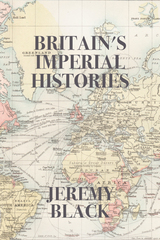 Britain's Imperial Histories
Jeremy black
St. Augustine's Press, 2025 Military historian Jeremy Black continues his review of the global context of martial conflict and spatial conquest into the modern era (16th–20th centuries), focusing on the British empire and its lasting effect on this landscape. Black offers a representation of the "imperial experience" that is eye-opening for a generation of readers who associate this with a strictly negative connotation. But the notion of an empire is not understood at all if this is true. Indeed, not only is there "no one type of empire, no prototype," the basis of empire is much more 'order' than it is 'invasion.' Furthermore, reflecting on the unavoidable cultural and sociological symbiosis and transfer, Black makes the case that in all instances of influence and encounter, sameness between peoples never results. But how does one distinguish influence from control? What are the long-term benefits among peoples? "To many today, empire might seem obvious: governors with ostrich-feathers in their colonial garb ruling non-White peoples; but this scarcely describes the situation across time and place." Why did the European empires ultimately fall? When approaching this question, Britain's Imperial Histories proposes that the perspective of "making and remaking of the international system" be made distinct from the "rational pursuit of power and wealth and the use of technology." As seen in earlier work, Black's brilliance is centered in his capacity to incorporate the complexity of war and its battles in his assessments, while never neglecting the fact that wars themselves have specific and broad contexts that must be read thoroughly. Another highlight of the present work includes more insight into the British-American relationship and American political identity. "If the British empire is blamed for many of the aspects of modernization and globalization, is also serves as a way of offering historical depth to a critique of American power." Yet he is also adept at drawing in Asia into the study and does so with uncommon acumen. This book provides an approach to history that has been neglected, especially in the New World, and connects the present to the past with a kind of hermeneutical responsibility that has been of late abandoned.
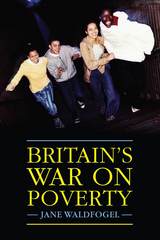 Britain's War on Poverty
Jane Waldfogel
Russell Sage Foundation, 2010 In 1999, one in four British children lived in poverty—the third highest child poverty rate among industrialized countries. Five years later, the child poverty rate in Britain had fallen by more than half in absolute terms. How did the British government accomplish this and what can the United States learn from the British experience? Jane Waldfogel offers a sharp analysis of the New Labour government's anti-poverty agenda, its dramatic early success and eventual stalled progress. Comparing Britain's anti-poverty initiative to U.S. welfare reform, the book shows how the policies of both countries have affected child poverty, living standards, and well-being in low-income families and suggests next steps for future reforms. Britain's War on Poverty evaluates the three-pronged anti-poverty strategy employed by the British government and what these efforts accomplished. British reforms sought to promote work and make work pay, to increase financial support for families with children, and to invest in the health, early-life development, and education of children. The latter two features set the British reforms apart from the work-oriented U.S. welfare reforms, which did not specifically target income or program supports for children. Plagued by premature initiatives and what some experts called an overly ambitious agenda, the British reforms fell short of their intended goal but nevertheless significantly increased single-parent employment, raised incomes for low-income families, and improved child outcomes. Poverty has fallen, and the pattern of low-income family expenditures on child enrichment and healthy food has begun to converge with higher-income families. As Waldfogel sees it, further success in reducing child poverty in Britain will rely on understanding who is poor and who is at highest risk. More than half of poor children live in families where at least one parent is working, followed by unemployed single- and two-parent homes, respectively. Poverty rates are also notably higher for children with disabled parents, large families, and for Pakistani and Bangladeshi children. Based on these demographics, Waldfogel argues that future reforms must, among other goals, raise working-family incomes, provide more work for single parents, and better engage high-risk racial and ethnic minority groups. What can the United States learn from the British example? Britain's War on Poverty is a primer in the triumphs and pitfalls of protracted policy. Notable differences distinguish the British and U.S. models, but Waldfogel asserts that a future U.S. poverty agenda must specifically address child poverty and the income inequality that helps create it. By any measurement and despite obstacles, Britain has significantly reduced child poverty. The book's key lesson is that it can be done.
The British Academics
A. H. Halsey and M. A. Trow
Harvard University Press, 1971 How have academic men in Britain adapted themselves and their institutions to the changes in British society over the past century, and how are they meeting the rapid expansion of the university system that began in the 1960s? What have been the changes in the power and status of British academics and of the English “idea of the university” over these years, and what are the effects on British universities and university teachers of Britain's current move toward mass higher education? Two of today's finest sociologists of education answer these and other questions in a lively and insightful portrait of the changing function of the university in industrial society. Both authors are also students of the American educational system, and a comparative perspective is evident throughout.
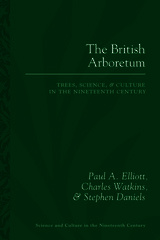 The British Arboretum: Trees, Science and Culture in the Nineteenth Century
Paul A. Elliott
University of Pittsburgh Press, 2011 This study explores the science and culture of nineteenth-century British arboretums, or tree collections. The development of arboretums was fostered by a variety of factors, each of which is explored in detail: global trade and exploration, the popularity of collecting, the significance to the British economy and society, developments in Enlightenment science, changes in landscape gardening aesthetics and agricultural and horticultural improvement.
Arboretums were idealized as microcosms of nature, miniature encapsulations of the globe and as living museums. This book critically examines different kinds of arboretum in order to understand the changing practical, scientific, aesthetic and pedagogical principles that underpinned their design, display and the way in which they were viewed. It is the first study of its kind and fills a gap in the literature on Victorian science and culture.
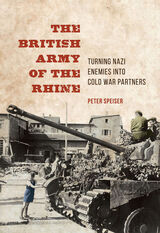 The British Army of the Rhine: Turning Nazi Enemies into Cold War Partners
Peter Speiser
University of Illinois Press, 2016 Between 1945 and 1957, West Germany made a dizzying pivot from Nazi bastion to Britain's Cold War ally against the Soviet Union. Successive London governments, though often faced with bitter public and military opposition, tasked the British Army of the Rhine (BAOR) to serve as a protecting force while strengthening West German integration into the Western defense structure. Peter Speiser charts the BAOR's fraught transformation from occupier to ally by looking at the charged nexus where British troops and their families interacted with Germany's civilian population. Examining the relationship on many levels, Speiser ranges from how British mass media representations of Germany influenced BAOR troops to initiatives taken by the Army to improve relations. He also weighs German perceptions, surveying clashes between soldiers and civilians and comparing the popularity of the British services with that of the other occupying powers. As Speiser shows, the BAOR's presence did not improve the relationship between British servicemen and the German populace, but it did prevent further deterioration during a crucial and dangerous period of the early Cold War. An incisive look at an under-researched episode, The British Army of the Rhine sheds new light on Anglo-German diplomatic, political, and social relations after 1945, and evaluates their impact on the wider context of European integration in the postwar era.
 British Atlantic, American Frontier: Spaces of Power in Early Modern British America
Stephen J. Hornsby
University Press of New England, 2004 Reflecting the growing scholarly interest in transnational and comparative approaches to studying the past, British Atlantic, American Frontier offers a geographical perspective on the development of British America in the seventeenth and eighteenth centuries. It covers in detail not only the American eastern seaboard, but also eastern Canada and the West Indies, as well as the trans-Atlantic links to Western Europe and West Africa. At one level, the book synthesizes much of the current historical and geographical scholarship on these regions; at another level, it offers a provocative interpretation of British America, arguing that profound and long-standing differences existed between the American eastern seaboard and the Atlantic regions of eastern Canada and the West Indies. These differences ultimately led to the break-up of British America, the creation of the United States, and the reconfiguration of the British Empire. British Atlantic, American Frontier is illustrated with more than one hundred photographs, maps, and historical illustrations.
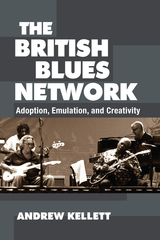 The British Blues Network: Adoption, Emulation, and Creativity
Andrew Kellett
University of Michigan Press, 2017 Beginning in the late 1950s, an influential cadre of young, white, mostly middle-class British men were consuming and appropriating African-American blues music, using blues tropes in their own music and creating a network of admirers and emulators that spanned the Atlantic. This cross-fertilization helped create a commercially successful rock idiom that gave rise to some of the most famous British groups of the era, including The Rolling Stones, The Yardbirds, Eric Clapton, and Led Zeppelin. What empowered these white, middle-class British men to identify with and claim aspects of the musical idiom of African-American blues musicians? The British Blues Network examines the role of British narratives of masculinity and power in the postwar era of decolonization and national decline that contributed to the creation of this network, and how its members used the tropes, vocabulary, and mythology of African-American blues traditions to forge their own musical identities.
 British Diplomacy and Swedish Politics, 1758-1773
Michael Roberts
University of Minnesota Press, 1980
British Diplomacy and Swedish Politics, 1758–1773 was first published in 1980. Minnesota Archive Editions uses digital technology to make long-unavailable books once again accessible, and are published unaltered from the original University of Minnesota Press editions.
This book has three objectives; to shed light on the central issue in British foreign policy during a period inadequately explored by historians; to present, for the first time in English, an account of the dramatic last decade of Swedish "liberty" and its final overthrow by Gustavus III; and finally, to direct the attention of historians to the career of Sir John Goodricke—a diplomat whom Lor Rochford called "the best man we have abroad; you can trust him with anything—except money."
These themes are in fact inextricably linked. For Great Britain, emerging from the Seven Years War victorious but isolated, needed to safeguard her trade with Russia and British statesmen felt that an Anglo-Russian alliance could best be achieved by first concluding a treaty with Sweden to which Russia would adhere. To achieve this aim, it was essential to break French influence in Stockholm, to oust the francophile Hats from power, and to install their anglophile rivals the Caps. Thus Swedish party politics, and the Swedish constitutions, unexpectedly became matters of great consequence in Whitehall. To win the necessary victory in Stockholm Britain needed a minister of peculiar talents and no little ability. Sir John Goodricke was such a minister. And the record of his exertions, and of his eventual failure, is necessary to any proper understanding of British policy in the postwar decade.
This book is an important contribution to both British and Scandinavian history and, since it also illuminates the subject of European political relations in the eighteenth century, it will be welcomed by diplomatic historians and specialists in eighteenth-century studies as well. Michael Roberts tells his story with customary verve and grace, and effectively refutes any idea that diplomatic history need be dull.
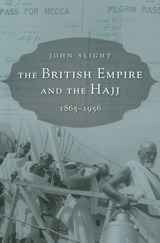 The British Empire and the Hajj: 1865–1956
John Slight
Harvard University Press, 2015 The British Empire at its height governed more than half the world’s Muslims. It was a political imperative for the Empire to present itself to Muslims as a friend and protector, to take seriously what one scholar called its role as “the greatest Mohamedan power in the world.” Few tasks were more important than engagement with the pilgrimage to Mecca.
Every year, tens of thousands of Muslims set out for Mecca from imperial territories throughout Africa, the Middle East, and Asia, from the Atlantic Ocean to the South China Sea. Men and women representing all economic classes and scores of ethnic and linguistic groups made extraordinary journeys across waterways, deserts, and savannahs, creating huge challenges for officials charged with the administration of these pilgrims. They had to balance the religious obligation to travel against the desire to control the pilgrims’ movements, and they became responsible for the care of those who ran out of money. John Slight traces the Empire’s complex interactions with the Hajj from the 1860s, when an outbreak of cholera led Britain to engage reluctantly in medical regulation of pilgrims, to the Suez Crisis of 1956. The story draws on a varied cast of characters—Richard Burton, Thomas Cook, the Begums of Bhopal, Lawrence of Arabia, and frontline imperial officials, many of them Muslim—and gives voice throughout to the pilgrims themselves.
The British Empire and the Hajj is a crucial resource for understanding how this episode in imperial history was experienced by rulers and ruled alike.
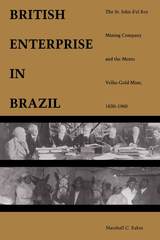 A British Enterprise in Brazil: The St. John d'el Rey Mining Company and the Morro Velho Gold Mine, 1830–1960
Marshall Eakin
Duke University Press, 1990 Marshall Eakin presents what may be the most detailed study ever written about the operations of a foreign business in Latin America and the first scholarly, book-length study of any foreign business enterprise in Brazil. Between 1830 and 1970 the British-owned St. John d’el Rey Mining Company, Ltd. constructed a diverse business conglomerate around Minas Gerais, South America’s largest gold mine, in Nova Lima. Until the 1950s the company was the largest industrial firm and the largest taxpayer in Brazil’s most populous state.
Utilizing company and local archives, Eakin shows that the company was surprisingly ineffective in translating economic success into political influence in Brazil. The most impressive impact of the British operation was at the local level, transforming a small, agrarian community into a sizable industrial city. Virtually a company town, Nova Lima experienced a small-scale industrial revolution as the community made the transition from the largest industrial slave complex in Brazil to a working-class city torn by labor strife and violence between communists and their opponents.
British Extraterritoriality in Korea 1884 – 1910: A Comparison with Japan
Christoph Roberts
Amsterdam University Press, 2021 Filling an important gap in extraterritoriality studies and in the history of Anglo-Korean relations, this benchmark study examines Britain’s exercise of extraterritorial rights in Korea from 1884 until Korea’s formal annexation by Japan in 1910. It shows how the treaty provisions—which provided for Britain’s ideal extra-territorial regime—were influenced by Britain’s considerably greater experience in Japan beginning in 1859. The caseload proved miniscule in the absence of any large British commercial or maritime presence. Nevertheless, it provides an insight into extra-territoriality’s operation outside major commercial centres and ports. Britain’s protection of Chinese interests in Korea in the aftermath of the Sino-Japanese War, 1894–1895 is also covered.
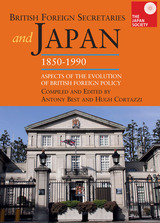 British Foreign Secretaries and Japan, 1850-1990: Aspects of the Evolution of British Foreign Policy
Anthony Best
Amsterdam University Press, 2018 This book reviews the role of British Foreign Secretaries in the formulation of British policy towards Japan from the re-opening of Japan in the middle of the nineteenth century to the end of the twentieth century. It also takes a critical look at the history of British relations with Japan over these years. Beginning with Lord John Russell (Foreign Secretary 1859-1865) and concluding with Geoffrey Howe (Secretary of State for Foreign & Commonwealth Affairs, 1983-1989), the volume also examines the critical roles of two British Prime Ministers in the latter part of the twentieth century, Edward Heath and Margaret Thatcher, who ensured that Britain recognized both the reality and the opportunities for Britain resulting from the Japanese economic and industrial phenomenon. Heath’s main emphasis was on opening the Japanese market to British exports. Thatcher’s was on Japanese investment. This volume is a valuable addition to the Japan Society’s series devoted to aspects of Anglo-Japanese relations which includes ten volumes of Britain & Japan: Biographical Portraits as well as British Envoys in Japan.
 British History 1600-2000: Expansion in Perspective
Edited by Kazuhiko Kondo
University of London Press, 2010 The lands bordering the tidal river Thames and the Thames Estuary have historically been highly vulnerable to marine flooding. The most severe of these floods derive from North Sea storm surges, when wind and tide combine to drive huge quantities of water against the coast, as happened to devastating effect in 1953. This project seeks to understand the occurrence of storm flooding in the past, and to explore the ways in which people have responded to the threat. The project draws upon rich surviving documentary sources to study the impact of storm flooding upon the reclaimed marshlands bordering the tidal Thames and its estuary during the period c.1250-1550. Year-by-year accounts of the management of riverside properties have been examined and the degree to which reclaimed land was lost to the sea during the later Middle Ages assessed. The impact of population decline and agrarian recession upon the economics of coastal and river-side defence has been considered. The flood threat to medieval London’s low-lying suburbs has been investigated and the possibility that the long-term flooding of lands down-river spared the city the worst effects of North Sea storm surges explored. Parallels have also been sought in the modern policy of managed retreat or realignment. The volume concludes with an overview of the multi-faceted work of the Thames Discovery Programme, which is increasing our knowledge of many aspects of the Thames’s past, from medieval fish traps, through nineteenth-century shipbuilding, to the Blitz, which posed a new and very real flood threat to the mid-twentieth century metropolis.
 British International Gold Movements and Banking Policy, 1881-1913
W. Edwards Beach
Harvard University Press This study analyzes for England the relation between international gold movements and internal movements of gold and coin, and the relation of these phenomena to the banking situation. The study was undertaken at the suggestion of the late Professor Allyn A. Young, to see whether the same type of relation which he found in the United States under the National Banking System was also to be found in Great Britain. After a brief introductory survey of some of the more important theories of the part played by gold movements in the adjustment of international trade disequilibria. W. Edwards Beach examines available statistical data concerning gold and currency movements. He then considers bank reserves and deposits in relation to these movements. Following this discussion is an historical survey of the banking and monetary situation in the London money market in relation to banking policy and business conditions.
The British Journal for the Philosophy of Science, volume 73 number 3 (September 2022)
The University of Chicago Press
University of Chicago Press Journals, 2022 This is volume 73 issue 3 of The British Journal for the Philosophy of Science. Since 1950, The British Journal for the Philosophy of Science (BJPS) has presented the best new work in the discipline. An international leader in the philosophy of science, BJPS showcases outstanding research on a variety of topics, from the nature of models and simulations to mathematical explanation and foundational issues in the physical, life, and social sciences. Published on behalf of the British Society for the Philosophy of Science, the journal offers innovative and thought-provoking papers that open up new areas of inquiry or shed new light on well-known issues.
The British Journal for the Philosophy of Science, volume 73 number 4 (December 2022)
The University of Chicago Press
University of Chicago Press Journals, 2022 This is volume 73 issue 4 of The British Journal for the Philosophy of Science. Since 1950, The British Journal for the Philosophy of Science (BJPS) has presented the best new work in the discipline. An international leader in the philosophy of science, BJPS showcases outstanding research on a variety of topics, from the nature of models and simulations to mathematical explanation and foundational issues in the physical, life, and social sciences. Published on behalf of the British Society for the Philosophy of Science, the journal offers innovative and thought-provoking papers that open up new areas of inquiry or shed new light on well-known issues.
The British Journal for the Philosophy of Science, volume 74 number 2 (June 2023)
The University of Chicago Press
University of Chicago Press Journals, 2023 This is volume 74 issue 2 of The British Journal for the Philosophy of Science. Since 1950, The British Journal for the Philosophy of Science (BJPS) has presented the best new work in the discipline. An international leader in the philosophy of science, BJPS showcases outstanding research on a variety of topics, from the nature of models and simulations to mathematical explanation and foundational issues in the physical, life, and social sciences. Published on behalf of the British Society for the Philosophy of Science, the journal offers innovative and thought-provoking papers that open up new areas of inquiry or shed new light on well-known issues.
The British Journal for the Philosophy of Science, volume 74 number 3 (September 2023)
The University of Chicago Press
University of Chicago Press Journals, 2023 This is volume 74 issue 3 of The British Journal for the Philosophy of Science. Since 1950, The British Journal for the Philosophy of Science (BJPS) has presented the best new work in the discipline. An international leader in the philosophy of science, BJPS showcases outstanding research on a variety of topics, from the nature of models and simulations to mathematical explanation and foundational issues in the physical, life, and social sciences. Published on behalf of the British Society for the Philosophy of Science, the journal offers innovative and thought-provoking papers that open up new areas of inquiry or shed new light on well-known issues.
The British Journal for the Philosophy of Science, volume 74 number 4 (December 2023)
The University of Chicago Press
University of Chicago Press Journals, 2023 This is volume 74 issue 4 of The British Journal for the Philosophy of Science. Since 1950, The British Journal for the Philosophy of Science (BJPS) has presented the best new work in the discipline. An international leader in the philosophy of science, BJPS showcases outstanding research on a variety of topics, from the nature of models and simulations to mathematical explanation and foundational issues in the physical, life, and social sciences. Published on behalf of the British Society for the Philosophy of Science, the journal offers innovative and thought-provoking papers that open up new areas of inquiry or shed new light on well-known issues.
The British Journal for the Philosophy of Science, volume 75 number 1 (March 2024)
The University of Chicago Press
University of Chicago Press Journals, 2024 This is volume 75 issue 1 of The British Journal for the Philosophy of Science. Since 1950, The British Journal for the Philosophy of Science (BJPS) has presented the best new work in the discipline. An international leader in the philosophy of science, BJPS showcases outstanding research on a variety of topics, from the nature of models and simulations to mathematical explanation and foundational issues in the physical, life, and social sciences. Published on behalf of the British Society for the Philosophy of Science, the journal offers innovative and thought-provoking papers that open up new areas of inquiry or shed new light on well-known issues.
The British Journal for the Philosophy of Science, volume 75 number 2 (June 2024)
The University of Chicago Press
University of Chicago Press Journals, 2024 This is volume 75 issue 2 of The British Journal for the Philosophy of Science. Since 1950, The British Journal for the Philosophy of Science (BJPS) has presented the best new work in the discipline. An international leader in the philosophy of science, BJPS showcases outstanding research on a variety of topics, from the nature of models and simulations to mathematical explanation and foundational issues in the physical, life, and social sciences. Published on behalf of the British Society for the Philosophy of Science, the journal offers innovative and thought-provoking papers that open up new areas of inquiry or shed new light on well-known issues.
The British Journal for the Philosophy of Science, volume 75 number 3 (September 2024)
The University of Chicago Press
University of Chicago Press Journals, 2024 This is volume 75 issue 3 of The British Journal for the Philosophy of Science. Since 1950, The British Journal for the Philosophy of Science (BJPS) has presented the best new work in the discipline. An international leader in the philosophy of science, BJPS showcases outstanding research on a variety of topics, from the nature of models and simulations to mathematical explanation and foundational issues in the physical, life, and social sciences. Published on behalf of the British Society for the Philosophy of Science, the journal offers innovative and thought-provoking papers that open up new areas of inquiry or shed new light on well-known issues.
The British Journal for the Philosophy of Science, volume 75 number 4 (December 2024)
The University of Chicago Press
University of Chicago Press Journals, 2024 This is volume 75 issue 4 of The British Journal for the Philosophy of Science. Since 1950, The British Journal for the Philosophy of Science (BJPS) has presented the best new work in the discipline. An international leader in the philosophy of science, BJPS showcases outstanding research on a variety of topics, from the nature of models and simulations to mathematical explanation and foundational issues in the physical, life, and social sciences. Published on behalf of the British Society for the Philosophy of Science, the journal offers innovative and thought-provoking papers that open up new areas of inquiry or shed new light on well-known issues.
The British Journal for the Philosophy of Science, volume 76 number 1 (March 2025)
The University of Chicago Press
University of Chicago Press Journals, 2025 This is volume 76 issue 1 of The British Journal for the Philosophy of Science. Since 1950, The British Journal for the Philosophy of Science (BJPS) has presented the best new work in the discipline. An international leader in the philosophy of science, BJPS showcases outstanding research on a variety of topics, from the nature of models and simulations to mathematical explanation and foundational issues in the physical, life, and social sciences. Published on behalf of the British Society for the Philosophy of Science, the journal offers innovative and thought-provoking papers that open up new areas of inquiry or shed new light on well-known issues.
The British Journal for the Philosophy of Science, volume 76 number 2 (June 2025)
The University of Chicago Press
University of Chicago Press Journals, 2025 This is volume 76 issue 2 of The British Journal for the Philosophy of Science. Since 1950, The British Journal for the Philosophy of Science (BJPS) has presented the best new work in the discipline. An international leader in the philosophy of science, BJPS showcases outstanding research on a variety of topics, from the nature of models and simulations to mathematical explanation and foundational issues in the physical, life, and social sciences. Published on behalf of the British Society for the Philosophy of Science, the journal offers innovative and thought-provoking papers that open up new areas of inquiry or shed new light on well-known issues.
The British Journal for the Philosophy of Science, volume 76 number 3 (September 2025)
The University of Chicago Press
University of Chicago Press Journals, 2025 This is volume 76 issue 3 of The British Journal for the Philosophy of Science. Since 1950, The British Journal for the Philosophy of Science (BJPS) has presented the best new work in the discipline. An international leader in the philosophy of science, BJPS showcases outstanding research on a variety of topics, from the nature of models and simulations to mathematical explanation and foundational issues in the physical, life, and social sciences. Published on behalf of the British Society for the Philosophy of Science, the journal offers innovative and thought-provoking papers that open up new areas of inquiry or shed new light on well-known issues.
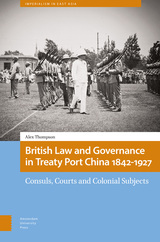 British Law and Governance in Treaty Port China 1842-1927: Consuls, Courts and Colonial Subjects
Alexander Thompson
Amsterdam University Press, 2024 In putting extraterritoriality into practice in the treaty ports, the British state did not simply withdraw rights from the Chinese state; it inhabited the space made by extraterritoriality by building institutions and engaging in practices which had consequences for the development of the treaty ports, and which need to be at the forefront of any attempt to understand colonialism in China. Through a focus both on the creation of law and institutions, and also on the management of British ‘problem populations’ – violent Europeans and ‘martial’ Indians – this book provides a revision of the history of empire and colonialism in China, explaining important features which have to date been glossed over in studies of other aspects of treaty port colonialism. Colonialism in China casts a long shadow, but key aspects of the British state’s central role in this history have before now been little understood.
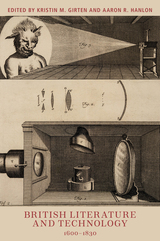 British Literature and Technology, 1600-1830
Kristin M. Girten
Bucknell University Press, 2023 Enlightenment-era writers had not yet come to take technology for granted, but nonetheless were—as we are today—both attracted to and repelled by its potential. This volume registers the deep history of such ambivalence, examining technology’s influence on Enlightenment British literature, as well as the impact of literature on conceptions of, attitudes toward, and implementations of technology. Offering a counterbalance to the abundance of studies on literature and science in seventeenth- and eighteenth-century Britain, this volume’s focus encompasses approaches to literary history that help us understand technologies like the steam engine and the telegraph along with representations of technology in literature such as the “political machine.” Contributors ultimately show how literature across genres provided important sites for Enlightenment readers to recognize themselves as “chimeras”—“hybrids of machine and organism”—and to explore the modern self as “a creature of social reality as well as a creature of fiction.”
 The British Media and Bloody Sunday
Greg McLaughlin and Stephen Baker
Intellect Books, 2015 On Bloody Sunday, January 30, 1972, British paratroopers killed thirteen innocent men in Derry. It was one of the most controversial events in the history of the Northern Ireland conflict and also one of the most mediated. The horror was recorded in newspapers and photographs, on TV news and current affairs, and in film and TV drama. In a cross media analysis that spans a period of almost forty years up to the publication of the Saville Report in 2010, The British Media and Bloody Sunday identifies two countervailing impulses in media coverage of Bloody Sunday and its legacy: an urge in the press to rescue the image and reputation of the British Army versus a troubled conscience in TV current affairs and drama about what was done in Britain’s name. In so doing, it suggests a much more complex set of representations than a straightforward propaganda analysis might allow for, one that says less about the conflict in Ireland than it does about Britain, with its loss of empire and its crisis of national identity.
 British Mercantile Houses in Buenos Aires, 1810–1880
Vera Blinn Reber
Harvard University Press, 1979 British mercantile houses--privately financed commercial enterprises dealing in the import and export of goods--integrated Argentine production into the world economy between 1810 and 1880. For the time they flourished, they dominated every phase of the marketing of both British products and Argentine produce and promoted both their own profits and Argentine economic development.Frequent changes of government, foreign and civil wars, and blockades of the port of Buenos Aires provided merchants with constant risks as well as opportunities. The limited capital and simple organization of mercantile houses suited these risks and opportunities. The author evaluates in detail business operations and decision making and analyzes the relationship between business practices and the Argentine economic and political environment. We see a business institution from the inside: the evolution of practices and procedures, the impact upon the larger economy andsociety.
 British Military Spectacle: From the Napoleonic Wars through the Crimea
Scott Myerly
Harvard University Press, 1996 In the theater of war, how important is costume? And in peacetime, what purpose does military spectacle serve? This book takes us behind the scenes of the British military at the height of its brilliance to show us how dress and discipline helped to mold the military man and attempted to seduce the hearts and minds of a nation while serving to intimidate civil rioters in peacetime.
Often ridiculed for their constrictive splendor, British army uniforms of the early nineteenth century nonetheless played a powerful role in the troops' performance on campaign, in battle, and as dramatic entertainment in peacetime. Plumbing a wide variety of military sources, most tellingly the memoirs and letters of soldiers and civilians, Scott Hughes Myerly reveals how these ornate sartorial creations, combining symbols of solidarity and inspiration, vivid color, and physical restraint, enhanced the managerial effects of rigid discipline, drill, and torturous punishments, but also helped foster regimental esprit de corps.
Encouraging recruitment, enforcing discipline within the military, and boosting morale were essential but not the only functions of martial dress. Myerly also explores the role of the resplendent uniform and its associated gaudy trappings and customs during civil peace and disorder--whether employed as public relations through spectacular free entertainment, or imitated by rioters and rebels opposing the status quo. Dress, drills, parades, inspections, pomp, and order: as this richly illustrated book conducts us through the details of the creation, design, functions, and meaning of these aspects of the martial image, it exposes the underpinnings of a mentality--and vision--that extends far beyond the military subculture into the civic and social order that we call modernity.
British Monetary Policy and the Balance of Payments, 1951–1957
Peter B. Kenen
Harvard University Press A detailed study of the revolution in Bank of England policy resulting from the government’s response to the 1954–55 balance-of-payments crisis, this is a first independent analysis. The author investigates the evolution of official thinking and appraises the impact of monetary policy in this crucial period. Peter Kenen reaches the unexpected conclusion that the Bank’s orthodox monetary policies played a relatively small part in the redress of payments disequilibrium, and that its most effective weapons were its most heterodox. Finally, he proposes ways in which the Bank of England can better control the credit base.
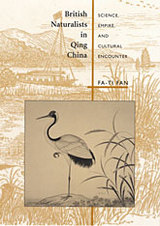 British Naturalists in Qing China: Science, Empire, and Cultural Encounter
Fa-ti Fan
Harvard University Press, 2004 In the eighteenth and nineteenth centuries, Western scientific interest in China focused primarily on natural history. Prominent scholars in Europe as well as Westerners in China, including missionaries, merchants, consular officers, and visiting plant hunters, eagerly investigated the flora and fauna of China. Yet despite the importance and extent of this scientific activity, it has been entirely neglected by historians of science.
This book is the first comprehensive study on this topic. In a series of vivid chapters, Fa-ti Fan examines the research of British naturalists in China in relation to the history of natural history, of empire, and of Sino-Western relations. The author gives a panoramic view of how the British naturalists and the Chinese explored, studied, and represented China's natural world in the social and cultural environment of Qing China.
Using the example of British naturalists in China, the author argues for reinterpreting the history of natural history, by including neglected historical actors, intellectual traditions, and cultural practices. His approach moves beyond viewing the history of science and empire within European history and considers the exchange of ideas, aesthetic tastes, material culture, and plants and animals in local and global contexts. This compelling book provides an innovative framework for understanding the formation of scientific practice and knowledge in cultural encounters.
The British Prime Minister, 2nd ed.
Anthony King
Duke University Press, 1985 The British prime minister is universally acknowledged to be the most powerful single individual in the British system of government, but very little is known about what goes on behind the closed door at #10 Downing Street. As Anthony King points out, there are few articles&#8212;let alone books&#8212;on the prime ministership available to students of British politics either in the UK or the US. As the preface to the American edition states, while the British prime minister and the American president "do resemble each other in some ways, it is important right at the start to recognize the profound differences between them."
British Private Medical Practice and the National Health Service
Samuel Mencher
University of Pittsburgh Press, 1968
Samuel Mencher spent a year in Great Britain (1965-1966) interviewing leaders of professional medical associations, executives of the health insurance societies, and general practitioners and specialists engaged in private practice. His study of the private medical service twenty years after the passage of the National Health Service Act reviews the changes, problems, and successes of the National Health Service: trends in the amount and types of private medicine, the issues of conflict between private medicine and public policy, and attitudes of the public and of medical professionals.
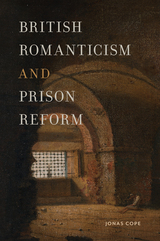 British Romanticism and Prison Reform
Jonas Cope
Bucknell University Press, 2025 In eighteenth-century Britain, criminals were routinely whipped, branded, hanged, or transported to America. Only in the last quarter of the century—with the War of American Independence and legal and sociopolitical challenges to capital punishment—did the criminal justice system change, resulting in the reformed prison, or penitentiary, meant to educate, rehabilitate, and spiritualize even hardened felons. This volume is the first to explore the relationship between historical penal reform and Romantic-era literary texts by luminaries such as Godwin, Keats, Byron, and Austen. The works examined here treat incarceration as ambiguous: prison walls oppress and reinforce the arbitrary power of legal structures but can also heighten meditation, intensify the imagination, and awaken the conscience. Jonas Cope skillfully traces the important ideological work these texts attempt: to reconcile a culture devoted to freedom with the birth of the modern prison system that presents punishment as a form of rehabilitation. Published by Bucknell University Press. Distributed worldwide by Rutgers University Press.
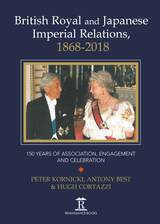 British Royal and Japanese Imperial Relations, 1868-2018: 150 Years of Association, Engagement and Celebration
Peter Kornicki
Amsterdam University Press, 2019 This new scholarly study examines the history of the relations between the British and Japanese monarchies over the past 150 years. Complemented by a significant plate section which includes a number of rarely seen images, as well as a chronology of royal/imperial visits and extensive bibliography, British Royal and Japanese Imperial Relations, 1868-2018, will become a benchmark reference on the subject. The volume is divided into three sections. Part I, by Peter Kornicki, examines the ‘royals and imperials’ history during the Meiji era; Part II, by Antony Best, examines the first half of the twentieth century; Part III, by Sir Hugh Cortazzi, focuses on the post-war history up to the present day. Published in association with the Japan Society, its appearance marks the abdication of Emperor Akihito and the enthronement of Crown Prince Naruhito in May 2019. It is also a memorial volume to the late Sir Hugh Cortazzi who died in August 2018, shortly after completing his own contribution to the volume.
The British Shipbuilding Industry, 1870–1914
Sidney Pollard and Paul Robertson
Harvard University Press, 1979 The performance of the British economy in the critical decades before 1914 is the subject of much scholarly debate. This first modern history of the British shipbuilding industry between 1870 and 1914 examines activities and attitudes of the shipbuilders in the context of this controversy over the quality of British entrepreneurship.
The authors consider the effectiveness of marketing practices, the rate of technological change, the degree to which ever-scarcer natural resources impose a constraint on growth, the general economic rationality of entrepreneurs, and, above all, the consequences of management decisions. After carefully weighing all evidence, the authors conclude that the general level of managerial performance was high, and in contrast to other sectors of heavy industry, British shipbuilders were able to maintain their dominant position.
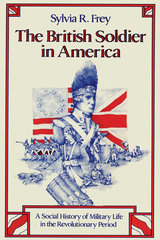 The British Soldier in America: A Social History of Military Life in the Revolutionary Period
By Sylvia R. Frey
University of Texas Press, 1981 In her investigation of the social history of the common British soldier in the era of the American Revolution, Sylvia Frey has extensively surveyed recruiting records, contemporary training manuals, statutes, and memoirs in an attempt to provide insight into the soldier's "life and mind." In the process she has discovered more about the common soldier than anyone thought possible: his social origins and occupational background, his size, age, and general physical condition, his personal economics and daily existence. Her findings dispel the traditional assumption that the army was made up largely of criminals and social misfits. Special attention is given to soldiering as an occupation. Focusing on two of the major campaigns of the war—the Northern Campaign which culminated at Saratoga and the Southern Campaign which ended at Yorktown—Frey describes the human face of war, with particular emphasis on the physical and psychic strains of campaigning in the eighteenth century. Perhaps the most important part of the work is the analysis of the moral and material factors which induced men to accept the high risks of soldiering. Frey rejects the traditional assumption that soldiers were motivated to fight exclusively by fear and force and argues instead that the primary motivation to battle was generated by regimental esprit, which in the eighteenth century substituted for patriotism. After analyzing the sources of esprit, she concludes that it was the sustaining force for morale in a long and discouraging war. This book is a contribution to our understanding of the eighteenth century and should appeal not only to military historians but also to social and economic historians and to those interested in the history of medicine.
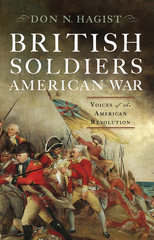 British Soldiers, American War: Voices of the American Revolution
Donald N. Hagist
Westholme Publishing, 2012 Advisor for Ken Burns The American Revolution on PBS®
Nine Rare and Fascinating First-Person Profiles of Soldiers Who Fought for the British Crown
Much has been written about the colonists who took up arms during the American Revolution and the army they created. Far less literature, however, has been devoted to their adversaries. The professional soldiers that composed the British army are seldom considered on a personal level, instead being either overlooked or inaccurately characterized as conscripts and criminals. Most of the British Redcoats sent to America in defense of their government’s policies were career soldiers who enlisted voluntarily in their late teens or early twenties. They came from all walks of British life, including those with nowhere else to turn, those aspiring to improve their social standing, and all others in between. Statistics show that most were simply hardworking men with various amounts of education who had chosen
the military in preference to other occupations. Very few of these soldiers left writings from which we can learn their private motives and experiences.
British Soldiers, American War: Voices of the American Revolution is the first collection of personal narratives by British common soldiers ever assembled and published. Author Don N. Hagist has located first-hand accounts of nine soldiers who served in America in the 1770s and 1780s. In their own words we learn of the diverse population—among them a former weaver, a boy who quarelled with his family, and a man with wanderlust—who joined the army and served tirelessly and dutifully, sometimes faithfully and sometimes irresolutely, in the uniform of their nation. To accompany each narrative, the author provides a contextualizing essay based on archival research giving background on the soldier and his military service. Taken as a whole these true stories reveal much about the individuals who composed what was, at the time, the most formidable fighting force in the world.
British Television: The formative years
Russell Burns
The Institution of Engineering and Technology, 1986 On 2 November 1936 the world's first high definition television station was inaugurated at Alexandra Palace. Two competing companies, Marconi-EMI Television Company Ltd and Baird Television Ltd, provided studio and transmitting equipment for the new service which operated, on an alternate basis, with the systems of the two companies. After a trial period the 405-line system of the Marconi-EMI company was adopted and the last transmission by the 240-line system of Baird Television Ltd was sent out on 30 January 1937.
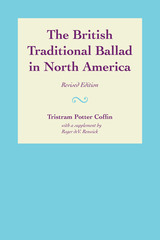 The British Traditional Ballad in North America
By Tristram P. Coffin
University of Texas Press, 1977 Tristram Potter Coffin’s The British Traditional Ballad in North America, published in 1950, became recognized as the standard reference to the published material on the Child ballad in North America. Centering on the theme of story variation, the book examines ballad variation in general, treats the development of the traditional ballad into an art form, and provides a bibliographical guide to story variation as well as a general bibliography of titles referred to in the guide. Roger deV. Renwick’s supplement to The British Traditional Ballad in North America provides a thorough review of all sources of North American ballad materials published from 1963, the date of the last revision of the original volume, to 1977. The references, which include published text fragments and published title lists of items in archival collections, are arranged according to each ballad’s story variations. Textual and thematic comparisons among ballads in the British and American tradition are made throughout. In his introductory essay Renwick synthesizes the various theoretical approaches to the phenomenon of variation that have appeared in scholarly publications since 1963 and provides examples from texts referred to in the bibliographical guide itself. The supplement, like its parent work, is an invaluable reference tool for the study of variation in ballad form, content, and style. Together with the reprinted text of the 1963 edition, the supplement provides an exhaustive bibliography to the literature on the British traditional ballad in North America.
 British TV and Film Culture in the 1950s: Coming to a TV Near You
Su Holmes
Intellect Books, 1995 This book focuses on the emerging historical relations between British television and film culture in the 1950s. Drawing upon archival research, it does this by exploring the development of the early cinema programme on television - principally Current Release (BBC, 1952-3), Picture Parade (BBC, 1956) and Film Fanfare (ABC, 1956-7) - and argues that it was these texts which played the central role in the developing relations between the media. Particularly when it comes to Britain, the early co-existence of television and cinema has been seen as hostile and antagonistic, but in situating these programmes within the contexts of their institutional production, aesthetic construction and reception, the book aims to ‘reconstruct’ television’s coverage of the cinema as crucial to the fabric of British film and television culture at the time. It demonstrates how the roles of cinema and television - as media industries and cultural forms, but crucially as sites of screen entertainment - effectively came together at this time in such a way that is unique to this decade.
 The British Way to Recovery: Plans and Policies in Great Britain, Australia, and Canada
Herbert Heaton
University of Minnesota Press, 1934 The British Way to Recovery was first published in 1934. Minnesota Archive Editions uses digital technology to make long-unavailable books once again accessible, and are published unaltered from the original University of Minnesota Press editions.An answer to President Roosevelt’s question – “Did England let nature take its course?”This book is rich in parallels between problems faced very early in the British nations and those that arose somewhat later in the United States. Six of the eight chapters deal with England, her search for solutions, and the outcome of her experiments, providing an illuminating background for similar American policies. A chapter apiece is given to Australia, “first in and first out” of the depression, and to Canada, whose geographical and political nearness makes her recovery program of particular interest to the United States.Professor Heaton enjoys the distinction of having lived and worked in each of the countries of which he writes. He was born a Yorkshireman, was educated at the Universities of Leeds and Birmingham, and taught economics at Birmingham. In Australia he lectured on economics and history at the Universities of Tasmania and Adelaide. Then he went to Queen’s University, Canada, from which he came to the University of Minnesota.
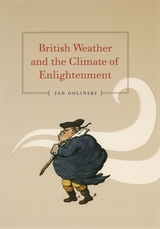 British Weather and the Climate of Enlightenment
Jan Golinski
University of Chicago Press, 2007 Enlightenment inquiries into the weather sought to impose order on a force that had the power to alter human life and social conditions. British Weather and the Climate of Enlightenment reveals how a new sense of the national climate emerged in the eighteenth century from the systematic recording of the weather, and how it was deployed in discussions of the health and welfare of the population. Enlightened intellectuals hailed climate’s role in the development of civilization but acknowledged that human existence depended on natural forces that would never submit to rational control.
Reading the Enlightenment through the ideas, beliefs, and practices concerning the weather, Jan Golinski aims to reshape our understanding of the movement and its legacy for modern environmental thinking. With its combination of cultural history and the history of science, British Weather and the Climate of Enlightenment counters the claim that Enlightenment progress set humans against nature, instead revealing that intellectuals of the age drew characteristically modern conclusions about the inextricability of nature and culture.
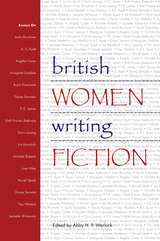 British Women Writing Fiction
Abby H.P. Werlock
University of Alabama Press, 2000 Original essays by American and British scholars offer a reader-friendly introduction to the work of Angela Carter, Doris Lessing, and a dozen other British women writers British women in the second half of the 20th century have produced a body of work that is as diverse as it is entertaining. This book offers an informal, jargon-free introduction to the fiction of sixteen contemporary writers either brought up or now living in England, from Muriel Spark to Jeanette Winterson.
British Women Writing Fiction presents a balanced view comprising women writing since the 1950s and 1960s, those who attracted critical attention during the 1970s and 1980s, and those who have burst upon the literary scene more recently, including African-Caribbean and African women. The essays show how all of these writers treat British subjects and themes, sometimes from radically different perspectives, and how those who are daughters of immigrants see themselves as women writing on the margins of society.
Abby Werlock's introduction explores the historical and aesthetic factors that have contributed to the genre, showing how even those writers who began in a traditional vein have created experimental work. The contributors provide complete bibliographies of each writer's works and selected bibliographies of criticism. Exceptional both in its breadth of subjects covered and critical approaches taken, this book provides essential background that will enable readers to appreciate the singular merits of each writer. It offers an approach toward better understanding favorite authors and provides a way to become acquainted with new ones.
 British Working-Class and Radical Writing Since 1700
Edited by John Goodridge and Adam Bridgen
University of London Press, 2025 An essential history of how literature became a battleground for class struggle and political dissent in Britain.
At a time when working-class writing is gaining long-overdue recognition, British Working-Class and Radical Writing Since 1700 explores the intersection of class and literature over more than three centuries. This volume brings together leading scholars to examine the problems faced by working-class writers and the impact of class on themes such as feminism and anti-imperialism. Spanning from early laboring-class poets to contemporary memoirists, the collection revisits figures like John Clare and Ethel Carnie Holdsworth and also recovers overlooked voices and texts.
Covering poetry, fiction, drama, and political writing, the book investigates the relationship between class and literary production, offering fresh perspectives on how working-class and radical literature has shaped British cultural history. From the Romantic-era resistance of laboring poets to mid-century miners’ novels and the evolution of contemporary working-class memoirs, these essays reveal how literature has served as both a site of struggle and a tool of empowerment.
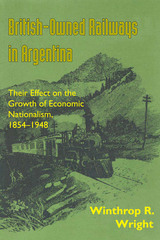 British-Owned Railways in Argentina: Their Effect on the Growth of Economic Nationalism, 1854-1948
By Winthrop R. Wright
University of Texas Press, 1974 During the nineteenth century, British-owned railways grew under the protection of an Argentine ruling elite that considered railways both instruments and symbols of progress. Under this program of support for foreign enterprise, Argentina had by 1914 built the largest railway network in Latin America. During the first decades of the twentieth century, the railways were successful in following a policy of calculated disregard for Argentine interests in general. However, following the end of World War I, the British economic empire began to decline and Argentine economic nationalism grew. A number of popularistic political movements incorporated economic nationalism into their platforms, and even among the ruling elite there were signs of increasing nationalistic sentiment. Although most studies of economic nationalism have emphasized the importance of the middle-class Radical party in the rise of xenophobia, Winthrop R. Wright's study shows that antiforeign economic nationalism was not entirely a reaction to the conservative elite. Between 1932 and 1938 the nationalistic programs of General Agustin Justo's government—basically a conservative regime—led the British interests to decide to sell their holdings. The British govemment had arrived at a position of supporting the economic withdrawal of the large British-owned firms long before Juan D. Perón appeared on the political scene. Perón combined traditional Argentine economic nationalism with his own scheme to gain power over all elements in Argentina. His solution to the railway problem, although more dramatically executed, did not differ greatly from that of the conservative Justo. Perón purchased the railways outright in 1947–1948, but his use of nationalism was in reality covering his own inability to outbargain Britain and the United States following the conclusion of World War II.
Britpop Cinema: From Trainspotting to This is England
Matt Glasby
Intellect Books, 2019 The Britpop movement of the mid-1990s defined a generation, and the films were just as exciting as the music. Beginning with Shallow Grave, hitting its stride with Trainspotting, and going global with The Full Monty, Lock, Stock and Two Smoking Barrels, Shaun of the Dead, and This Is England, Britpop cinema pushed boundaries, paid Hollywood no heed, and placed the United Kingdom all too briefly at the center of the movie universe. Featuring exclusive interviews with key players such as Simon Pegg, Irvine Welsh, Michael Winterbottom and Edgar Wright, Britpop Cinema combines eyewitness accounts, close analysis, and social history to celebrate a golden age for UK film.
Britten: Centenary Edition
David Matthews
Haus Publishing, 2013 Benjamin Britten was one of the outstanding British composers of the 20th century. He shot to international fame with his operas, performed by his own English Opera Group, and a series of extraordinary instrumental works. His music won a central place in the repertoire and the affection of successive generations of listeners. David Matthews brings to this biography his special insight as a fellow composer, former assistant and life-long friend of Britten to produce a uniquely personal, sensitive and authoritative account.
Brittons Bowre of Delights, 1591
Hyder Edward Rollins
Harvard University Press Although this is one of the most charming and most important of the Elizabethan poetical miscellanies, it has hitherto been inaccessible to scholars. The Huntington Library copy of the first edition (1591), which is here reproduced in collotype facsimile, is the only known one. Large and significant changes were made in the second edition (1597), of which only two copies are known to exist. Hyder Edward Rollins gives full details about the variations in contents and readings between these two editions. The Introduction further discusses the editor Richard Jones and his relations with Nicolas Breton; the various authors represented; and borrowings from or allusions to the works of Thomas Nashe, Thomas Heywood, Shakespeare, and others. The Notes contain much critical, explanatory, and illustrative material.
Broadband Applications and the Digital Home
John Turnbull
The Institution of Engineering and Technology, 2003 This book explores some of the technological challenges in the application of digital communications technology in the home, including provision of fast, 'always on' internet connections. It looks at the ways consumers will use broadband access and what the key applications will be for provider and consumer. More broadly it aims to describe how communication to and within the home is evolving, and how people's lives are changing as they take advantage of the new technology and its applications.
Broadband Communications and Home Networking
Scott R. Bullock
The Institution of Engineering and Technology, 2001 This book provides the engineer and manager with a very good understanding of the processes needed to effectively perform the system design for broadband communication systems and home networking approaches. It is ideal for all engineers that design and analyze wireless, spread spectrum and basic broadband communication systems and are involved with the design of basic networking systems. It provides a good intuitive approach starting from basic telephony to satellite communications.
 Broadcasters and Citizens in Europe: Trends in Media Accountability and Viewer Participation
Edited by Paolo Baldi and Uwe Hasebrink
Intellect Books, 2007 European media is experiencing a paradoxical form of growth: as media outlets surge and new technologies develop, major broadcasting companies are consolidating like never before. In Broadcasters and Citizens in Europe, an esteemed group of contributors look at what this paradox might mean for the European community. Are broadcasting audiences better informed than they were twenty years ago? And how has the advent of the European Union changed media practices? This essential volume explores a new media world in the context of a continent in flux. “The book is a good source of information about institutional arrangements developed in European countries in the field of audio-visual policy. It gives an interesting and well-written account of how particular European countries and the European Union try to deal with different problems deriving from the ethical dilemma inscribed in the construction of media systems.”—Magdalena Rek, Journal of Contemporary European Studies “Communication scholars will benefit from the focus on research from across Europe along with the theoretical implications. For media policy-makers and members of civic organisations, the taxonomy of instruments will provide an overview for possible policy development. Finally, the clarity with which this book is written will help college students understand the field of media and social responsibility.”— Jarim Kim, Media International Australia
Broadcasting and National Imagination in Post-Communist Latvia: Defining the Nation, Defining Public Television
Janis Juzefovics
Intellect Books, 2017 This book uses the case study of public television in post-communist Latvia to explore the question of how audiences respond to TV offerings, and how their choices can be seen as an act of agency. Jānis Juzefovičs builds his book around Albert O. Hirschman’s classic concepts of exit, voice, and loyalty—the options available to a person within any system. He uses Hirschman’s ideas, along with tools from social constructionism, to assess how the publics of both the Latvian-speaking majority and the large Russian-speaking minority have responded to the role of public television in the nation-building efforts of the new Latvian state. Along the way, he develops our understanding of public broadcasting more generally, and the way it can be used to define a national 'we'.
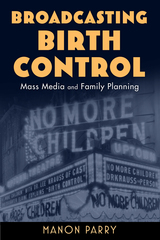 Broadcasting Birth Control: Mass Media and Family Planning
Parry, Manon
Rutgers University Press, 2013 Traditionally, the history of the birth control movement has been told through the accounts of the leaders, organizations, and legislation that shaped the campaign. Recently, historians have begun examining the cultural work of printed media, including newspapers, magazines, and even novels in fostering support for the cause. Broadcasting Birth Control builds on this new scholarship to explore the films and radio and television broadcasts developed by twentieth-century birth control advocates to promote family planning at home in the United States, and in the expanding international arena of population control.
Mass media, Manon Parry contends, was critical to the birth control movement’s attempts to build support and later to publicize the idea of fertility control and the availability of contraceptive services in the United States and around the world. Though these public efforts in advertising and education were undertaken initially by leading advocates, including Margaret Sanger, increasingly a growing class of public communications experts took on the role, mimicking the efforts of commercial advertisers to promote health and contraception in short plays, cartoons, films, and soap operas. In this way, they made a private subject—fertility control—appropriate for public discussion.
Parry examines these trends to shed light on the contested nature of the motivations of birth control advocates. Acknowledging that supporters of contraception were not always motivated by the best interests of individual women, Parry concludes that family planning advocates were nonetheless convinced of women’s desire for contraception and highly aware of the ethical issues involved in the use of the media to inform and persuade.
Broadcasting Diversity: Migrant Representation in Irish Radio
Katie Moylan
Intellect Books, 2013 Broadcasting Diversity explores modes of migrant representation and participation in Irish radio, focusing on the national public broadcaster Raidió Teilifís Éireann and Dublin community stations and examining the opportunities provided for voicing migrant experience in transcultural program production. Investigating the intersection between an established Irish culture on the one hand and the nascent emergence of a transnational culture on the other, this book focuses on the ways in which migrant representation and self-representation have been variously effected in the Irish public sphere via the medium of radio.
 Broadcasting Hollywood: The Struggle over Feature Films on Early TV
Jennifer Porst
Rutgers University Press, 2021 Broadcasting Hollywood: The Struggle Over Feature Films on Early Television uses extensive archival research into the files of studios, networks, advertising agencies, unions and guilds, theatre associations, the FCC, and key legal cases to analyze the tensions and synergies between the film and television industries in the early years of television. This analysis of the case study of the struggle over Hollywood’s feature films appearing on television in the 1940s and 1950s illustrates that the notion of an industry misunderstands the complex array of stakeholders who work in and profit from a media sector, and models a variegated examination of the history of media industries. Ultimately, it draws a parallel to the contemporary period and the introduction of digital media to highlight the fact that history repeats itself and can therefore play a key role in helping media industry scholars and practitioners to understand and navigate contemporary industrial phenomena.
 Broadcasting in the Third World: Promise and Performance
Elihu Katz and George Wedell
Harvard University Press, 1977 Broadcasting has long been considered one of the keys to modernization in the developing world. Able to leap the triple barrier of distance, illiteracy, and apathy, it was seen as a crucial clement in the development of new nations. Recently, however, these expectations have been disappointed by broadcasting's failures to reach the rural masses and the urban unemployed. Broadcasting has also come under attack as serious questions have been raised about its uncritical importation of western culture. Now, in Broadcasting in the Third World, Elihu Katz and George Wedell offer the first complete coverage of the problems and promises of broadcasting in the third world. Their findings, often controversial and always illuminating, will be of considerable value to sociologists, political scientists, communications specialists, and students of development.
Broadcasting in the Third World is based on field research in eleven developing countries (Algeria, Brazil, Cyprus, Indonesia, Iran, Nigeria, Peru, Senegal, Singapore, Tanzania, and Thailand) and secondary source material from a further eighty countries. In looking at the role of broadcasting in national development, the authors focus on three areas of promise: national integration, socio-economic development, and cultural continuity and change. They describe the ways in which the technology and content of broadcasting have been transferred from the developed west to the third world, and the go on to show that western broadcasting must be adapted to suit the specific political, economic and social structures of each developing country.
The authors conclude with a series of recommendations which challenge most of the assumptions upon which the principles and practices of broadcasting are based. Well-researched, extensively documented, it will challenge policy-makers and provide important data for researchers.
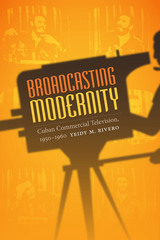 Broadcasting Modernity: Cuban Commercial Television, 1950-1960
Yeidy M. Rivero
Duke University Press, 2015 The birth and development of commercial television in Cuba in the 1950s occurred alongside political and social turmoil. In this period of dramatic swings encompassing democracy, a coup, a dictatorship, and a revolution, television functioned as a beacon and promoter of Cuba’s identity as a modern nation. In Broadcasting Modernity, television historian Yeidy M. Rivero shows how television owners, regulatory entities, critics, and the state produced Cuban modernity for television. The Cuban television industry enabled different institutions to convey the nation's progress, democracy, economic abundance, high culture, education, morality, and decency. After nationalizing Cuban television, the state used it to advance Fidel Castro's project of creating a modern socialist country. As Cuba changed, television changed with it. Rivero not only demonstrates television's importance to Cuban cultural identity formation, she explains how the medium functions in society during times of radical political and social transformation.
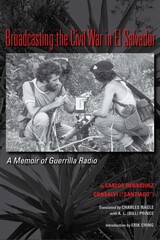 Broadcasting the Civil War in El Salvador: A Memoir of Guerrilla Radio
By Carlos Henriquez Consalvi ("Santiago")
University of Texas Press, 2010 During the 1980s war in El Salvador, Radio Venceremos was the main news outlet for the Frente Farabundo Martí para la Liberación Nacional (FMLN), the guerrilla organization that challenged the government. The broadcast provided a vital link between combatants in the mountains and the outside world, as well as an alternative to mainstream media reporting. In this first-person account, "Santiago," the legend behind Radio Venceremos, tells the story of the early years of that conflict, a rebellion of poor peasants against the Salvadoran government and its benefactor, the United States. Originally published as La Terquedad del Izote, this memoir also addresses the broader story of a nationwide rebellion and its international context, particularly the intensifying Cold War and heavy U.S. involvement in it under President Reagan. By the war's end in 1992, more than 75,000 were dead and 350,000 wounded—in a country the size of Massachusetts. Although outnumbered and outfinanced, the rebels fought the Salvadoran Army to a draw and brought enough bargaining power to the negotiating table to achieve some of their key objectives, including democratic reforms and an overhaul of the security forces. Broadcasting the Civil War in El Salvador is a riveting account from the rebels' point of view that lends immediacy to the Salvadoran conflict. It should appeal to all who are interested in historic memory and human rights, U.S. policy toward Central America, and the role the media can play in wartime.
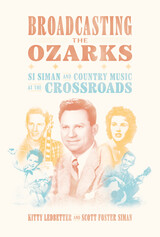 Broadcasting the Ozarks: Si Siman and Country Music at the Crossroads
Kitty Ledbetter
University of Arkansas Press, 2024 “It’s good to see Si Siman and the Ozark Jubilee get their due in Broadcasting the Ozarks.”
—Willie Nelson Broadcasting the Ozarks explores the vibrant country music scene that emerged in Springfield, Missouri, in the 1930s and thrived for half a century. Central to this history is the Ozark Jubilee (1955–60), the first regularly broadcast live country music show on network television. Dubbed the “king of the televised barn dances,” the show introduced the Ozarks to viewers across America and put Springfield in the running with Nashville for dominance of the country music industry—with the Jubilee’s producer, Si Siman, at the helm. Siman’s life story is almost as remarkable as the show he produced. He was booking Tommy Dorsey, Ella Fitzgerald, and Glenn Miller during the mid-1930s while still a high school student and produced nationally syndicated country music radio shows in the decades that followed. Siman was a promotional genius with an ear for talent, a persuasive gift for gab, and the energy and persistence to make things happen for many future Country Music Hall of Famers, including Chet Atkins, Porter Wagoner, the Browns, and Brenda Lee. Following the Jubilee’s five-year run, Siman had a hand in some of the greatest hits of the twentieth century as a music publisher, collaborating with such songwriters as rockabilly legend and fellow Springfieldian Ronnie Self, who wrote Brenda Lee’s signature hit, “I’m Sorry,” and Wayne Carson, who wrote Willie Nelson’s “Always on My Mind.” Although Siman had numerous opportunities to find success in bigger cities, he chose to do it all from his hometown in the Ozarks.
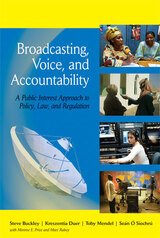 Broadcasting, Voice, and Accountability: A Public Interest Approach to Policy, Law, and Regulation
Steve Buckley, Kreszentia Duer, Toby Mendel, and Seán Ó Siochrú
University of Michigan Press, 2008 Participatory development and government accountability depend in part on the existence of media that provide broad access to information from varied sources and that equip and encourage people to raise and debate issues and develop public opinion. Conducive policies, laws, and regulations are essential for media to develop that are independent and widely accessible and that enable the expression of diverse perspectives and sources of information. Broadcasting, Voice, and Accountability presents a framework to inform analysis of existing policies and support the development of a vigorous media sector, with a particular emphasis on broadcasting. It focuses on broadcasting because that is the medium with the greatest potential to reach and involve society at large, including the most disadvantaged and illiterate segments of society in developing countries. Information on good practices in broadcasting policy is in demand in countries of every region—particularly in countries that are opening their economies, democratizing, and decentralizing public service delivery. This book provides development practitioners with a wide overview of the key policy and regulatory issues involved in supporting freedom of information and expression and enabling development of a pluralistic, independent, and robust broadcasting sector. Policy, regulation, capacity, and institutional development are important development levers that shape the ownership, content, and social impacts of broadcasting systems. The guide shows the importance of enabling a mix of ownership and uses, commonly classified in terms of commercial, public service, and community broadcasting, that serves the public interest. With the guidance of this book, broadcasting policy and regulation can be tackled as a mainstream development topic, with important consequences for government transparency, government accountability, and enabling disadvantaged constituencies to voice their concerns and press for action. This book is the World Bank's first publication presenting good practices from around the world in media and broadcasting policy and regulation and complements existing work in governance, public sector reform, and access to information. It is a useful tool for policymakers, reform managers, development practitioners, and students alike. "Most books on the state of broadcasting in the third world tend either to lament the lack of governance, accountability and competence, or to speak down to their readers. This book is part of a new generation that acknowledges ability and a willingness to move forward into the twenty-first century with integrity and imagination. It is not patronizing, and it is certainly not boring. It focuses on really useful approaches to setting up, sustaining, and governing broadcasting systems across the world. This is an excellent book whose combination of sound scholarship and intelligent advice will be welcomed by policymakers and broadcasters alike. It is relevant, interesting, and a jolly good read."
---Ruth Teer-Tomaselli, UNESCO Chair in Communication for Southern Africa, Culture, Communication and Media Studies, University of KwaZulu-Natal
digitalculturebooks is an imprint of the University of Michigan Press and the Scholarly Publishing Office of the University of Michigan Library dedicated to publishing innovative and accessible work exploring new media and their impact on society, culture, and scholarly communication. Visit the website at www.digitalculture.org.
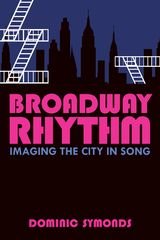 Broadway Rhythm: Imaging the City in Song
Dominic Symonds
University of Michigan Press, 2017 Broadway Rhythm is a guide to Manhattan like nothing you've ever read. Author Dominic Symonds calls it a performance cartography, and argues that the city of New York maps its iconicity in the music of the Broadway songbook. A series of walking tours takes the reader through the landscape of Manhattan, clambering over rooftops, riding the subway, and flying over skyscrapers. Symonds argues that Broadway's songs can themselves be used as maps to better understand the city though identifiable patterns in the visual graphics of the score, the auditory experience of the music, and the embodied articulation of performance, recognizing in all of these patterns, corollaries inscribed in the terrain, geography, and architecture of the city.
Through musicological analyses of works by Gershwin, Bernstein, Copland, Sondheim and others, the author proposes that performance cartography is a versatile methodology for urban theory, and establishes a methodological approach that uses the idea of the map in three ways: as an impetus, a metaphor, and a tool for exploring the city.
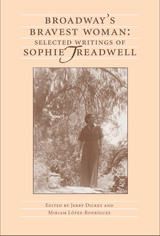 Broadway's Bravest Woman: Selected Writings of Sophie Treadwell
Edited by Jerry Dickey and Miriam Lopez-Rodriguez
Southern Illinois University Press, 2006 This collection of plays, fiction, and journalistic essays by Sophie Treadwell provides an engaging portrait of one of America’s most innovative yet neglected feminists. Broadway’s Bravest Woman: Selected Writings of Sophie Treadwell is the first critical compilation of her prose and drama and highlights the most significant and formerly unavailable pieces of her work. Editors Jerry Dickey and Miriam López-Rodriguez place Treadwell within the context of the early twentieth century and outline four themes that infused her feminist ideology: the social positioning of women, ethnic identity in the United States, tensions between modern progressivism and conservatism, and the individual’s role in the face of social justice. Treadwell’s critical reputation as a dramatist is largely based on the success of the 1928 expressionist drama Machinal, but little is known about her other dramas, much less her fiction and journalism. Drawing largely upon unpublished manuscripts, this volume documents the breadth of Treadwell’s work, from an investigative newspaper serial written in 1914 to selections from an autobiographical novel completed during World War II, which chronicled her development as a feminist. In the introduction, Dickey and López-Rodriguez present a detailed portrait of Treadwell’s sensational but critically neglected journalistic career, from her 1915 serial on social welfare for prostitutes in San Francisco to her 1921 ground-breaking story on the Mexican revolutionary leader Pancho Villa. They also outline the personal and social factors that helped shape Treadwell’s feminist ideals. Expanding the awareness of the feminist writer’s accomplishments, Broadway’s Bravest Woman is critical resource for students, scholars, and theatre artists. The collection, enhanced by six illustrations, not only offers the most complete portrait of Treadwell to date as a significant feminist voice in modern America but also provides a glimpse into the social life and international relations of the United States in the interwar period of the twentieth century.
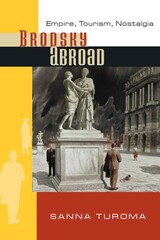 Brodsky Abroad: Empire, Tourism, Nostalgia
Sanna Turoma
University of Wisconsin Press, 2010 Expelled from the Soviet Union in 1972 and honored with the Nobel Prize fifteen years later, poet Joseph Brodsky in many ways fit the grand tradition of exiled writer. But Brodsky’s years of exile did not render him immobile: though he never returned to his beloved Leningrad, he was free to travel the world and write about it. In Brodsky Abroad, Sanna Turoma discusses Brodsky’s poems and essays about Mexico, Brazil, Turkey, and Venice. Challenging traditional conceptions behind Brodsky’s status as a leading émigré poet and major descendant of Russian and Euro-American modernism, she relocates the analysis of his travel texts in the diverse context of contemporary travel and its critique. Turoma views Brodsky’s travel writing as a response not only to his exile but also to the postmodern and postcolonial landscape that initially shaped the writing of these texts. In his Latin American encounters, Brodsky exhibits disdain for third-world politics and invokes the elegiac genre to reject Mexico’s postcolonial reality and to ironically embrace the romanticism of an earlier Russian and European imperial age. In an essay on Istanbul he assumes Russia’s ambiguous position between East and West as his own to negotiate a distinct, and controversial, interpretation of Orientalism. And, Venice, the emblematic tourist city, becomes the site for a reinvention of his lyric self as more fluid, hybrid, and cosmopolitan. Brodsky Abroad reveals the poet’s previously uncharted trajectory from alienated dissident to celebrated man of letters and offers new perspectives on the geopolitical, philosophical, and linguistic premises of his poetic imagination.
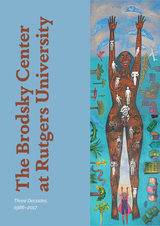 The Brodsky Center at Rutgers University: Three Decades, 1986-2017
Ferris Olin
Rutgers University Press, 2024 The Brodsky Center at Rutgers: Three Decades, 1986-2017, chronicles the history and artists involved with an internationally acclaimed print and papermaking studio at Rutgers University. Judith K. Brodsky conceived, founded, and directed the atelier, which, from its onset, provided state-of-the-arts technology and expertise for under-represented contemporary artists — women, Indigenous, and from diasporas of the African, Eastern European, Latin and Asian communities — to make innovative works on paper. These artistic creations presented new narratives to American and global visual arts from voices previously not heard or seen. Some of the artists featured in the book include Faith Ringgold, Elizabeth Catlett, Jaune Quick-to-See Smith, Miriam Schapiro, Pepón Osorio, Kiki Smith, and Richard Tuttle, among many other talented and influential printmakers and artists.
Published in partnership with the Zimmerli Museum.
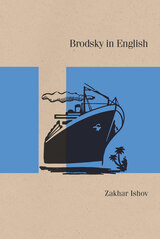 Brodsky in English
Zakhar Ishov
Northwestern University Press, 2023 A deeply researched account of Joseph Brodsky’s evolution in English as a self-translator and a poet in translation
Joseph Brodsky’s translations of his own Russian-language poems into English “new originals” have been criticized for their “un-Englishness,” an appraisal based on a narrow understanding of translation itself. With this radical reassessment of the Nobel Prize winner’s self-translations, Zakhar Ishov proposes a fresh approach to poetry translation and challenges the assumption that poetic form is untranslatable.
Brodsky in English draws on previously unexamined archival materials, including drafts and correspondence with translators and publishers, to trace the arc of Brodsky’s experience with the English language. Ishov shows how Brodsky’s belief in the intellectual continuity between his former life in the Soviet Union and his new career in the United States, including as Poet Laureate, anchored his insistence on maintaining the formal architecture of his poems in translation, locating the transmission of poetic meaning in the rhythms of language itself. This book highlights Brodsky’s place within the long history of the compromises translation must make between linguistic material and poetic process.
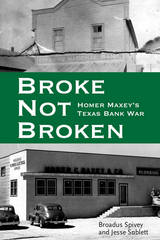 Broke, Not Broken: Homer Maxey's Texas Bank War
Broadus Spivey
Texas Tech University Press, 2014 A Homeric hero in an epic foreclosure battle
Homer Maxey was a war hero, multimillionaire, and pillar of the Lubbock, Texas, community. During the post-World War II boom, he filled the West Texas horizon with new apartment complexes, government buildings, hotels, banks, shopping centers, and subdivisions.
On the afternoon of February 16, 1966, executives of Citizens National Bank of Lubbock met to launch foreclosure proceedings against Maxey. In a secret sale, more than 35,000 acres of ranch land and other holdings were divided up and sold for pennies on the dollar. By closing time, Maxey was penniless.
Maxey sued the bank and every member of the board of directors, including long-time friends and business partners. Almost fifteen years, two jury trials, and nine separate appeals later, the case was settled on September 22, 1980.
Broke, Not Broken, the story of this record-breaking, precedent-setting legal case, illuminates a community and a self-styled go-getter who refused to back down, even when his opponents were old friends, well-heeled leaders of the community, a bank backed by powerful Odessa oil men, and the most formidable attorneys in West Texas.
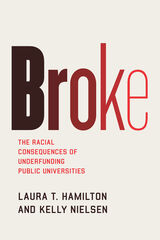 Broke: The Racial Consequences of Underfunding Public Universities
Laura T. Hamilton and Kelly Nielsen
University of Chicago Press, 2021 Public research universities were previously able to provide excellent education to white families thanks to healthy government funding. However, that funding has all but dried up in recent decades as historically underrepresented students have gained greater access, and now less prestigious public universities face major economic challenges.
In Broke, Laura T. Hamilton and Kelly Nielsen examine virtually all aspects of campus life to show how the new economic order in public universities, particularly at two campuses in the renowned University of California system, affects students. For most of the twentieth century, they show, less affluent families of color paid with their taxes for wealthy white students to attend universities where their own offspring were not welcome. That changed as a subset of public research universities, some quite old, opted for a “new” approach, making racially and economically marginalized youth the lifeblood of the university. These new universities, however, have been particularly hard hit by austerity. To survive, they’ve had to adapt, finding new ways to secure funding and trim costs—but ultimately it’s their students who pay the price, in decreased services and inadequate infrastructure.
The rise of new universities is a reminder that a world-class education for all is possible. Broke shows us how far we are from that ideal and sets out a path for how we could get there.
 Broken Ballots: Will Your Vote Count?
Douglas E. Jones and Barbara Simons
CSLI, 2012 For many of us, the presidential election of 2000 was a wake-up call. The controversy following the vote count led to demands for election reform. But the new voting systems that were subsequently introduced to the market have serious security flaws, and many are confusing and difficult to use. Moreover, legislation has not kept up with the constantly evolving voting technology, leaving little to no legal recourse when votes are improperly counted. How did we come to acquire the complex technology we now depend on to count votes? Douglas Jones and Barbara Simons probe this question, along with public policy and regulatory issues raised by our voting technologies. Broken Ballots is a thorough and incisive analysis of the current voting climate that approaches American elections from technological, legal, and historical perspectives. The authors examine the ways in which Americans vote today, gauging how inaccurate, unreliable, and insecure our voting systems are. An important book for election administrators, political scientists, and students of government and technology policy, Broken Ballots is also a vital tool for any voting American.
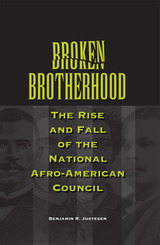 Broken Brotherhood: The Rise and Fall of the National Afro-American Council
Benjamin R. Justesen
Southern Illinois University Press, 2008 Broken Brotherhood: The Rise and Fall of the National Afro-American Council gives a comprehensive account of the National Afro-American Council, the first truly nationwide U.S. civil rights organization, which existed from 1898 to 1908. Based on exhaustive research, the volume chronicles the Council’s achievements and its annual meetings and provides portraits of its key leaders. Led by four of the most notable African American leaders of the time—journalist T. Thomas Fortune, Bishop Alexander Walters, educator Booker T. Washington, and Congressman George Henry White—the Council persevered for a decade despite structural flaws and external pressures that eventually led to its demise in 1908. Author Benjamin R. Justesen provides historical context for the Council’s development during an era of unprecedented growth in African American organizations. Justesen establishes the National Afro-American Council as the earliest national arena for discussions of critical social and political issues affecting African Americans and the single most important united voice lobbying for protection of the nation’s largest minority. In a period marked by racial segregation, widespread disfranchisement, and lynching violence, the nonpartisan council helped establish two more enduring successor organizations, providing core leadership for both the National Association for the Advancement of Colored People and the National Urban League. Broken Brotherhood traces the history of the Council and the complicated relationships among key leaders from its creation in Rochester in 1898 to its last gathering in Baltimore in 1907, drawing on both private correspondence and contemporary journalism to create a balanced historical portrait. Enhanced by thirteen illustrations, the volume also provides intriguing details about the ten national gatherings, describes the Council’s unsuccessful attempt to challenge disfranchisement before the U.S. Supreme Court, and sheds light on the gradual breakdown of Republican solidarity among African American leaders in the first decade of the twentieth century.
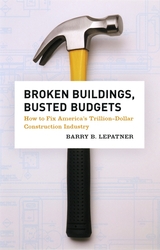 Broken Buildings, Busted Budgets: How to Fix America's Trillion-Dollar Construction Industry
Barry B. LePatner with Robert E. Wright and Timothy C. Jacobson
University of Chicago Press, 2007 Across the nation, construction projects large and small—from hospitals to schools to simple home improvements—are spiraling out of control. Delays and cost overruns have come to seem “normal,” even as they drain our wallets and send our blood pressure skyrocketing. In Broken Buildings, Busted Budgets, prominent construction attorney Barry B. LePatner builds a powerful case for change in America’s sole remaining “mom and pop” industry—an industry that consumes $1.23 trillion and wastes at least $120 billion each year.
With three decades of experience representing clients that include eminent architects and engineers, as well as corporations, institutions, and developers, LePatner has firsthand knowledge of the bad management, ineffective supervision, and insufficient investment in technology that plagues the risk-averse construction industry. In an engaging and direct style, he here pinpoints the issues that underlie the industry’s woes while providing practical tips for anyone in the business of building, including advice on the precise language owners should use during contract negotiations.
Armed with Broken Buildings, Busted Budgets, everyone involved in the purchase or renovation of a building or any structure—from homeowners seeking to remodel to civic developers embarking on large-scale projects—has the information they need to change this antiquated industry, one project at a time.
“LePatner describes what is wrong with the current system and suggests ways that architects can help—by retaking their rightful place as master builders.”—Fred A. Bernstein, Architect Magazine “Every now and then, a major construction project is completed on time and on budget. Everyone is amazed. . . . Barry LePatner thinks this exception should become the rule. . . . A swift kick to the construction industry.”—James R. Hagerty, Wall Street Journal
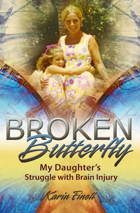 Broken Butterfly: My Daughter's Struggle with Brain Injury
Karin Finell
University of Missouri Press, 2012 “It all began with the bite of a mosquito. Yes, with a bite of this pesky, but seemingly so innocuous little insect that had been sucking her blood. Not just one, but hundreds had punctured her arms and legs with red marks which later swelled to small welts. Who would ever have thought that our family's life would become derailed, that its tightly woven fabric would eventually fray and break—all from the bite of a mosquito?” In November of 1970, the Finell family’s lives were changed forever by a family vacation to Acapulco. Seven-year-old Stephanie fell ill soon after their return to the United States, but her mother, Karin, thinking it was an intestinal disorder, kept her home from school for a few days. She was completely unprepared when Stephanie went into violent convulsions on a Friday morning. Following a series of tests at the hospital, doctors concluded she had contracted viral equine encephalitis while in Mexico. After a string of massive seizures—one leading to cardiac arrest—Stephanie fell into a six-week coma. When she awoke, her world had changed from predictable and comforting to one where the ground was shaking. Due to the swelling of her brain from encephalitis, she suffered serious brain damage. Doctors saw little hope of recovery for Stephanie and encouraged her parents to place her in an institution, but they refused. In Broken Butterfly, Karin Finell recounts the struggles faced by both her and her daughter, as well as the small victories won over the ensuing years. Little was known about brain injuries during that time, and Karin was forced to improvise, relying on her instincts, to treat Stephanie. Despite the toll on the family—alcoholism, divorce, and estrangement—Karin never gave up hope for Stephanie’s recovery. By chance, Karin heard of the Marianne Frostig Center of Educational Therapy, where Dr. Frostig herself took over the “reprogramming” of Stephanie’s brain. This, in time, led her to regain her speech and some motor skills. Unfortunately, Stephanie’s intermittent seizures hung like the proverbial “Sword of Damocles” over their lives. And while Stephanie grew into a lovely young woman, her lack of judgment resulting from her injury led her into situations of great danger that required Karin to rescue her. Karin’s love for her daughter guided her to allow Stephanie to fill her life with as many positive experiences as possible. Stephanie learned and matured through travel and exposure to music and plays,acquiring a knowledge she could not learn from books. Stephanie wished above all to teach other brain injured individuals to never look down on themselves but to live their lives to the fullest. Through Stephanie’s story, her mother has found a way to share that optimism and her lessons with the world.
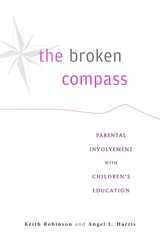 The Broken Compass: Parental Involvement with Children's Education
Keith Robinson and Angel L. Harris
Harvard University Press, 2014 It seems like common sense that children do better when parents are actively involved in their schooling. But how well does the evidence stack up? The Broken Compass puts this question to the test in the most thorough scientific investigation to date of how parents across socioeconomic and ethnic groups contribute to the academic performance of K-12 children. The study's surprising discovery is that no clear connection exists between parental involvement and improved student performance.
Keith Robinson and Angel Harris assessed over sixty measures of parental participation, at home and in school. Some of the associations they found between socioeconomic status and educational involvement were consistent with past studies. Yet other results ran contrary to previous research and popular perceptions. It is not the case that Hispanic and African American parents are less concerned with education than other ethnic groups--or that "tiger parenting" among Asian Americans gets the desired results. In fact, many low-income parents across a wide spectrum want to be involved in their children's school lives, but they often receive little support from the school system. And for immigrant families, language barriers only worsen the problem.
While Robinson and Harris do not wish to discourage parents' interest, they believe that the time has come to seriously reconsider whether greater parental involvement can make much of a dent in the basic problems facing their children's education today. This provocative study challenges some of our most cherished beliefs about the role of family in educational success.
The Broken Covenant: American Civil Religion in Time of Trial
Robert N. Bellah
University of Chicago Press, 1992 This Second Edition represents Bellah's summation of his views on civil religion in America. In his 1967 classic essay "Civil Rights in America," Bellah argued that the religious dimensions of American society—as distinct from its churches—has its own integrity and required "the same care in understanding that any religion."
This edition includes his 1978 article "Religion and the Legitimation of the American Republic," and a new Preface.
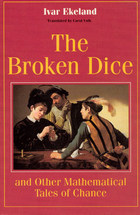 The Broken Dice, and Other Mathematical Tales of Chance
Ivar Ekeland
University of Chicago Press, 1993 Ivar Ekeland extends his consideration of the catastrophe theory of the universe begun in his widely acclaimed Mathematics and the Unexpected, by drawing on rich literary sources, particularly the Norse saga of Saint Olaf, and such current topics as chaos theory, information theory, and particle physics.
"Ivar Ekeland gained a large and enthusiastic following with Mathematics and the Unexpected, a brilliant and charming exposition of fundamental new discoveries in the theory of dynamical systems. The Broken Dice continues the same theme, and in the same elegant, seemingly effortless style, but focuses more closely on the implications of those discoveries for the rest of human culture. What are chance and probability? How has our thinking about them been changed by the discovery of chaos? What are all of these concepts good for? . . . Ah, but, I mustn't give the game away, any more than I should if I were reviewing a detective novel. And this is just as gripping a tale. . . . Beg, borrow, or preferably buy a copy. . . . I guarantee you won't be disappointed."—Ian Stewart, Science
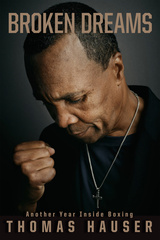 Broken Dreams: Another Year Inside Boxing
Thomas Hauser
University of Arkansas Press, 2021 Each year, readers, writers, and critics alike look forward to Thomas Hauser’s newest collection of articles about the contemporary boxing scene. As Booklist has proclaimed, “Many journalists have written fine boxing pieces, but none has written as extensively or as memorably as Thomas Hauser. . . . Hauser remains the current champion of boxing. . . . Hauser is a treasure.” Broken Dreams meets this high standard with its coverage of 2020’s most important fighters and fights, outside-the-ring controversies, regulatory missteps, and other issues that defined the year’s boxing scene. Hauser explores the heavyweight trio of Tyson Fury, Anthony Joshua, and Deontay Wilder in depth, as well as Canelo Álvarez and historic greats like Jack Dempsey, Carlos Monzon, and Muhammad Ali. Hauser also tackles the larger social challenges that imposed themselves so assertively in 2020, including the coronavirus pandemic, the Black Lives Matter movement, runaway social media, the presidential election, and other forces that left a deep imprint on the sport and business of boxing.
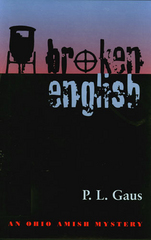 Broken English: An Amish Country Mystery
P. L. Gaus
Ohio University Press, 2000 Broken English is a tale of honor, deception, and revenge, one in which circumstances and the search for justice test the mettle of the closest of friends and reveal the desperate measures of the strongest of foes. Following on the critical and popular success of P. L. Gaus’ acclaimed Amish mystery series, this new edition of Broken English includes an exclusive interview with the author, discussion questions for reading groups, and a detailed map and driving guide to Holmes County, Ohio, with everything one needs to visit the iconic scenes depicted in the story. The peaceful town of Millersburg, Ohio, in the heart of Amish country, is rocked by the vicious murder of a woman at the hands of an ex-convict. When a local reporter covering the story turns up dead, while the convict is already behind bars, suspicion falls on David Hawkins, the first victim’s father. With Hawkins nowhere to be found among the protective Amish community that had taken him in as one of its own, Professor Michael Branden, Sheriff Bruce Robertson, and Pastor Cal Troyer set out to uncover the elusive truth in this otherwise quiet corner of the world.
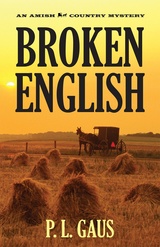 Broken English: An Amish Country Mystery
P. L. Gaus
Ohio University Press, 2000 Broken English is a tale of honor, deception, and revenge, one in which circumstances and the search for justice test the mettle of the closest of friends and reveal the desperate measures of the strongest of foes. Following on the critical and popular success of P. L. Gaus’ acclaimed Amish mystery series, this new edition of Broken English includes an exclusive interview with the author, discussion questions for reading groups, and a detailed map and driving guide to Holmes County, Ohio, with everything one needs to visit the iconic scenes depicted in the story. The peaceful town of Millersburg, Ohio, in the heart of Amish country, is rocked by the vicious murder of a woman at the hands of an ex-convict. When a local reporter covering the story turns up dead, while the convict is already behind bars, suspicion falls on David Hawkins, the first victim’s father. With Hawkins nowhere to be found among the protective Amish community that had taken him in as one of its own, Professor Michael Branden, Sheriff Bruce Robertson, and Pastor Cal Troyer set out to uncover the elusive truth in this otherwise quiet corner of the world.
 Broken Government?
Edited by Iwan Morgan and Philip D. Davies
University of London Press, 2013 Barack Obama's election as president in 2008 generated widespread hope that the United States was entering a new era whereby government, in a reversal of Ronald Reagan's famous dictum, would be the solution to the nation's manifold problems amid the worst economic downturn since the Great Depression. The Obama election slogan of ""Yes We Can"" seemed to voice a hope that new leadership would put right what had gone wrong with America. Anticipating a new era of government activism, some commentators read the death rites on ""The Age of Reagan,"" the post-1980 anti-statist trend of American politics. Within a short time, however, ""Yes We Can"" gave way to ""No We Can't,"" as America's government became enmeshed in gridlock and political polarization. The contributors to Broken Government? add their voices to the debate on whether American government truly is broken and, if so, what can be done to fix it.
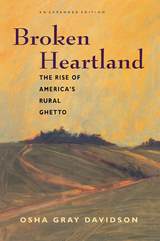 Broken Heartland: The Rise of America's Rural Ghetto
Osha Gray Davidson
University of Iowa Press, 1996 Between 1940 and the mid 1980s, farm production expenses in America's Heartland tripled, capital purchases quadrupled, interest payments jumped tenfold, profits fell by 10 percent, the number of farmers decreased by two-thirds, and nearly every farming community lost population, businesses, and economic stability. Growth for these desperate communities has come to mean low-paying part-time jobs, expensive tax concessions, waste dumps, and industrial hog farming, all of which come with environmental and psychological price tags. In Broken Heartland, Osha Gray Davidson chronicles the decline of the Heartland and its transformation into a bitterly divided and isolated regional ghetto. Through interviews with more than two hundred farmers, social workers, government officials, and scholars, he puts a human face on the farm crisis of the 1980s. In this expanded edition Davidson emphasizes the tenacious power of far-right-wing groups; his chapter on these burgeoning rural organizations in the original edition of Broken Heartland was the first in-depth look—six years before of the Oklahoma City bombing—at the politics of hate they nurture. He also spotlights NAFTA, hog lots, sustainable agriculture, and the other battles and changes over the past six years in rural America.
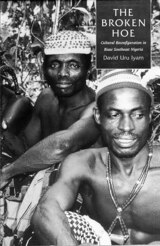 The Broken Hoe: Cultural Reconfiguration in Biase Southeast Nigeria
David Uru Iyam
University of Chicago Press, 1995 In this study of the Biase, a small ethnic group living in Nigeria's Cross River State, David Uru Iyam attempts to resolve a long-standing controversy among development theorists: must Third World peoples adopt Western attitudes, practices, and technologies to improve their standard of living or are indigenous beliefs, technologies, and strategies better suited to local conditions?
The Biase today face social and economic pressures that seriously strain their ability to cope with the realities of modern Nigeria. Iyam, an anthropologist and a Biase, examines the relationship between culture and development as played out in projects in local communities.
Western technologies and beliefs alone cannot ensure economic growth and modernization, Iyam shows, and should not necessarily be imposed on poor rural groups who may not be prepared to incorporate them; neither, however, is it possible to recover indigenous coping strategies given the complexities of the postcolonial world. A successful development strategy, Iyam argues, needs to strengthen local managerial capacity, and he offers suggestions as to how this can be done in a range of cultural and social settings.
Broken K Pueblo: Prehistoric Social Organization in the American Southwest
James N. Hill
University of Arizona Press, 1970 This report presents an analysis of a prehistoric Pueblo community in structural, functional, and evolutionary terms; it is a sequel to William A. Longacre's Archaeology as Anthropology. The emphasis is on social organization (including the patterning of community activities) and on understanding changes in this organization in terms of adaptive responses to a shifting environment.
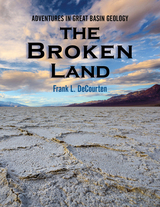 The Broken Land: Adventures in Great Basin Geology
Frank DeCourten
University of Utah Press, 2003 "The desert may seem timeless from within the Yellow Circle tonight, but the permanence of the surrounding landscape is only an illusion. Even the land is alive here, constantly changing and evolving as do all living things. Nothing here is 'finished.' Everything around us—the plants, the animals, the rocks, and the terrain itself—is in the process of becoming something else. And, of course, so are we. None of us around the campfire tonight are the same people we were yesterday, or will be tomorrow."—from the book The Broken Land surveys the geological phenomena of the magnificent Great Basin landscape of western Utah, Nevada, eastern California, and adjacent regions. Each chapter focuses on a locality or area that provides insight into the deep history of one of North America's most remote regions—one of its continental margins. It is the only book available covering the geology of the entire Great Basin. Written for anyone with a casual to serious interest in natural history, The Broken Land conveys Frank DeCourten's awe at the story written in the rock of the basin.
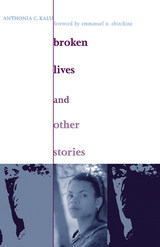 Broken Lives and Other Stories: Ris Af#79
Anthonia C. Kalu
Ohio University Press, 2003 In her startling collection of short stories, Broken Lives and Other Stories, Anthonia C. Kalu creates a series of memorable characters who struggle to hold displaced but dynamic communities together in a country that is at war with itself. Broken Lives and Other Stories presents a portrait of the ordinary women, children, and men whose lives have been battered by war in their homeland. Written in response to the Nigerian Civil War, known on the Igbo side as Ogu Biafra—the Biafran War—this collection focuses on the everyday conditions of the local people and how their personal situations became entangled in national crises. The stories capture a diversity of issues, from the implications of self-rule and the presence of soldiers among civilians, to masquerades, air raids, and rape. Through her riveting narratives, Kalu draws the reader into the depths of some of Africa’s most troubling issues, such as the concern for safety during the frequent outbreaks of hostilities, which can range from civil unrest to armed combat. How do young people, women, and the elderly cope during those crises? Are the struggles for national political power greater than the everyday struggle for decent living by the person on the street? While conveying the vitality and joy of Africa’s women and youth, Broken Lives and Other Stories also examines the impact of the brain drain caused by wars and instability within the continent itself. Both the war against women and women’s constant war to survive in contemporary Africa are brought into sharp focus throughout these stories. For readers interested in the last thirty-five years of unrest across Africa, this collection is essential reading.
 Broken Masculinities: Solitude, Alienation, and Frustration in Turkish Literature after 1970
Cimen Günay-Erkol
Central European University Press, 2016 Broken Masculinities portrays the post-dictatorial novel of the 1970s in all its complexity, and introduces the reader to a 1968-era Turkey, a period which challenges Turkey’s now reinforced Islamic image by portraying the quest for sexual liberation and critical student uprisings. Günay-Erkol argues that the literature written after the 1971 coup in Turkey constitutes a coherent sub-genre and needs to be considered together. These novels share a common ground which is rich in images of men and women craving for power: general isolation, sexual-emotional frustration, and a traumatic sense of solitude and alienation. This book is an original and significant contribution to two major fields of study: (1) gender and sexuality with respect to formation of subjectivity through literature, and (2) modern literature and history through the study of Turkish literature. The chief concern in this book is not only literature’s response to a particular period in Turkey, but also the role of literature in bearing witness to trauma and drastic political acts of violence—and coming to terms with them.B
Broken Mirrors/Broken Minds: The Dark Dreams of Dario Argento
Maitland McDonagh
University of Minnesota Press, 2010 Italian filmmaker Dario Argento’s horror films have been described as a blend of Alfred Hitchcock and George Romero—psychologically rich, colorful, and at times garish, excelling at taking the best elements of the splatter and exploitation genres and laying them over a dark undercurrent of human emotions and psyches. Broken Mirrors/Broken Minds, which dissects such Argento cult films as Two Evil Eyes, The Bird with the Crystal Plumage, Suspiria, and Deep Red, includes a new introduction discussing Argento’s most recent films, from The Stendahl Syndrome to Mother of Tears; an updated filmography; and an interview with Argento.
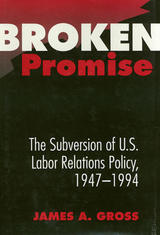 Broken Promise: The Subversion Of U.S. Labor Relations
James A. Gross
Temple University Press, 2003 The Wagner Act of 1935 (later the Wagner-Taft-Hartley Act of 1947) was intended to democratize vast numbers of American workplaces: the federal government was to encourage worker organization and the substitution of collective bargaining for employers' unilateral determination of vital work-place matters. Yet this system of industrial democracy was never realized; the promise was "broken." In this rare inside look at the process of government regulation over the last forty-five years, James A. Gross analyzes why the promise of the policy was never fulfilled. Gross looks at how the National Labor Relations Board's (NLRB) policy-making has been influenced by the President, the Congress, the Supreme Court, public opinion, resistance by organized employers, the political and economic strategies of organized labor, and the ideological dispositions of NLRB appointees. This book provides the historical perspective needed for a reevaluation of national labor policy. It delineates where we are now, how we got here, and what fundamental questions must be addressed if policy-makers are to make changes consistent with the underlying principles of democracy.
 Broken Promises, Broken Dreams: Stories of Jewish and Palestinian Trauma and Resilience
Alice Rothchild
Pluto Press, 2010 The tragedies of the conflict between Israelis and Palestinians are never far from the pages of the mainstream press. Yet it is rare to hear about the reality of life on the ground -- and it is rarer still when these voices belong to women.
This book records the journey of a Jewish American physician travelling and working within Israel and the Occupied Territories. Alice Rothchild grew up in a family grounded by the traumas of the Holocaust and passionately devoted to Israel. This book recounts her experiences as she grapples with the reality of life in Israel and the hardships of Palestinians living in the West Bank and Gaza.
The new edition includes a new preface, two chapters on Israeli dissent and a chapter which explores the impact of a Palestinian home demolition and the work of Israeli soldiers and Palestinian fighters who have joined together to form Combatants for Peace.
Ultimately, the book raises troubling questions regarding US policy and the mainstream Jewish community's insistence on giving unquestioning support to all Israeli policy.
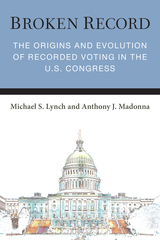 Broken Record: The Origins and Evolution of Recorded Voting in the U.S. Congress
Michael S. Lynch & Anthony J. Madonna
University of Michigan Press, 2025 Since the 1920s, the roll call voting record has influenced American politics. Using recorded votes, candidates attack electoral opponents, interest groups attempt to drum up financial or electoral support for their preferred candidates, scholars test theories of legislative behavior, and the media characterizes the ideological leanings of Congress. Despite this, there has not been a systematic attempt to document the changing usage of the roll call record. Michael S. Lynch and Anthony J. Madonna have undertaken a massive, multiyear data collection effort that culminated in four new datasets covering from 1905 to the contemporary period. Using data on approximately 120,000 amendments, 60,000 roll call votes, 2,000 important enactments, and 8,000 special rules from 1905 to 2015, the authors demonstrate how the roll call recording system has evolved.
Consistent with the Founders’ skepticism of the impact of recorded voting in Congress, Broken Record shows that the contemporary roll call voting record includes far more meaningless position-taking and procedural roll call votes than it did during earlier congresses. The book argues that the removal of practical barriers to roll calls, internal changes to legislative procedures, and increased electoral competitiveness have led to more roll call votes on proposals sponsored by more extreme members. In addition to policy making being more difficult, increased roll call voting has played a substantial role in artificially increasing observed levels of polarization. This book argues that solving polarization requires a more nuanced set of solutions than simply replacing legislators; it will require increased public education about how Congress operates and specific procedural reforms.
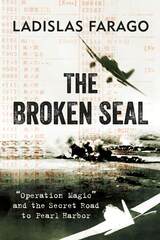 The Broken Seal: "Operation Magic" and the Secret Road to Pearl Harbor
Ladislas Farago
Westholme Publishing, 1967 The Important Study That Evaluates the Intelligence War Behind the Japanese Surprise Attack
“In this fascinating account. . . . Mr. Farago’s investigation suggests that the real villain was the system itself.”—New York Times
“In this well-written and informative account. . . Mr. Farago provides many new facts from both American and Japanese sources.”—Library Journal
“A good history of Japanese and American code-breaking operations between 1921 and December 7, 1941. . . . Farago is important because in this technical study of cryptology he has arrived independently at the same general conclusion as did the non-revisionist diplomatic historians: there was no plot by Roosevelt or his advisers.”—Choice
“His conclusions should act as a corrective to the enthusiasts who claim that intelligence always provides the complete answer.”—Times Literary Supplement
The Broken Seal: The Story of “Operation Magic” and the Pearl Harbor Disaster explores the questions of why, if the United States knew the Japanese codes, did we not anticipate the December 7, 1941 surprise attack and how did the Japanese spy system in Hawaii operate? As a chief of research and planning in the Special Warfare Branch of the Office of Naval Intelligence, the author had access to both Japanese and American classified material to write this study. The author’s intent was to independently ascertain the validity of earlier claims that the Pearl Harbor attack could have been avoided. The result is an eminently readable and engrossing story, first published in 1968, of the relationship between America and Japan in the interwar years and the relentless cat-and-mouse intelligence game conducted by both sides. Despite more recent suppositions that there was a conspiracy among American and British officials to ignore warnings of a Japanese attack that had been gleaned from deciphered diplomatic codes in order to force America into a world war, the author confirms that human error and misjudgment and the actual state of intelligence interpretation at the time made an accurate assessment of Japanese intentions impossible.
 Broken Silences: Interviews with Black and White Women Writers
Edited by Shirley M Jordan
Rutgers University Press, 1993 From Publishers Weekly
In these 20 interviews with women writers of fiction, Jordan, who teaches at Hampton University in Virginia, attempts to plumb the relations between black and white women in fiction and in life, and to explore the creative process. Although the book suffers from lengthy discussions of somewhat obscure work, the interviewees, most of whom have portrayed female characters of a race other than their own, offer intriguing, often conflicting observations about the primacy of race, gender or class. Kaye Gibbons ( Ellen Foster ) suggests that rural locations offer commonality to black and white Southern women; Marita Golden ( Long Distance Life ) observes that white writers emphasize female beauty while black writers focus on character. This book may be a useful supplement to literature courses.
From Library Journal
The message derived from the candid and articulate women interviewed here is, as Belva Plain states, "you learn as you live together." Editor Jordan (Hampton Univ., Virginia) has opened a dialog on writing and race relations by publishing these interviews with 20 significant contemporary black and white women writers, from Alice Childress and Joyce Carol Oates to Mildred Pitts Walker. The substance of these writers' thoughts is that the commonality of women's experience informs the genuine portrayal of a character as much as does the writer's understanding of her blackness or whiteness. This special book, so different from others that examine the writing process, is likely to stimulate dialog among women and to provoke serious study of many excellent women writers working today. Recommended for all collections supporting the study of literature, women's studies, and race relations.
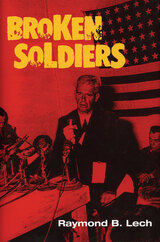 Broken Soldiers
Raymond B. Lech
University of Illinois Press, 2000 Traversing the no-man's-land of political loyalty and betrayal, Broken Soldiers documents the fierce battle for the minds and hearts of American prisoners during the Korean War. In scorching detail, Raymond Lech describes the soldiers' day-to-day experiences in prisoner-of-war camps and the shocking treatment some of them received at the hands of their own countrymen after the war. Why, he asks, were only fourteen American soldiers tried as collaborators when thousands of others who admitted to some of the same offenses were not?
Drawing on some 60,000 pages of court-martial transcripts Lech secured through the Freedom of Information Act, Broken Soldiers documents the appalling treatment and the sophisticated propagandizing to which American POWs fell victim during the Korean conflict. Three thousand American soldiers perished in North Korean camps over the winter of 1950-51, most from starvation. Through the unsentimental testimony of survivors, Lech describes how these young men, filthy and lice-infested, lost an average of 40 percent of their body weight. Many also lost their powers of resistance and their grip on soldierly conduct.
After six months of starvation, the emaciated, disoriented prisoners were subjected to a relentless campaign to educate them to the virtues of communism. Bombarded with propaganda, the Americans were organized into study groups and forced to discuss and write about communism and Marxism, even to broadcast harangues against capitalist aggression and appeals for an end to the war.
Lech traces the spiral of debilitation and compromise, showing how parroting certain phrases came to seem a small price to pay for physical safety. Threatened with starvation and indefinite confinement in Korea, many POWs succumbed to pressure to mouth communist slogans and provide information far in excess of the regulation "name, rank, and service number."
Of the thousands of American soldiers who, while prisoners in North Korea, spoke and wrote favorably of communism and disparaged their country, a handful were charged with collaborating with the enemy. Why were so few singled out? Why did each branch of the armed services judge parallel circumstances differently, and why were American soldiers not realistically prepared for capture? A powerful indictment of justice miscarried, Broken Soldiers raises troubling questions that remain unanswered decades after the events.
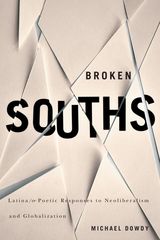 Broken Souths: Latina/o Poetic Responses to Neoliberalism and Globalization
Michael Dowdy
University of Arizona Press, 2013 Broken Souths offers the first in-depth study of the diverse field of contemporary Latina/o poetry. Its innovative angle of approach puts Latina/o and Latin American poets into sustained conversation in original and rewarding ways. In addition, author Michael Dowdy presents ecocritical readings that foreground the environmental dimensions of current Latina/o poetics.
Dowdy argues that a transnational Latina/o imaginary has emerged in response to neoliberalism—the free-market philosophy that underpins what many in the northern hemisphere refer to as “globalization.” His work examines how poets represent the places that have been “broken” by globalization’s political, economic, and environmental upheavals. Broken Souths locates the roots of the new imaginary in 1968, when the Mexican student movement crested and the Chicano and Nuyorican movements emerged in the United States. It theorizes that Latina/o poetics negotiates tensions between the late 1960s’ oppositional, collective identities and the present day’s radical individualisms and discourses of assimilation, including the “post-colonial,” “post-national,” and “post-revolutionary.” Dowdy is particularly interested in how Latina/o poetics reframes debates in cultural studies and critical geography on the relation between place, space, and nature.
Broken Souths features discussions of Latina/o writers such as Victor Hernández Cruz, Martín Espada, Juan Felipe Herrera, Guillermo Verdecchia, Marcos McPeek Villatoro, Maurice Kilwein Guevara, Judith Ortiz Cofer, Jack Agüeros, Marjorie Agosín, Valerie Martínez, and Ariel Dorfman, alongside discussions of influential Latin American writers, including Roberto Bolaño, Ernesto Cardenal, David Huerta, José Emilio Pacheco, and Raúl Zurita.
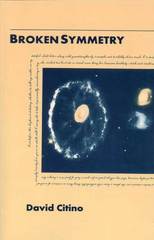 BROKEN SYMMETRY
DAVID CITINO
Ohio State University Press, 1997 In this, David Citino's eighth full-length collection, a poet approaching the end of the twentieth century takes stock of a single life: of its family and culture, history, and beliefs; of the contemporary forces of nature, science politics, gender, and myth that shape and misshape it; of the land--and even the body--it calls home.
These are poems that take a hard look at the experience of one individual, but always in terms of place and context, and other lives. Employing "broken symmetry"--a term from high energy physics for a state in which traces of an earlier symmetry can be found--as a description of the contemporary fractured world and his own fitfully declining health, Citino seeks to know whether an unbroken symmetry ever existed, or whether it is human nature to believe fervently in some lost golden age.
Readers familiar with the work of David Citino will recognize the territories and obsessions this fine poet has explored over the past twenty years. Here are poems that investigate the credentials of saints, secular and religious; poems that seek to know how the ghosts of history come to haunt the future through the present; poems spoken by the redoubtable Sister Mary Appassionata, a character driven to believe ardently everything she is told, everything she imagines; poems that evoke the urban and rural and even moral landscapes of Ohio. And there are poems that take up new concerns and cover new territory--dire, contemporary warnings, public and personal news that disturbs, myths just now coming into being.
These are passionate, accessible poems in which, singing of joy and sorrow, certitude and doubt, a poet wonders what a life is worth.
David Citino is Poet Laureate and professor of English and creative writing at The Ohio State University
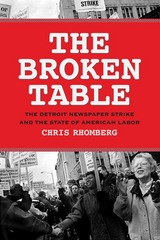 The Broken Table: The Detroit Newspaper Strike and the State of American Labor
Chris Rhomberg
Russell Sage Foundation, 2012 When the Detroit newspaper strike was settled in December 2000, it marked the end of five years of bitter and violent dispute. No fewer than six local unions, representing 2,500 employees, struck against the Detroit News, the Detroit Free Press, and their corporate owners, charging unfair labor practices. The newspapers hired permanent replacement workers and paid millions of dollars for private security and police enforcement; the unions and their supporters took their struggle to the streets by organizing a widespread circulation and advertising boycott, conducting civil disobedience, and publishing a weekly strike newspaper. In the end, unions were forced to settle contracts on management's terms, and fired strikers received no amnesty. In The Broken Table, Chris Rhomberg sees the Detroit newspaper strike as a historic collision of two opposing forces: a system in place since the New Deal governing disputes between labor and management, and decades of increasingly aggressive corporate efforts to eliminate unions. As a consequence, one of the fundamental institutions of American labor relations—the negotiation table—has been broken, Rhomberg argues, leaving the future of the collective bargaining relationship and democratic workplace governance in question. The Broken Table uses interview and archival research to explore the historical trajectory of this breakdown, its effect on workers' economic outlook, and the possibility of restoring democratic governance to the business-labor relationship. Emerging from the New Deal, the 1935 National Labor Relations Act protected the practice of collective bargaining and workers' rights to negotiate the terms and conditions of their employment by legally recognizing union representation. This system became central to the democratic workplace, where workers and management were collective stakeholders. But efforts to erode the legal protections of the NLRA began immediately, leading to a parallel track of anti-unionism that began to gain ascendancy in the 1980s. The Broken Table shows how the tension created by these two opposing forces came to a head after a series of key labor disputes over the preceding decades culminated in the Detroit newspaper strike. Detroit union leadership charged management with unfair labor practices after employers had unilaterally limited the unions' ability to bargain over compensation and work conditions. Rhomberg argues that, in the face of management claims of absolute authority, the strike was an attempt by unions to defend workers' rights and the institution of collective bargaining, and to stem the rising tide of post-1980s anti-unionism. In an era when the incidence of strikes in the United States has been drastically reduced, the 1995 Detroit newspaper strike stands out as one of the largest and longest work stoppages in the past two decades. A riveting read full of sharp analysis, The Broken Table revisits the Detroit case in order to show the ways this strike signaled the new terrain in labor-management conflict. The book raises broader questions of workplace governance and accountability that affect us all.
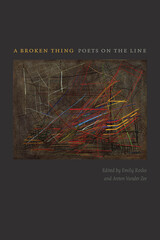 A Broken Thing: Poets on the Line
Emily Rosko and Anton Vander Zee
University of Iowa Press, 2011 In the arena of poetry and poetics over the past century, no idea has been more alive and contentious than the idea of form, and no aspect of form has more emphatically sponsored this marked formal concern than the line. But what, exactly, is the line? Emily Rosko and Anton Vander Zee’s anthology gives seventy original answers that lead us deeper into the world of poetry, but also far out into the world at large: its people, its politics, its ecology. The authors included here, emerging and established alike, write from a range of perspectives, in terms of both aesthetics and identity. Together, they offer a dynamic hybrid collection that captures a broad spectrum of poetic practice in the twenty-first century. Rosko and Vander Zee’s introduction offers a generous overview of conversations about the line from the Romantics forward. We come to see how the line might be an engine for ideals of progress—political, ethical, or otherwise. For some poets, the line touches upon the most fundamental questions of knowledge and existence. More than ever, the line is the radical against which even alternate and emerging poetic forms that foreground the visual or the auditory, the page or the screen, can be distinguished and understood. From the start, a singular lesson emerges: lines do not form meaning solely in their brevity or their length, in their becoming or their brokenness; lines live in and through the descriptions we give them. Indeed, the history of American poetry in the twentieth century could be told by the compounding, and often confounding, discussions of its lines. A Broken Thing both reflects upon and extends this history, charting a rich diffusion of theory and practice into the twenty-first century with the most diverse, wide-ranging and engaging set of essays to date on the line in poetry, revealing how poems work and why poetry continues to matter.
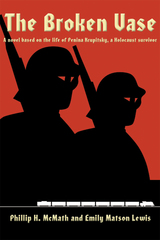 The Broken Vase: A Novel Based On the Life of Penina Krupitsky, a Holocaust Survivor
Phillip H. McMath
Butler Center for Arkansas Studies, 2010 The Broken Vase is a roman à clef ("novel with a key," or novel based on real life) written by Phillip H. McMath based upon research done by his co-author, Emily Matson Lewis, and in close collaboration with Holocaust survivor Penina Krupitsky, who appears in the novel as the fictional Miriam Kellerman. With the help of the World Jewish Organization, Mrs. Krupitsky emigrated from the Soviet Union with her family to the United States and now lives in Arkansas. Born to middle-class parents in July 1924 in North Bukovina, Romania (now Chernivtsi, Ukraine), Miriam Kellerman grows up in an atmosphere of culture and privilege that is interrupted when her country is invaded—first by Stalin in July 1940, then by Hitler in June 1941. Fearing for their lives, Jews like Miriam begin to flee into the Soviet Union to escape the German advance. Separated from her parents, Deborah and Max, and later from her fiancé, Isaac, Miriam finds herself alone and on foot, trudging ever eastward. This novel's compelling narrative chronicles her incredible struggle to stay alive as World War II rages. Mrs. Krupitsky lives in Little Rock with her husband, children, and grandchildren. She remains active in Holocaust remembrance organizations around the world and says that she wants The Broken Vase "to help young people and become an inspiration to them. It will teach them how to build a world of love and not of hatred."
 The Broken Wave: The Chinese Communist Peasant Movement, 1922-1928
Roy Hofheinz, Jr.
Harvard University Press, 1977 This book is a sophisticated and deeply researched volume on Mao Tse-tung's early leadership and on the formative years of the Chinese Communist Peasant movement. It has been axiomatic in Asian studies that knowledge of the early years of Chinese communism would throw the most light on modern happenings. In this landmark volume, Hofheinz provides the much-needed map for understanding.
Hofheinz shows how the rural revolution began, dissects with exquisite care the mentalities of the first leaders, and assesses the early gropings of peasant revolutionaries toward class struggle. He explains why Mao and others came to believe that the huge rural population was the most powerful force in China and that warfare against any visible enemies constituted progress for the Communist cause. Yet the first Chinese Communists failed miserably both as members of the Kuomintang coalition and on their own.
The reasons for the great debacle of the 1920s are set out in this book for the first time in all their complexity. As important as this history is, Hofheinz declares, the lessons Mao learned from his defeats are of even greater significance. Mao and his followers shaped every decision in later years to avoid the errors of the past. The author demonstrates how Mao used ruralism, militarization, worship of numbers and not territory, and a fierce autonomy from other political groups to gain his ends.
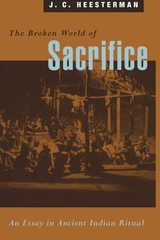 The Broken World of Sacrifice: An Essay in Ancient Indian Ritual
J. C. Heesterman
University of Chicago Press, 1993 In this book, J. C. Heesterman attempts to understand the origins and nature of Vedic sacrifice—the complex compound of ritual practices that stood at the center of ancient Indian religion.
Paying close attention to anomalous elements within both the Vedic ritual texts, the brahmanas, and the ritual manuals, the srautasutras, Heesterman reconstructs the ideal sacrifice as consisting of four moments: killing, destruction, feasting, and contest. He shows that Vedic sacrifice all but exclusively stressed the offering in the fire—the element of destruction—at the expense of the other elements. Notably, the contest was radically eliminated. At the same time sacrifice was withdrawn from society to become the sole concern of the individual sacrificer. The ritual turns in on the individual as "self-sacrificer" who realizes through the internalized knowledge of the ritual the immortal Self. At this point the sacrificial cult of the fire recedes behind doctrine of the atman's transcendence and unity with the cosmic principle, the brahman.
Based on his intensive analysis Heesterman argues that Vedic sacrifice was primarily concerned with the broken world of the warrior and sacrificer. This world, already broken in itself by the violence of the sacrificial contest, was definitively broken up and replaced with the ritrualism of the single, unopposed sacrificer. However, the basic problem of sacrifice—the riddle of life and death—keeps breaking too surface in the form of incongruities, contradictions, tensions, and oppositions that have perplexed both the ancient ritual theorists and the modern scholar.
 The Broken World: POEMS
Marcus Cafagna
University of Illinois Press, 1996 Selected by Yusef Komunyakaa
as one of five volumes published in 1996 in the National Poetry Series
"Marcus Cafagña is a poet who shies at nothing, who will
not turn away from what he sees--ordinary people struggling against, and
sometimes breaking on, the wheel of their fate. The Broken World
is a deeply humane and accomplished first book--probing, watchful, compassionate,
and necessary."
-- Edward Hirsch
"I challenge anyone to be unmoved by The Broken World. Cafagña
never gives up in these difficult, heart-rending poems." -- Jim Daniels,
editor of Letters to America: Contemporary American Poetry on Race
The Broken World, the powerful debut of a poet of great depth
and maturity, begins with narratives of individuals caught up in circumstance--a
distressed girl on a Detroit overpass, a boy shooting baskets at a crisis
center. By the end of the slim volume, Marcus Cafagña has led us
through the postwar New York of Jewish Holocaust survivors to his native
Michigan, where his marriage ended tragically with his wife's suicide,
a death that has come to symbolize for Cafagña the confusion and
madness of the twentieth century.
 Broker, Mediator, Patron, and Kinsman: An Historical Analysis of Key Leadership Roles in a Rural Malaysian District
Conner Bailey
Ohio University Press, 1976 This study attempts to relate questions of rural leadership to the constantly changing social and economic environment of a rural district in Malaysia during the twentieth century. The study itself began as an effort to analyze a single instance of structural change in Malay village leadership which occurred while the author worked in Sik District as a Peace Corps Volunteer (1968–1971). A research proposal was developed positing a traditional pattern of behavior which could be identified as traditional leadership, the better to contrast this with the bureaucratic style of the district’s new penghulus (headmen of a mukim, or subdistrict). As research progressed, it became obvious that there was in fact no single traditional leadership pattern to be discovered, but rather that over time adaptations were regularly made whenever a significant change in Sik’s social and economic environment occurred. Although the study has retained rural leadership as a primary concern, it has been found necessary to relate it to Sik’s social and economic history.
|
|
